- 1.1.1 Early history
- 1.1.2 Medieval times
- 1.1.3 20th century
- 1.1.4 Grand Mosque seizure
- 1.1.5 Modern history
- 2.1 Visa requirements
- 2.2 By plane
- 2.4 By train
- 3.1.1 Al Mashaaer Al Mugaddassah Metro
- 3.3 By foot
- 4.1 Main attractions
- 4.2 Hajj sites
- 5.1 Factories
- 5.2 Museums
- 7.2 Mid-range
- 7.3 Splurge
- 10.1 Overcrowding and stampedes
- 10.2 Extreme weather
- 10.3 Pickpocketing
- 10.4 Construction-related accidents
- 10.5 Female travellers
- 11 Stay healthy
- 12.1 Local etiquette
- 12.2 General etiquette
- 12.3 Photography
Mecca , officially known as Makkah al-Mukarramah ( Arabic : مكة المكرمة, Makkah al-Mukarramah ), is a city in Saudi Arabia and the holiest city in Islam .
Mecca is the birthplace of Prophet Muhammed , the founder of Islam, and Muslims believe the Qur'an was first revealed to Muhammad here. The Great Mosque of Mecca, known as Masjid al-Haram is considered to be Islam's most sacred mosque and Muslims anywhere face toward it when they pray.
Each year, millions of people from around the world flock to Mecca for the Hajj pilgrimage, which is an obligation for all Muslims. This makes Mecca the most visited city in all of Saudi Arabia .

Understand [ edit ]
History [ edit ].
Mecca is generally considered "the fountainhead and cradle of Islam".
Early history [ edit ]
Muslims believe that the history of Mecca goes back to Abraham (Ibrahim) who built the Kaaba with the help of his eldest son Ishmael around 2000 BCE. In 570 CE, Muhammad was born in Mecca. Since those days, Mecca's history and identity has been inextricably linked with Islam.
According to Muslim traditions, in 610, it was in Mecca (inside the Hira cave on the mountain of Jabal al-Nour) where Muhammad the age of 40 received his first revelation from Allah, through the Angel Gabriel. Muhammad then begin preaching. In 622, Muhammad left Mecca for Yathrib (now called Medina ) for fear of being assassinated by the local Quraysh ruling clan, who had declined to accept Muhammad and his beliefs and started persecuting followers of Islam. As Muhammad migrated to Medina and settled there, several armed conflicts followed between followers of Muhammad and local tribes of Mecca, particularly one during which the followers of Muhammad attempted to return to Mecca in 628 for pilgrimage but weren't allowed to enter the city. A peace treaty was eventually signed that allowed followers of Muhammad to return to Mecca. In 629, Muhammad along with thousands of his followers migrated back to Mecca from Medina (where he had lived for 13 years) for a Hajj, known as the first pilgrimage. According to Muslims, the peace treaty was to also include ceasefire for 10 years but after 2 years, the Quraysh violated the truce by slaughtering a group of Muslims. Muhammad and his followers, companions and allies now much stronger in number, so instead of fighting back, they simply marched across the city of Mecca and thereby triggered the surrender of the Quraysh of Mecca. Eventually, Muhammad Islamicized the city and made it the center of Muslim pilgrimage, Hajj, which is one of the five pillars of Islam.
Medieval times [ edit ]
Mecca has been ruled by various dynasties over the last 1500 years. Starting in 1517 CE, with only one short interruption, Mecca and the rest of the Hejaz were under the control of the Ottoman Empire . From the 10th century, the local religious and temporal leaders were the Hashemite Emirs.
20th century [ edit ]
The Hashemites, working with the British intelligence officer Lawrence, led a successful revolt against the Turks during World War I . After the war, (at least as Arabs see it) the British betrayed their allies. Despite wartime promises, there was no independent Arab state in the Levant , only British and French protectorates.
In 1924, Mecca was conquered by the ibn Saud family following a short battle. This was part of the process of founding modern-day Saudi Arabia.
Meanwhile, the British helped put Hashemites on the thrones of Transjordan and Iraq .
Grand Mosque seizure [ edit ]
On 20 November 1979, armed extremists attacked and seized the Grand Mosque, calling for the overthrow of the Saudi royal family. The siege lasted two weeks, until the armed forces of Pakistan and France intervened to assist the Saudi authorities.
The seizure of the Grand Mosque had a profound impact on the Muslim world and changed the course of Saudi Arabia's societal and political direction; after the extremists were captured and executed by the Saudi government, Saudi Arabia adopted a more conservative stance, giving more power to the religious authorities and enforcing Islamic law more strictly. The role of women in Saudi society was completely reduced (female TV presenters were a common sight prior to the seige) and travel to Saudi Arabia became more restricted and regulated.
Modern history [ edit ]
Like any other city around the world, Mecca has its fair share of issues and problems. The Saudi government is routinely criticised for downplaying the severity of incidents during the Hajj, poorly managing the city, and demolishing Islamic heritage sites in the city. It has been estimated that 95% of Mecca's historic buildings, most of which were more than a thousand years old, have been demolished by the Saudi government. Many people from around the world have expressed anger and frustration at this, seeing this as cultural vandalism and an attempt to erase and eradicate Islam's origins and identity.
The Saudi government claims they're trying to accomodate Hajj pilgrims and make them feel comfortable, but some do not agree with that, claiming that the Saudi government is more interested in making Mecca a tourist destination. The Saudi government routinely rejects criticism of how they're managing the city, hitting back at critics by telling them that they are "playing politics" or "interfering" in state affairs.
One notable critic of the Saudi government's management of the city is the Turkish government. A number of Ottoman Empire structures in the city have been demolished, which the Turkish government sees as an attempt to diminish their historical legacy in the city. In 2002, the Ajyad Fortress , an Ottoman citadel that stood on a hill overlooking the Grand Mosque of Mecca, was demolished by the Saudi government to make way for the Abraj Al Bait, a $15 billion project designed to accommodate the vast and growing number of Hajj pilgrims. The Turkish government, as well as others in the international community, unsuccessfully tried to prevent the Saudi government from demolishing the fort.
Recent events, such as the 2015 Mina stampede, have drawn strong responses from governments in Muslim-majority countries. Iran, a country that has long been at odds with the Saudi government, has banned its citizens from going to Mecca for the Hajj a few times (only to reverse the bans later on) after several Iranian pilgrims were killed in separate incidents.
Get in [ edit ]

Visa requirements [ edit ]
For more information on Saudi immigration regulations, please refer to the "Get in" section of the Saudi Arabia article.
If you plan on visiting during the Hajj , you must apply for a Hajj visa.
By plane [ edit ]
Since Mecca is deemed as a sacred and holy land, Mecca is a no-fly zone . There are no airports in the city, and commercial planes are strictly forbidden from flying over the city.
By car [ edit ]
Once you've landed in either Jeddah or Taif , the next step is to drive to the city. Mecca is served by two major highways: Highway 40 and Highway 15 .
- If you are driving from Jeddah, go along Highway 40 . Highway 40 is a well-maintained, modern, multi-lane highway and the journey will take you at least 60 minutes depending on traffic conditions. Expect this highway to be completely jammed and packed during the Hajj or the Umrah , however.
- Another easier way to enter Mecca is through Taif . Just drive along Highway 15 and you will reach Mecca in 60 minutes. Since most Hajj pilgrims fly into Jeddah , expect this highway to be completely free of traffic. If you desire to enter Mecca quickly, it is recommended that you take this route.
If you don't have your own car, you can consider doing the following:
- Hail a taxi at the Jeddah airport to take you to Mecca. You can share the costs with other pilgrims if you choose to do so. Prices might be higher during the Hajj season, so stay alert.
- Hail an Uber to take you to Mecca. Uber works in all major cities in Saudi Arabia.
By train [ edit ]
The quickest way to enter the city is by train. A train ride to Mecca from Jeddah will take you at least 30 or so minutes. The Haramain high-speed railway links Mecca and Medina via Jeddah, and you can directly go to the city from the train station at King Abdulaziz International Airport .
- 21.4176 39.7893 3 Mecca railway station . ( updated Oct 2022 )
By bus [ edit ]
The Saudi Arabian Public Transport Company (SAPTCO) offers bus services to and from the city. A bus ride from Jeddah to Meccah would normally take you 1¼ hours depending on traffic conditions.
SAPTCO also offers a VIP service to Mecca. VIP buses are a lot more comfortable, have free Wi-Fi, and are more spacious. If you're not a citizen of a GCC country, make sure you have a valid passport and the right visa before boarding a VIP bus.
There are many ways in which you can book a bus ride to Mecca. You can do it at a SAPTCO branch, on the SAPTCO app ( iOS , Android ), or on the website. The SAPTCO app is only in Arabic .
- 21.497723 39.794102 4 SAPTCO Station ( ابتكو محطة حافلات الطائف ), Tan'eem neighborhood - Madina road - near Makkah Medical Center Hospital , ☏ +966-12 5204949 , [email protected] . SAPTCO station in Mecca. You can use it to go to your next destination in Saudi Arabia . ( updated Jan 2022 )
- 21.430444 39.817449 5 SAPTCO Al-Haram Station , ☏ +966-515234427 , [email protected] . SAPTCO VIP Bus Station. ( updated Jan 2022 )
Get around [ edit ]
Mecca's transportation network is well developed, however, expect getting around to be a literal hassle during the Hajj; millions of pilgrims are in every nook and corner of the city, and it can take ages to get to one place from another.
By metro [ edit ]

The Al Mashaaer Al Mugaddassah Metro line ( Arabic : قطار المشاعر المقدسة الخط الجنوبي) is the only operating metro line in the city. The metro was built in the year 2010 by a Chinese railway construction firm (China Railway Construction Corporation Limited). It is believed to have the highest capacity of any existing metro in the world, which, truthfully, should come as no surprise to you, considering how millions of pilgrims flock every year to Mecca for the Hajj.
There are plans to fully add another metro network in the near future and this new network, known as Makkah Mass Rail Transit , will consist of four lines: line A, line B, line C, and line D . A total of 88 stations are expected to be served by this intended expansion. Although this sounds impressive, construction contracts have still not yet been awarded as of yet. Once construction contracts get awarded and the project gets finished, you can expect to get around Mecca with ease and convenience. But that's ages from now.
Al Mashaaer Al Mugaddassah Metro [ edit ]
The Al Mashaaer Al Mugaddassah Metro line has nine stations and is used as an exclusive shuttle train for pilgrims between holy sites in Mecca, Mount Arafat, Muzdalifah, and Mina. As is the case with all transport modes during the Hajj, the metro can be densely crowded and packed, so plan and prepare accordingly.
- 21.418818 39.870853 6 Jamarat (Mina 3) ( قطار المشاعر - محطة منى 3 - الجمرات ), King Abdul Aziz Rd, Al Mashair . The very first station of the Metro. It is approximately 5km away from Masjid Al-Haram. You can reach Masjid Al-Haram in less than five minutes (if going by car) or two hours (if going by foot). ( updated Jan 2022 )
- 21.406404 39.89089 7 Mina 2 ( محطة منى 2 ). ( updated Jan 2022 )
- 21.401115 39.898095 8 Mina 1 ( محطة منى 1 ). ( updated Jan 2022 )
- 21.391611 39.900632 9 Muzdalifah 3 ( قطار المشاعر - محطة مزدلفة 3 ). ( updated Jan 2022 )
- 21.383721 39.907089 10 Muzdalifah 2 ( قطار المشاعر - محطة مزدلفة 2 ). ( updated Jan 2022 )
- 21.379205 39.918193 11 Muzdalifah 1 ( قطار المشاعر - محطة مزدلفة 1 ). ( updated Jan 2022 )
- 21.346792 39.961351 12 Arafat 3 ( قطار المشاعر - محطة عرفات 3 ). ( updated Jan 2022 )
- 21.340996 39.969459 13 Arafat 2 ( قطار المشاعر - محطة عرفات 2 ). ( updated Jan 2022 )
- 21.335853 39.975191 14 Arafat 1 ( قطار المشاعر - محطة عرفات 1 ). ( updated Jan 2022 )
Being served by two major highways, you can very easily cover the entire city by car. Mecca's road transportation network is well-maintained, organised, and well developed. Roads typically tend to be free of any traffic after the Hajj.
Uber works in Mecca. If you don't feel comfortable driving on Saudi roads, or if you don't have your own car, you can hail an Uber.
By foot [ edit ]
During the Hajj, expect to do lots and lots of walking. A lot of attractions in the city center are within walking distance.
See [ edit ]
As the holiest city in Islam, there are numerous attractions.

Main attractions [ edit ]
- 21.43374 39.75438 8 Al-Haramain Museum ( متحف الحرم شریف ). This museum has a lot of historical artifacts from different eras.
Hajj sites [ edit ]
Do [ edit ].
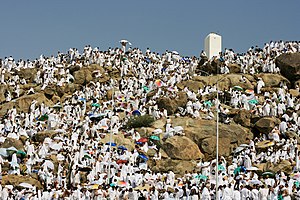
There's a lot you can do in Mecca if you plan on sticking around for long.
Factories [ edit ]
- 21.435346 39.756497 1 The Kiswa Factory of the Holy Ka'aba . The only place in Saudi Arabia where Kiswa is traditionally made to mark the beginning of Hajj. ( updated Jan 2022 )
Museums [ edit ]
Parks [ edit ].
- 21.384002 39.876342 5 Hussainiya Park . ( updated Jan 2022 )
- 21.381195 39.877341 6 King Abdullah Garden , Al Mashair . ( updated Jan 2022 )
Buy [ edit ]
While in Mecca, many pilgrims purchase trinkets to remember their time and souvenirs to bring back to family and friends. Zamzam water is available free. It is consumed in Mecca and brought home as a souvenir.
Other items to buy in and around Mecca are: prayer mats and hats, prayer beads and perfume.
Eat [ edit ]
Being one of the most visited cities in the world, you can sample food from all over the world!
Budget [ edit ]
There is an Al-Baik Restaurant adjacent to the Sacred Mosque. You can also try the fullset-chicken with cheap price, even cheaper than KFC.
- 21.419618 39.822361 1 Five Guys , Conrad Hotel, Ibrahim Al Khalil Rd, Ash Shubaikah . A branch of the Five Guys fast food chain. ( updated Jan 2022 )
Mid-range [ edit ]
- 21.419516 39.826416 2 Faisalabad Restaurant , ☏ +966 55 202 7444 , [email protected] . Pakistani restaurant. ( updated Jan 2022 )
- 21.359783 39.792998 3 Relish Joy of Taste , ☏ +966 53 020 9000 . Lebanese restaurant. ( updated Jan 2022 )
Splurge [ edit ]
- 21.420606 39.825879 4 Al Qasr ( 10-15 minutes from Makkah Haramain train station. ), ☏ +966 12571 7888 , [email protected] . Features a wide variety cuisines: Arab, Indian, Moroccan, and Western. ( updated Jan 2022 )
- 21.4206 39.822057 5 The Oasis , The Oasis, Jabal Omar, Ibrahim Al Khalil Street ( Near Masjid Al-Haram ), ☏ +966 12 557 1234 . Serves a wide range of cuisines. SAR 250 (average price for two people) . ( updated Jan 2022 )
- 21.421784 39.822533 6 Al-Rehab Restaurant . 1pm - 11 pm . An Islamic-themed restaurant that offers a great view of Masjid Al-Haram. ( updated Jan 2022 )
- 21.421744 39.822833 7 Al-Tayebat Restaurant . 6am - 10am . A restaurant at the Intercontinental Dar Al Tawhid. Offers a great view of Masjid Al-Haram. ( updated Jan 2022 )
- 21.352921 39.895264 8 Gurkan Şef Steakhouse , ☏ +966 55 928 8684 . One of the four branches of a Turkish steakhouse chain. ( updated Jan 2022 )
Drink [ edit ]

During the Hajj, you can try some Zamzam water , which is believed to be divinely blessed. As this is Saudi Arabia, the sale and consumption of alcoholic beverages is virtually non-existent.
- 21.421944 39.822447 1 Zamzam Cafe . 9AM–1AM . A cafe at the Intercontinental Dar Al Tawhid. You can enjoy cold drinks, tea, coffee accompanied by lovely snacks on the side. ( updated Jan 2022 )
Sleep [ edit ]
Mecca has a plethora of hotels. Prices vary depending on the hotel's proximity to the Holy Mosque. Some of the world's greatest hotels are situated in Mecca, and are full year-round. Make sure to book early, as soon as you know your dates of travel.
- 21.421784 39.822533 2 Intercontinental Dar al Tawhid Makkah ( The Inter-Continental ), Ibrahim Al Khalis St ( Just Outside of Mecca ), ☏ +966-2-541-1111 .
- 21.42328 39.819759 4 Hilton Makkah Convention Hotel , ☏ +966 12 526 0000 . Offers majestic views and is close to Masjid Al-Haram. ( updated Jan 2022 )
- 21.402013 39.878921 5 Park Inn by Radisson Makkah Aziziyah , 2516 Al Masjid Al Haram Road AlMursalat District , ☏ +966 1255 99100 . ( updated Jan 2022 )
- 21.419163 39.823975 6 Swissôtel Al Maqam , King Abdul Aziz Endowment , ☏ +966 (12) 577 5888 , [email protected] . ( updated Jan 2022 )
- 21.381127 39.874021 7 Four Points by Sheraton Makkah Al Naseem , Third Ring Road, Al Naseem District at Al Rajhi Mosque , ☏ +966 12 550 8999 . ( updated Jan 2022 )
- 21.420067 39.824648 8 Pullman Zamzam Makkah , Abraj Al Bait Complex, King Abdel Aziz Endowment , ☏ +966 15715555 , [email protected] . Located in the Abraj Al Bait complex, adjoining Masjid Al-Haram. ( updated Jan 2022 )
Stay safe [ edit ]
Mecca in general is a safe city, but one should take extra precautions during the annual Hajj pilgrimage.
The various safety tips found in the Saudi Arabia article will come in handy. Refer it to often to stay out of trouble.
Overcrowding and stampedes [ edit ]
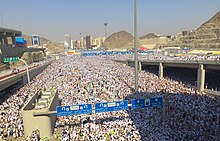
Overcrowding and stampedes are not unusual in Mecca . Since the development of air travel, pilgrims have been able to access the city much easily than before (earlier people used to travel to Mecca by boat or by other means), and as a result, the city's capacity can be completely overwhelmed.
If you're travelling with family members or with a friend, stick together . Supervise your children (if you have any) closely to make sure they are close to you and are not lost among the crowd.
In September 2015, approximately 2,236 pilgrims were trampled upon and killed in Mina, an incident regarded as the worst ever stampede in the city. The stampede drew extremely strong responses from Muslim-majority countries, with some blaming the Saudi government for being negligent and downplaying the severity of the incident, and the Iranian government (Iran had the highest casualty toll in the stampede) was angered to such a great extent that they went as far as banning their citizens from performing the Hajj in 2016.
Extreme weather [ edit ]
Mecca has a hot desert climate and temperatures regularly reach as high as 50°C (120°F) during the summers.
As is the case throughout the Middle East , always check weather conditions and hydrate often; you can very easily get exhausted, lethargic, and dehydrated if you do not take the necessary precautions.
Pickpocketing [ edit ]
There are many dishonest people and groups that often try to take advantage of the Hajj pilgrimage and/or the Umrah to deprive people of their personal property. You should not assume that Mecca only attracts the honest.
When traversing through the crowds, keep your valuables safe. Err on the side of safety and don't take any unnecessary risks. If you have been the victim of theft, call the police. Saudi authorities treat theft very seriously, largely because of a zero-tolerance justice system.
Construction-related accidents [ edit ]
The Saudi authorities invest heavily into construction projects designed to cater to Hajj pilgrims, and this has, on occasion, caused a few construction-related accidents.
In 2015, a crawler crane in the Grand Mosque collapsed, killing 111 pilgrims and injuring dozens of others. In the event something is being renovated or constructed, do not walk close to any construction site. Give all renovation sites a wide berth.
Female travellers [ edit ]
Since 2018, female pilgrims have spoken up about sexual abuse and harassment experienced on the Hajj. Although it is unlikely you'll experience severe harassment, don't be afraid to create a scene and don't feel the need to be polite in the event someone harasses you; no woman would be expected to put up with rotten behaviour like that.
The Hajj is time-consuming and can take a huge toll on your physical health. Many pregnant pilgrims suffer miscarriages during the Hajj. If you are expecting soon or if you are recuperating from an illness, it is strongly recommended that you postpone your trip.
Stay healthy [ edit ]
There are several hospitals in Mecca.
- 21.436028 39.853968 1 King Faisal Hospital , ☏ +966 12 526 3200 .
Respect [ edit ]
As the holiest city in Islam , appropriate religious prohibitions and attitudes should be in order. When you're here for either the Hajj or the Umrah, remember to eschew from the following: smoking, engaging in sexual relations, using foul language, shaving your hair and cutting your nails .
Local etiquette [ edit ]
The various respect tips found in the Saudi Arabia article are of immense help. Familiarise yourself with Saudi etiquette before entering Mecca.
Refrain from pontificating about the Saudi government's construction campaign in the city; the issue is very sensitive among some.
General etiquette [ edit ]
You are bound to meet people from all over the world. Be open to new experiences, and don't feel afraid of communicating with anyone. Approach people with a positive attitude and you are apt to make friends; a gruff, impatient attitude may generate resentment.
Photography [ edit ]
It's actually forbidden to take photographs inside the Masjid Al-Haram , but the rules are not rigorously enforced. In fact, it is quite common to see people clicking away happily with their smart phones inside the mosque. You would, however, arouse suspicion from the staff if you come in with a fancy camera.
There's some disagreement on whether or not people should take photographs inside the Masjid Al-Haram. Although some don't see it as a big deal and will happily share their photographs with others, many others consider it incredibly disrespectful .
If you feel the need to take a photo, don't engage in "touristy" behaviour (i.e. acting like you're seeing a place for the first time in forever) and don't conduct yourself in a way that would be perceived as disruptive or annoying. Always be considerate to the people around you; chances are, other people take things more seriously than you do!
Connect [ edit ]
The four mobile operators in Saudi Arabia, incumbent Al Jawal , Emirati rival Mobily , Kuwaiti Zain (Vodafone Network) and STC newcomer Jawwy [dead link] are fiercely competitive, with good coverage (in populated areas) and good prices.
You should be able to get a prepaid SMS at major airports, or at local shops nearby.
Go next [ edit ]
If you plan on spending some time in the Mecca Province, consider visiting the following cities:
- Medina — Islam's second holiest city. Unlike Mecca, Medina is open to non-Muslims.
- Taif — the unofficial summer capital of Saudi Arabia. Non-Muslims are allowed to enter.
- Jeddah — the second largest city in Saudi Arabia, known for the traditional coral houses in its old town.
- Has custom banner
- Has mapframe
- Has caution box
- Has caution box with no date
- Has map markers
- Articles with dead external links
- Guide cities
- Guide articles
- City articles
- All destination articles
- Has Geo parameter
- Pages with maps
Navigation menu
Things to Do in Mecca, Saudi Arabia - Mecca Attractions
Things to do in mecca, explore popular experiences, tours in and around mecca.

Umrah Guide

Makkah's Holy & Historical Places: Ziyarat Private Tour

Makkah City to Masjid Ayesha Taneem - Return Tour

Makkah Historical Places Private Tour ( Makkah Ziyarats )

Private Historic District Tour in Jeddah by a Local Guide

Jeddah historical Walking Tour AL-Bald

Private Historical Tour in Jeddah

Historical & Heritage Tour in Jeddah Al Balad

Discover Taif City

Guided Tour in Jeddah by local woman
Private sightseeing tours.

Top Attractions in Mecca
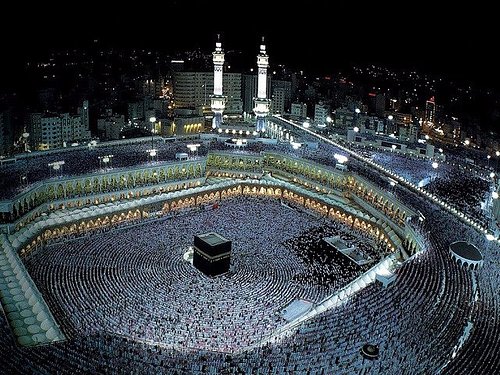
Other Top Attractions around Mecca

Tours & Sightseeing

Cultural & Theme Tours

What travelers are saying

- Great Mosque of Mecca
- Safa to Marwa
- Abraj Al-Bait Towers
- Jabal al-Nour
- Station of Ibrahim
- Masjid Taneem
- Group Enquiry? NEW
Places to Visit in Mecca
- Saudi Arabia
- Places To Visit
Tourist Places to Visit in Mecca
Here is the list of best places to visit in mecca:.
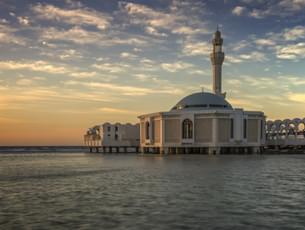
The Kaaba is one of Saudi Arabia's most beautiful and revered sites, and it is also known as the House of Allah since it is the first Qibla for Muslims. Muslims from all over the world visit the Kaaba during the Hajj pilgrimage because it houses a black stone that Muslims believe was once white but has since turned black after absorbing the sins of millions of pilgrims who have visited it over the years.
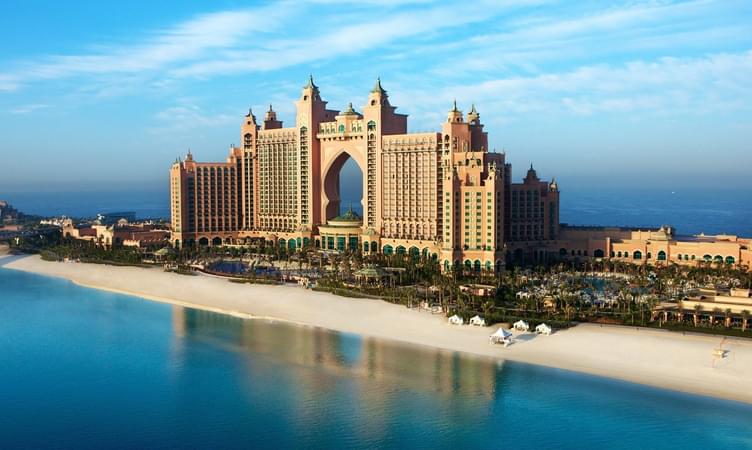
Best of Dubai

Jabal Al Nour
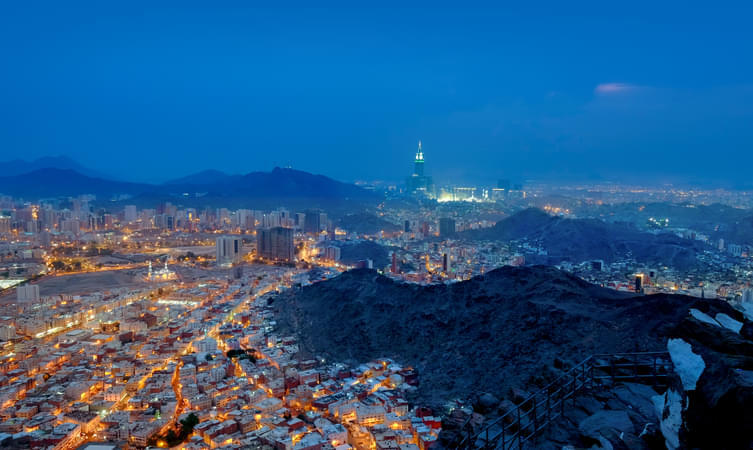
Also known as the Mountain of Light, it is the place where the Prophet is said to have meditated to receive the first revelations. It is an important religious and pilgrimage site for many muslims across the world. The mountain is roughly 620 meters and one can take up a strenuous hike to visit the peak. The unique aspect of this mountain is that it looks as if two mountains are on top of each other and the top of the mountain is a mountainous desert.
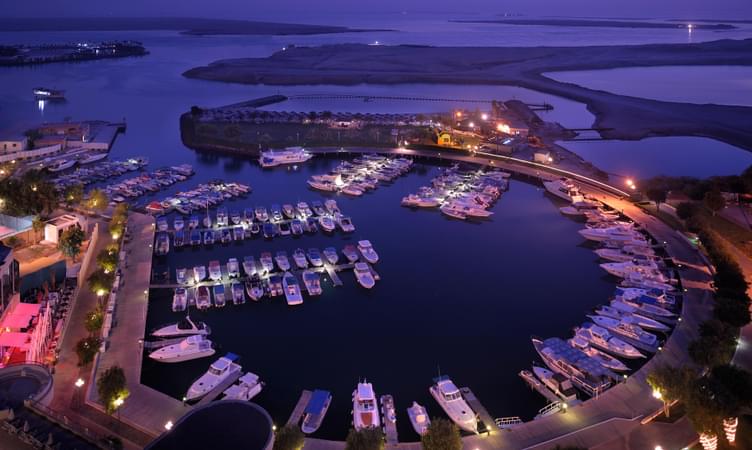
Best of Abu Dhabi

Abraj Al-Bait Tower

Abraj Al-Bait is a giant skyscraper, standing elegantly in the central area of Mecca, Saudi Arabia. The mega tall building is well known as Makkah Royal Clock and also informally called Mecca Clock Tower. The Clock Tower with a tremendous height of 601 meters (1972 feet) is recognized as the world's third tallest building after Burj Khalifa and Shanghai Tower. Nothing is more enchanting than looking up at the majestic Abraj Al-Bait Tower at night.
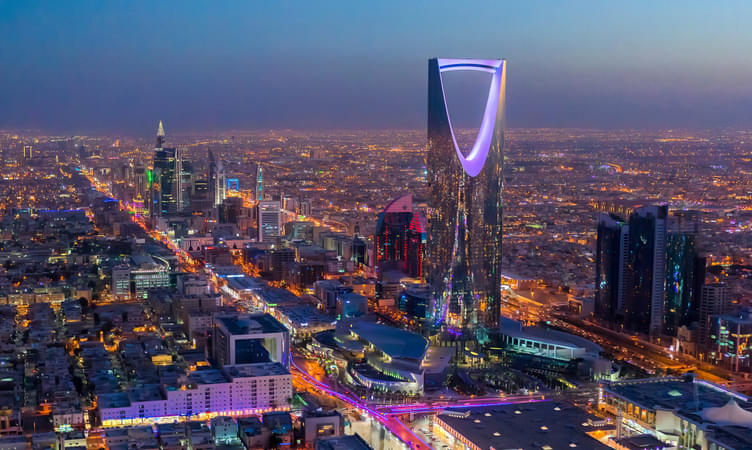
Best of Riyadh

City of Mina
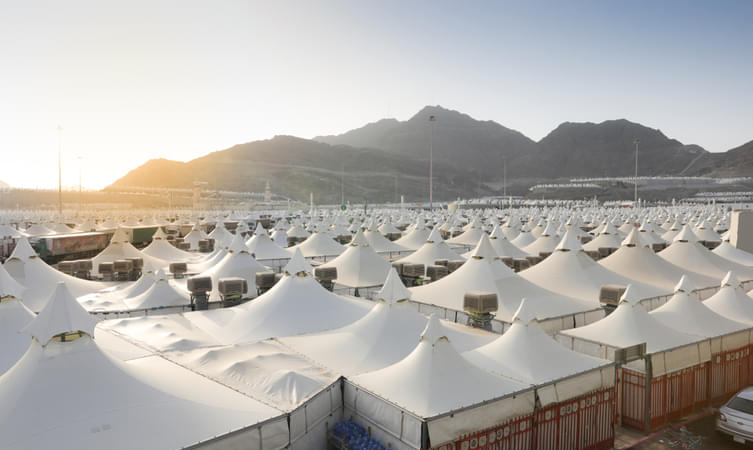
Located in the low-lying Jamarat valley in the region of Makkah, Mina happens to be the city of tents in Saudi Arabia. World’s largest tent city hosts almost 100000 tents for the increasing mass of pilgrims set out from Mecca after their seven rounds ritual at Mecca, Safa, and Murah. Explore the fascinating tent city and experience the stoning of the Devil, a ritual performed by the Hajj pilgrims on the last day of the Hajj.
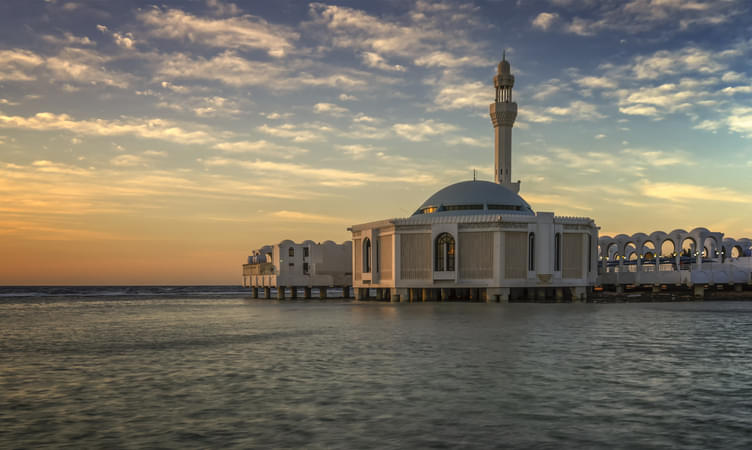
Best of Jeddah

Makkah Museum
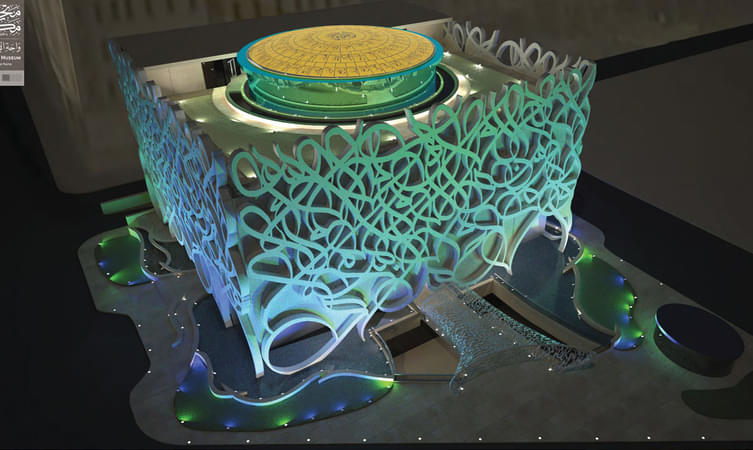
Makkah Museum is the historic center of Muslim pilgrimage that welcomes thousands of pilgrims for thousands of years. The historic Museum houses rare artifacts, fascinating collections, and displays that showcase the culture and heritage of the holy city. Take a tour around the seven main halls highlighting the Islamic civilization and explore the exhibition containing treasures and relics from the era of the Prophet Muhammad’s companions.
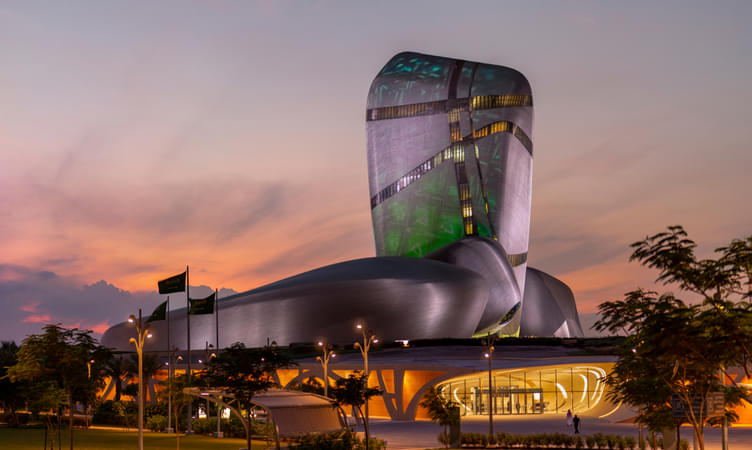
Best of Dammam

Mount Arafat
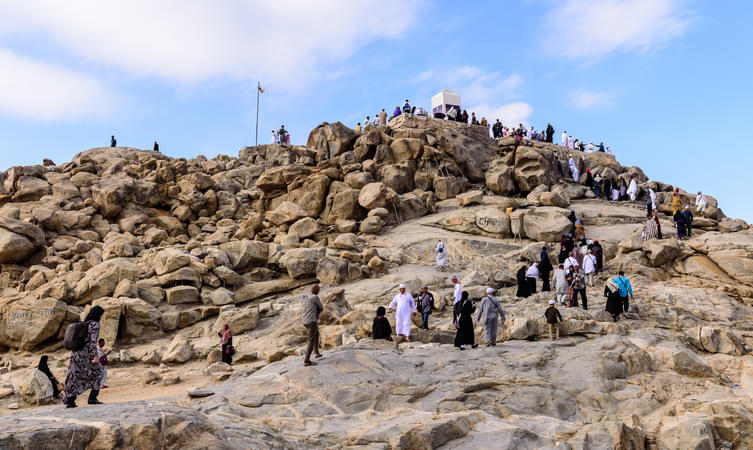
Mount Arafat is a granodiorite hill with a splendid height of approximately 70 m(230 ft) located about 20 km southeast of Mecca. The highest point of the mountain sits at an elevation of 454 meters above ground level and is known as the “mountain of mercy”. According to Islamic tradition, the hill is the place where the Prophet Muhammad stood with a Farewell Sermon to the Muslims who chaperoned him on the Hajj, which is also known as the Khutbat al-Wada.
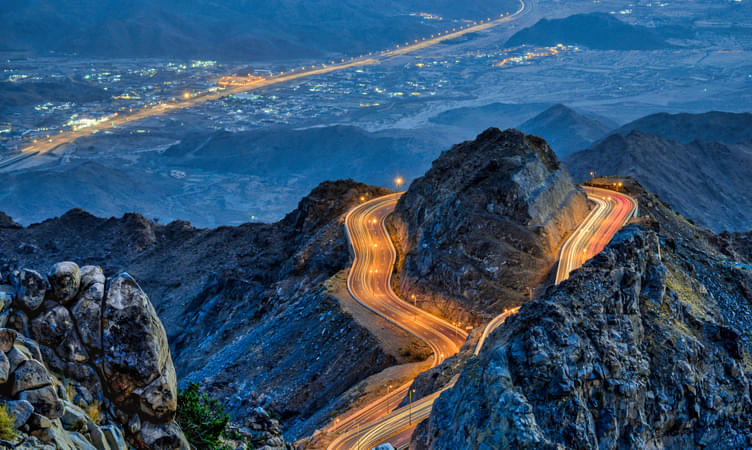
Best of Taif

Jabal Thawr Mecca
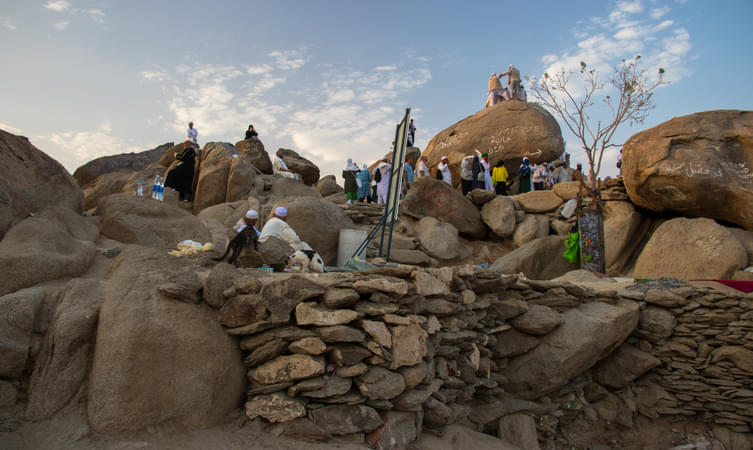
Located in the main spot of Mecca to the south of the district of MisfalahMount Thawr, Jabal Thawr Makkah is a famous holy site in Mecca, Saudi Arabia visited by many pilgrims and tourists all across the globe. The location is a mountain occupying a cave where Prophet Muhammad and his companion Abu Bakr hid for three days and three nights before escaping to Medina.
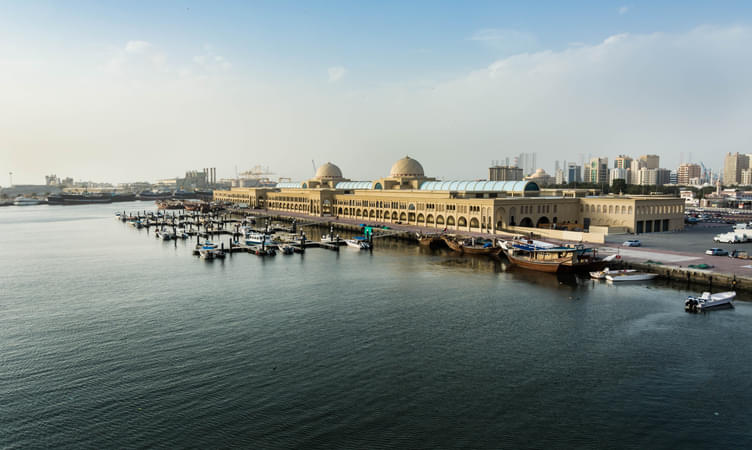
Best of Al Jubail
Jamaraat bridge.
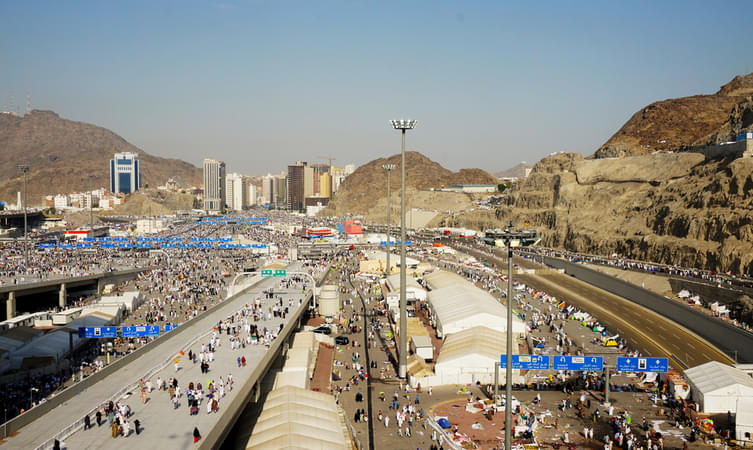
Jamarat Bridge is a pedestrian bridge sited in the city of Mina just east of Mecca. The bridge is one of the holy places which is populated annually by Muslim pilgrims to perform Islamic Hajj. During the ritual named “Stoning of the Devil,” you’ll witness pilgrims striking the Big Jamarah or Al-Jamrah al-Aqaba with seven pebbles. The stoning of the Jamarat represents the spiritual significance of man’s self.

Best of Al Kharj

Clock Tower Museum Mecca
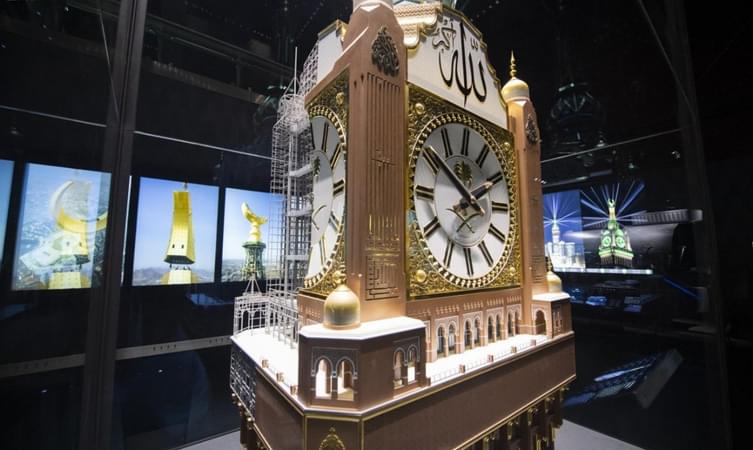
Clock Tower Museum Mecca is the museum located at the most peak point in Makkah, occupying the top four floors of the Abraj Al-Bait clock tower. The Mecca Clock Tower Museum is a unique location possessing the most different motifs and quirky features. Wander around the four different floors, each of them containing exciting things to see.
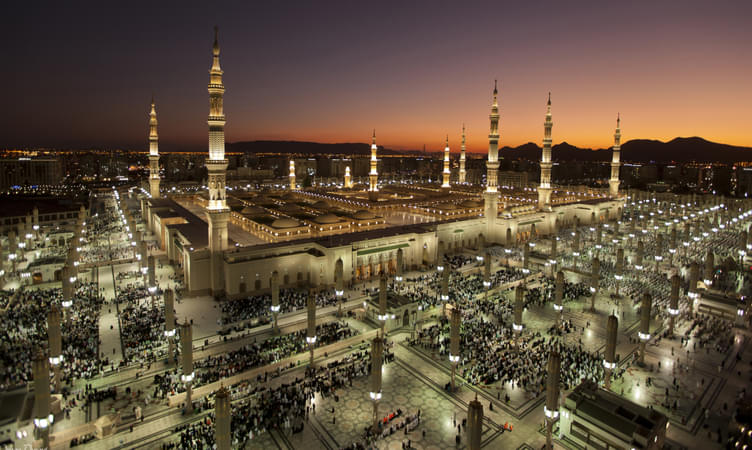
Best of Medina

Masjid Ayesha Miqat For Makkah
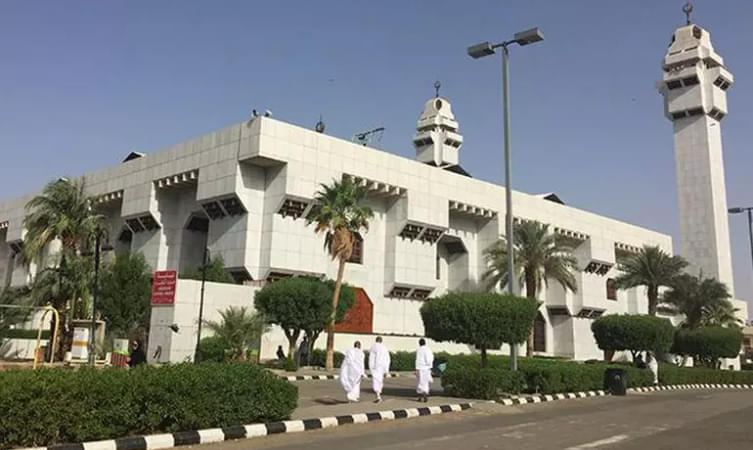
While in Mecca, don’t miss having a special tour of the most popular destination for pilgrims, especially for locals who are urged to begin their Hajj or Umrah journeys. Since Muhammad’s wife Ayesha had put her Ilham from this place, the mosque is also known as Masjid-e-Ayesha. You should go to the Masjid-e-Ayesha and indulge in the beautiful mosque with a peaceful and tranquil environment.
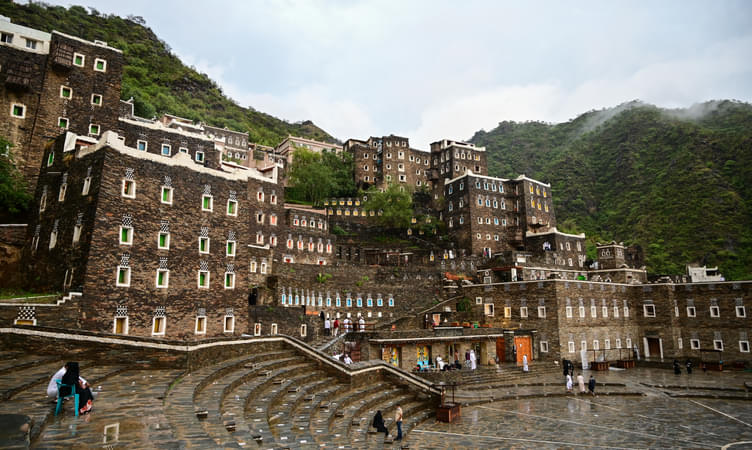
Best of Abha

Al Hukair Funland Mecca
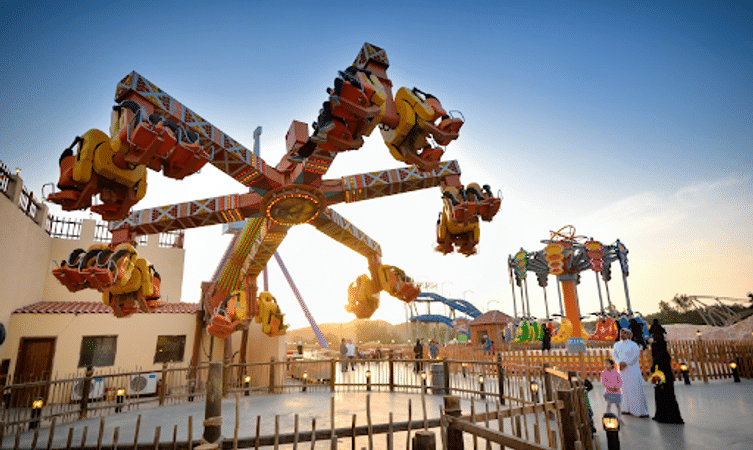
Hop on the indoor amusement park named Al Hokair Funland Mecca and get indulge in the park filled with a potent mix of lights, sounds, and children rides. Being one of the top entertainment hubs in Makkah, this amusement park is home to a large number of exciting games, ice skating halls segregated between internal and outer squares.
Elephant Rock Mecca
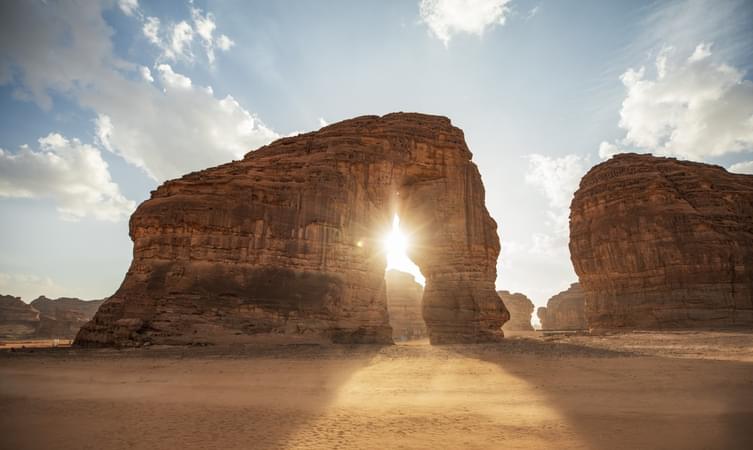
Set in the golden desert sands, The Elephant Rock is one of the most significant rocks in Maiden Saleh which is a highly recommended attraction to pay a visit if you’re at Maiden Saleh. You should definitely visit the giant beauty of the rock formation that stood elegantly in the middle of the desert. The name itself justifies its structures which are naturally formed like an elephant with a ground-bound trunk adjoining other hundreds of rock monoliths.
Globe Roundabout
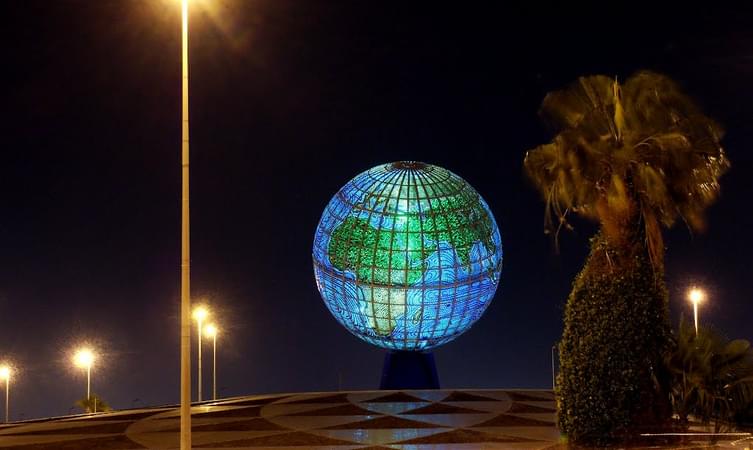
Globe Roundabout is a 1.7-mile route located near Jeddah, Makkah Region, Saudi Arabia which has the best walking trails scattered across the city. While visiting the eye-catching globe, you’ll also pass through other awesome breathing sights along the way to the last traffic circle. Have a great time witnessing the colossal glass and steel monument, Globe Roundabout surrounded by the traffic circle and a pleasing atmosphere.
Bicycle Square (Midan Addarajah)
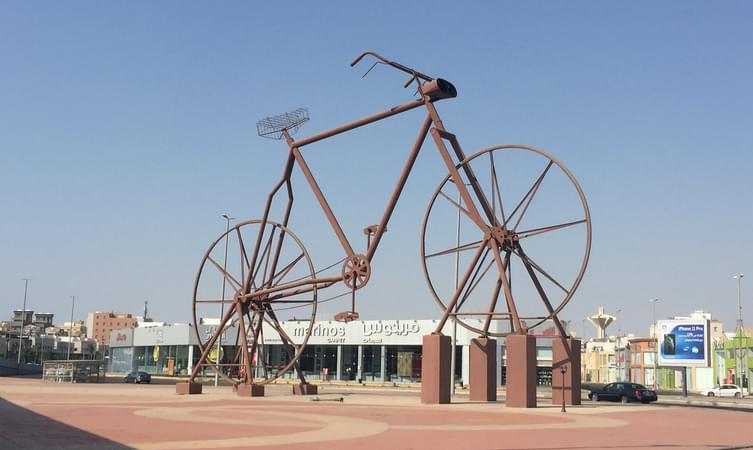
Pay a visit to a monumental Bicycle square(Midan Addarajah) one of Jeddah’s many spacious and artistic roundabouts, a popular attraction due to its enormous bicycle structure. Click photos of the massive art piece of the bicycle and admire its art created by Spanish artist Julio LaFuente. At night the sculpture has a different charm as it is illuminated by glittering lights.
Great Mosque of Mecca - Masjid al-Haram
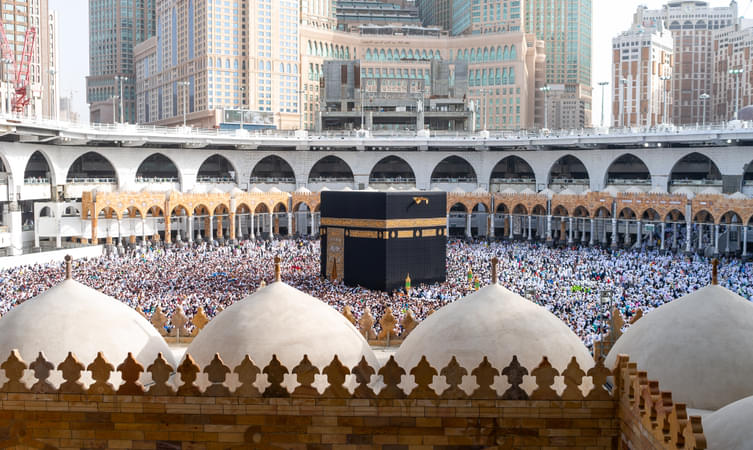
The Great Mosque of Mecca surrounds the Kaaba and is a site of main pilgrimage amongst the Islamic world and houses some important structural elements of religious importance such as the Black Stone, the Zamzam well, Maqam Ibrahim and the hills of Safa and Marwa. This mosque also holds the title of being the largest mosque in the world as well as the title of being the eighth largest building in the world.
People Also Ask About Mecca
Which are the best mosques to visit in mecca.
- Masjid Al-Haram: The biggest Mosque in the world, Masjid Al Haram, has to be on your bucket list of Places to see in Mecca. Known to be the focal point for all Muslims, the Mosque houses the famous Kaaba. Other sacred sites located in its courtyard include the Zamzam holy well and the station of Abraham.
- Masjid Ayesha: Another important mosque that you can include in your list of places to visit in Mecca is Masjid Ayesha, which every Hajj and Umrah pilgrims visit to enter into the state of Ihram. Named after t the Prophet Muhammad’s wife Ayesha, the beautiful mosque will offer you a peaceful ambiance to enjoy.
- Nimra Mosque: One of the famous places to visit in Makkah is Nimra Mosque where Mohammed had delivered his Farewell Sermon. Hajj pilgrims visit this place on the ninth day of the Islamic month of Dhu al-Hijjah.
- Al Khayf Mosque: Visit one of the oldest mosques in Makkah which is located at the foot of a mountain in Mina, near the smallest jamara, one of three walls used for the ritual stoning of the devil. During their stay at Mina, haj pilgrims pray at this mosque.
Which are the best things to do in Mecca?
- Pray At Al-Haram: One of the Places to visit in Mecca is Al-Haram, the Holy Mosque, which houses the Kaaba. While visiting this holy place, you may opt to offer your prayers to this sacred site.
- Go on an Excursion: A popular excursion which you can embark on is to Ghar Al Thawr (Cave of the Bull) on mount Al Thawr. Feel thrilled as you climb on steep and rocky terrains and pass sculptured boulders on your way to this century-old cave.
- Hike Jabal Al-Nour: Go on a hike on this hill which is known as “The Mountain of Light” or “Hill of Illumination” to reach Hira, a cave. The prominence of this hill lies in this cave where Prophet Muhammad meditated for long and received his first revelation from God by the archangel Gabriel.
- Try Different Cuisines: You will get the taste of several international cuisines in this holy city with Muslim immigrates from around the world making this city their home. You can try some traditional Saudi dishes such as Kasbah and Rice Biryani. You may opt for some spicy street eats from Southeast Asia or try some authentic Pakistani cuisine such as lamb curry etc.
- Indulge in shopping: One of the Mecca tourist attractions is the ancient shopping destinations such as ancient street markets, souks, and Old City Bazaars. Feel excited shopping for beads, perfumes, and clothing at these places.
Which are the best places to stay in Mecca?
- Al Kiswah Towers Hotel: Enjoy your stay in the conveniently located Al Kiswah Tower Hotel located only 1 km away from Abraj Al Bait and 900 m from Masjid Al Haram. Enjoy amenities such as free parking and free wifi while staying in this hotel.
- Hilton Makkah Convention Hotel: Delight in the majestic view of the holy city of Makkah while staying at Hilton Makkah Convention Hotel. Have delicious cuisines at the hotel’s three different restaurants and buy souvenirs at its gift shop. If you are a fitness freak, you will love to continue your workout regime at the fitness center.
- Swissotel Al Maqam Makkah: Standing in the heart of the holy city is the Swissotel Al Maqam Makkah. Situated in the famous Abraj Al Bait complex, the hotel faces the holy Kaaba and has direct access to the holy mosque. Relish your stay in this hotel’s luxurious rooms and suites and enjoy a selection of oriental and international cuisines at its restaurant, Al Khairat restaurant, and unwind at the end of the day at Masharif tea lounge.
- Conrad Makkah: Get treated with world-class luxury during your stay at Conrad Makkah. Located just steps away from the Holy Mosque and Kaaba, this hotel will delight you with its spacious and modern rooms with separate dressing rooms and complimentary wifi. Savor international dishes and Arabic specialties at the all-day dining restaurant, Al Mearaj.
How do I get to Masjid al-Haram from the Clock Tower Museum Mecca?
Is it worth visiting mecca, what is the best time to visit mecca, how far is makkah from medina, popular related destinations.
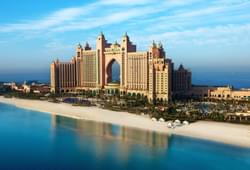
Best Domestic Packages
Best international packages, domestic honeymoon packages, international honeymoon packages, places to visit in india, international places to visit, things to do in india, international things to do, popular on thrillophilia.
- We assure the privacy of your contact data.
- This data will only be used by our team to contact you and no other purposes.
Your enquiry has been received successfully. Our destination expert will reach out to you soon!
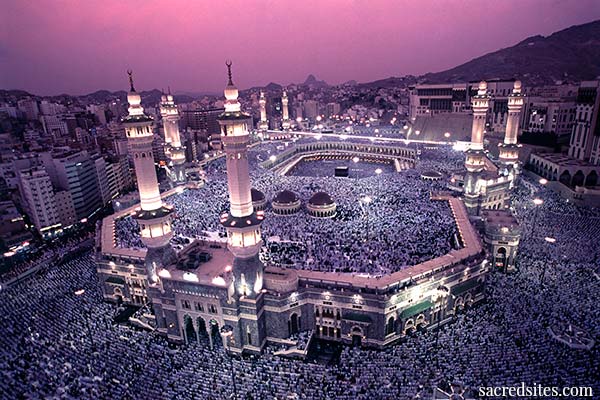
Mecca ( Makkah in Arabic) is the center of the Islamic world and the birthplace of both the Prophet Muhammad and the religion he founded. Located in the Sarat Mountains of central Saudi Arabia and 45 miles inland from the Red Sea port of Jidda (Jeddah), ancient Mecca was an oasis on the old caravan trade route that linked the Mediterranean world with South Arabia, East Africa, and South Asia. By Roman and Byzantine times it had developed into an important trade and religious center, and was known as Macoraba. The sacred land in which Mecca and Medina are located, known as the Hijaz, is the western region of the Arabian peninsula, a narrow tract of land about 875 miles long east of the Red Sea with the Tropic of Cancer running through its center. The land is called Hijaz, meaning barrier, because its backbone, the Sarat Mountains consist of volcanic peaks and natural depressions creating a stark and rugged environment dominated by intense sunlight and little rain fall.
According to ancient Arabian traditions, when Adam and Eve were cast from Paradise they fell to different parts of the earth; Adam on a mountain on the island of Serendip, or Sri Lanka, and Eve in Arabia, on the border of the Red Sea near the port of Jeddah. For two hundred years Adam and Eve wandered separate and lonely about the earth. Finally, in consideration of their penitence and wretchedness, God permitted them to come together again on Mt. Arafat, near the present city of Mecca (previously called Becca or Bakkah, meaning narrow valley). Adam then prayed to God that a shrine might be granted to him similar to that at which he had worshipped in Paradise. Adam's prayers were answered and a shrine was built. (This is a pre-Islamic legend and the Koran, the Islamic Holy Scripture, says nothing whatsoever of Adam's connection with Mecca or of a shrine he prayed at). Adam is said to have died and been buried in Mecca and Eve in Jeddah by the sea which still bears her name, jiddah, meaning maternal ancestor in Arabic.
This shrine passed away during the era of the flood, at which time the body of Adam began to float on the water while the Ark of Noah circumambulated around it and the Ka'ba seven times before journeying north where it landed after the flood. A thousand years later, according to one Islamic tradition in 1892 BC, the great patriarch of monotheism, Abraham, or Ibrahim, came to Mecca with his Egyptian wife Hagar and their child Ishmael. Here Hagar lived with her son in a small house, at the site of the earlier shrine, and Abraham came to visit her occasionally.
Nearly all scholars trace the sanctity of Mecca to the Ka'ba edifice later rebuilt at God's express command by Abraham and Ishmael. Mention must be made, however, of the Zamzan spring and the nearby holy hills of Safa and Marwa (these hills have since disappeared under the leveling topography of modern Mecca). These geographical formations certainly predated the mythical construction of the Ka'ba and could therefore have given birth to the original sanctity of the place. According to Islamic legend, Abraham had left Mecca on God's command, leaving Hagar and Ishmael with only some water and dates. Hagar nursed her son and they drank the remaining water. Soon thereafter, faced with great thirst, Ishmael started to cry and Hagar began to run between the hills of Safa and Marwa looking for water. She repeated the journey seven times until an angel appeared to her, striking the ground with his wing, with the result that the Zamzam spring, which Muslims consider as a tributary of the waters of Paradise, sprang forth. Henceforth Mecca was graced with a source of water which has continued flowing to this day.
After the departure and return of Abraham to Mecca, and his discovery that Hagar had died, Abraham was then ordered by God to make Hagar's house into a temple where people could pray. Therefore, he demolished the house and began construction of the Ka'ba. God gave Abraham precise instructions concerning how to rebuild the shrine and Gabriel showed him the location. It is said that by the grace of God the Divine Peace (al-sakinah) descended in the form of a wind which brought a cloud in the shape of a dragon that revealed to Abraham and Ishmael the site of the old temple. They were told to construct the shrine directly upon the shadow of the cloud, neither exceeding nor diminishing its dimensions. Legends say the shrine was built from the stones of five sacred mountains: Mt. Sinai, the Mount of Olives, Mt. Lebanon, Al-Judi, and nearby Mt. Hira. Upon the completion of the shrine, Gabriel brought a magic stone for the sanctuary. Different sources speculate that this stone was a meteorite or a great white sapphire from the Garden of Eden, that it had been concealed on the nearby sacred mountain of Abu Qubays during the period of the flood, and that it was later restored to Abraham for inclusion in his version of the Ka'ba. Whatever its ultimate origin, the stone was most probably a sacred object of the pre-Islamic Arabian nomads who had settled around the Zamzam spring that flows at the center of old Mecca. Upon completion of the Ka'ba, Abraham and Ishmael, accompanied by the archangel Gabriel, then performed all the elements which constitute the Hajj ritual of today. The Ka'ba they had constructed was destined to become the most important sacred site of the nomadic tribes that inhabited the great Arabian deserts. (Abraham was later to leave Mecca to die in Palestine in al-Khalil).
With the passage of centuries, the original Abrahamic observances at the Ka'ba were progressively diluted by the addition of various pagan elements (these arriving via the caravan routes that led to Mecca). The pilgrims of pre-Islamic times visited not only the house of Abraham and the sacred stone of Gabriel but also the collection of stone idols (representing different deities) housed in and around the Ka'ba. There were said to be 360 different deities including Awf, the great bird, Hubal the Nabatean god, the three celestial goddesses Allat, Aluzza and Manat, and statues of Mary and Jesus. The most important of all these deities, and chief of the Meccan pantheon, was known as Allah (meaning "the god"). Worshipped throughout southern Syria and northern Arabia, and the only deity not represented by an idol in the Ka'ba, Allah would later become the sole god of the Muslims.
The city of Mecca achieved its major religious significance following the birth and life of the Prophet Muhammad (570-632AD). In 630 Muhammad took control of Mecca and destroyed the 360 pagan idols, with the notable exception of the statues of Mary and Jesus. The idol of Hubal, the largest in Mecca, was a giant stone situated atop the Ka'ba. Following the command of the Prophet, Ali (the cousin of Muhammad) stood on Muhammad's shoulders, climbed to the top of the Ka'ba and toppled that idol.
Following his destruction of the pagan idols, Muhammad joined certain of the ancient Meccan rituals with the Hajj pilgrimage to Mt. Arafat (another pre-Islamic tradition), declared the city a center of Muslim pilgrimage and dedicated it to the worship of Allah alone. Muhammad did not, however, destroy the Ka'ba and the sacred stone it housed. Rather, he made them the centerpiece of the Muslim religion based on his belief that he was a prophetic reformer who had been sent by god to restore the rites first established by Abraham that had been corrupted over the centuries by the pagan influences. Thus, by gaining both religious and political control over Mecca, Muhammad was able to redefine the sacred territory and restore Abraham's original order to it.
According to the original words of Muhammad, the Hajj pilgrimage is the fifth of the fundamental Muslim practices known as the 'Five Pillars of Islam'. The Hajj is an obligation to be performed at least once by all male and female adults whose health and finances permit it. The pilgrimage takes place each year between the 8th and 13th days of Dhu al-Hijjah, the 12th month of the Islamic lunar calendar. Before setting out, a pilgrim should redress all wrongs, pay all debts, and plan to have enough money for their journey and the support of their family while away.
As pilgrims undertake the journey they follow in the footsteps of many millions before them. When the pilgrim is about 10 kilometers from Mecca he enters the state of holiness and purity known as Ihram, and dons special garments consisting of two white seamless sheets that are wrapped around the body. Entering the great Mosque in Mecca, the pilgrim first walks seven times around the Ka'ba shrine in a counterclockwise direction; this ritual is called turning, or tawaf. Next, entering into the shrine, the pilgrim kisses the sacred stone. The stone is mounted in a silver frame in the wall, four feet above the ground, in the southeast corner of the shrine. It is of an oval shape about twelve inches in diameter, composed of seven small stones (possibly basalt) of different sizes and shapes joined together with cement. Legend tells that the stone (al-Hajaru al-Aswad, the 'Black Stone') was originally white but became gradually darkened by the kisses of sinful mortals (some traditions say by the sins of 'offsprings of Adam').
During the next few days the pilgrim walks a ritualized route to other sacred places in the Mecca vicinity (Mina, Muzdalifah, Arafat, the Mount of Mercy and Mt. Namira) and returns to the Ka'ba on the final day (the word Hajj probably derives from an old Semitic root meaning 'to go around, to go in a circle'). The plain of Arafat where millions of pilgrims assemble in a vast congregation symbolizes the plain of Mahshar or Resurrection where everyone will stand before God on the Day of Judgement. In the middle of Arafat stands Jabal al-Rahmah or the Mount of Mercy where the last verses of the Koran were revealed and where one of the famous farewell addresses of the Prophet was delivered. It is here that the alchemy of union between various aspects of human nature takes place and where men and women regain their primordial spiritual wholeness, for it was here that Adam and Eve found each other again after their fall to earth from Paradise. At Mina, where the Prophet delivered his last words during his final pilgrimage, pilgrims cast stones against three large stone pillars representing Satan (al-Shaytan) as a symbol of the eternal battle that must be waged against the demons within. Finally there is the sacrifice of an animal, a sheep or a camel, in emulation of Abraham's preparation to sacrifice his son Ishmael.
Once a believer has made the pilgrimage to Mecca men may add the title al-Hajji to their name, hajjiyah for females. In different Islamic countries returning pilgrims will use a variety of signs to indicate they have made the Hajj; these include painting pictures of the Ka'ba (and the pilgrim's means of transportation to the shrine) upon the walls of their homes, painting the entrance doorway of the house bright green, and wearing hats or scarves of green color. A so-called Minor Pilgrimage, known as the Umra, contains some but not all of the rites of the Hajj and may be performed at any time of the year.
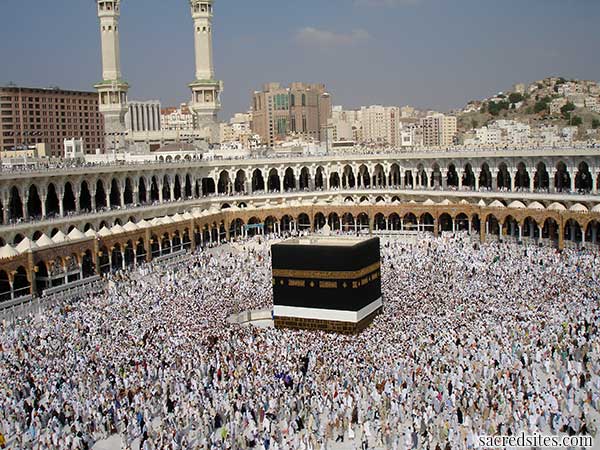
The area around the Ka'ba was enclosed by a wall in 638 to create a defined space for the tawaf ritual of circumambulation. In 684 the mosque was further enlarged and ornamented with numerous mosaic and marble decorations. In 709 the Umayyad caliph Al-Walid placed a wooden roof upon marble columns to protect the arcades of the mosque, and between 754 and 757 the Abbasid Caliph Al-Mansur carried out further enlargements, including the first minaret. During the next 700 years numerous modifications were carried out although no major alterations to the form of the building occurred until the Ottoman period in the 16th century (in the 10th century the Black Stone was actually stolen for a period of twenty-one years by the Carmathians). Large-scale renovations and remodeling was undertaken in 1564 during the reign of the Ottoman Sultan Sulayman the Magnificent, who rebuilt the minarets and replaced the wooden roofs of the arcades with stone domes. The next major rebuilding of the mosque occurred in the 20th century under the direction of the Saudi royal family and resulted in the Mecca mosque becoming the largest in the world.
The Ka'ba today stands in the midst of an open courtyard known as the al-masjid al-haram, the 'sanctuary'. The cubical (the word Ka'ba means "cube"), flat-roofed building rises fifty feet from a narrow marble base on mortared bases of a local blue-gray stone. Its dimensions are not exactly cubical: the northeastern and southwestern walls are forty feet long, while the other two walls are five feet shorter (12 meters long, 10 meters broad, 16 meters high). The structure's corners, rather than the walls, are oriented toward the compass points. The east and west walls are aligned to the sunrise at the summer solstice and sunset at the winter solstice. The south wall is directed to the rising of the bright star Canopus. The northeastern wall has the only door of the building, about seven feet above the ground level. Inside is an empty room with a marble floor and three wooden pillars supporting the roof. There are some inscriptions on the walls, hanging votive lamps, and a ladder leading up to the roof. The entire Ka'ba structure is draped with a black silk covering, called a kiswa, upon which passages from the Koran are embroidered in gold. The kiswa is renewed every year and the old kiswah is cut up and distributed so as to allow the barakah of the ka'ba to emanate among those to whom the pieces of the cloth are given. During the early centuries of Islamic history the kiswah was made in Egypt and carried with great ceremony to Mecca but now it is fashioned near the holy city itself.
Opposite the northwestern wall of the Ka'ba is an area of special sanctity called the Hijr, which Muslim tradition identifies as the burial place of Hagar and Ishmael (and here, too, Ishmael had been promised by God that a gate into heaven would be opened for him). In Muhammad's time, the Hijr was a place used for discussion, prayer and, significantly, for sleep. The sleepers in the Hijr appear to have gone there specifically to have dreams of divine content: Muhammad's grandfather, Abd al-Muttalib, was inspired to discover the Zamzam well while sleeping there; the mother of the Prophet had a vision of her son's greatness; and at the Hijr Muhammed himself was visited by Gabriel before beginning his miraculous Night Journey to Jerusalem.
The Ka'ba, the Zamzan well, the Hijr and the hills of Safa and Marwa are now all enclosed in a vast structure called the Haram al-Sharif, 'The Noble Sanctuary'. Ringed by seven towering minarets and sixty-four gates, this truly monumental building has 160,000 yards of floor space, is capable of holding more than 1.2 million pilgrims at the same time, and is the largest mosque in the Islamic world. The sa'y, or ritual walk between the hills of Safa and Marwa, celebrating the rapid movement of Hagar and her son Ishmael in search of water and being an integral part of the Hajj rituals, is understood to represent man's quest in this world for the life-bestowing bounties of God.
It is interesting to note that prior to the age of the European world explorations, the pilgrimage to Mecca was the single largest expression of human mobility. As the religion of Islam rapidly spread across the world from Indonesia and China in the Far East to Spain, Morocco and West Africa in the west, ever increasing numbers of pilgrims made the long, and often dangerous, journey to Mecca. Some came by boat, braving the Red Sea, the Black Sea, the Mediterranean Sea, the Arabian Sea and the Persian Gulf. Others spent months in camel caravans slowly crossing great tracts of land. The most important pilgrimage caravans were the Egyptian, the Syrian, the Maghribi (the trans-Saharan route), the Sudanese (the sub-Saharan, savanna route), and those from Iraq and Persia.
Forbidden to persons not of the Muslim faith, Mecca came to symbolize for Europeans the secrets and mysteries of the orient, and as such became a magnet for explorers and adventurers. A few of these daring travelers, such as John Lewis Burckhardt from Switzerland (who, in 1812, was also the first European to visit the ruins of Petra) and Sir Richard Burton from Great Britain were able to convincingly impersonate Muslim pilgrims, gain entrance to Mecca, and write wonderfully of the holy city upon their return to Europe. Other explorers were neither so lucky nor divinely guided; many of them disappeared or were caught and sold into slavery. To this day, Mecca remains strictly closed for persons not of the Muslim faith.
Nowadays approximately 2,000,000 people perform the Hajj each year, and this pilgrimage serves as a unifying force in Islam by bringing together followers from diverse countries and language groups. In a certain sense, however, Mecca is said to be visited by all devout and practicing Muslims every day. This is because five times each day (three times in the Shi'a sect) millions upon millions of believers perform their prayers (bowing and prostrating in a specific sequence of movements) in the direction of Mecca. Wherever the place of prayer - in a mosque, a remote place in the wilderness or the interior of a home - Muslims face towards Mecca and are united to the Ka'ba by an invisible line of direction called the qibla.
Readers interested in more detailed information about Mecca and the great Muslim pilgrimage will enjoy the excellent writings of Michael Wolfe and F.E. Peters, listed in the bibliography. The two other most important sacred sites for Muslims are the Prophets Mosque in Medina and the Dome of the Rock in Jerusalem .
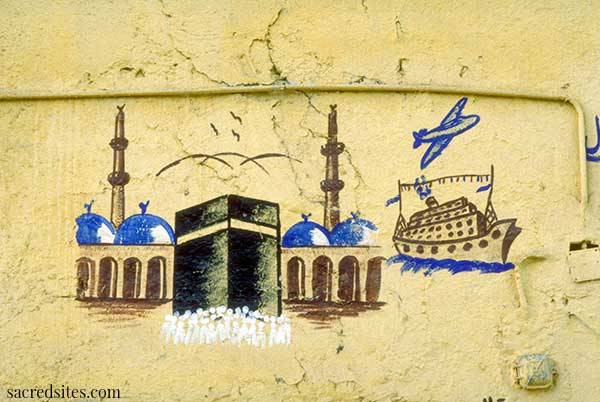
Additional notes on Mecca
On the walls of ordinary houses all over Egypt, one can still see colorful two-dimensional mementos of the sacred journey to Mecca. A lively tradition of domestic mural painting has preserved a formulaic combination of inscriptions and images of the Ka'ba and of the Prophet's mosque. Images usually show the various modes of travel to the holy places, typically including planes, trains, ships, camels, and often depict the pilgrim on a prayer carpet. These murals serve a protective purpose in addition to certifying publicly and proudly that the house's inhabitants are due the special status and prestige accorded to those who have accomplished the hajj and received the honorific title of hajji . It is especially significant that family and friends of the pilgrim execute the paintings while the travelers are away, so that the dwelling undergoes its ritual transformation even as its inhabitants do.
Seven Doors to Islam: Spirituality and the Religious Life of Muslims , by John Renard
Folklore notes on Adam
Adam was formed by god out of a handful of dust taken, according to tradition, from the Holy Rock of Sakhrah in Beyt el Maddas. When god formed Adam He left the figure lying lifeless for forty days, some say forty years, while notice was given to the Angels and the Jinn to be ready to worship him as soon as god put breath into his nostrils. At first Adam was male and female in one body, man on one side and female on the other. In due time the female part separated from the male and became a complete woman. Adam and the woman mated but they were not happy as the female refused to submit to Adam, saying that as they were made from the same dust, he had no right to order her about. So she was turned out of Paradise and, consorting with Iblis (Satan), became the mother of devils. She is called El-Karineh by the Arabs, both Christian and Muslim, and Lilith by the Jews (La Brusha by the Sephardim Jews). She is the deadly enemy of all women, especially those who have recently become mothers. When El-Karineh was driven out of Paradise, god created Eve out of one of Adam's ribs, which had been extracted while he slept. Adam and Eve were happy together until Satan succeeded in getting back into Paradise concealed in a serpent's fangs. Once there, Satan persuaded Eve to eat of the forbidden fruit. Adam, having been persuaded by his wife to share her offense, was, as a punishment, cast out of Paradise together with Eve, Satan and the Serpent. All four of them fell to the earth, each coming to a different place: Adam at Serendib or Ceylon; Eve at Jiddah; Satan at Akabah; and the Serpent at Isfahan in Persia. Two hundred years passed before Adam and Eve met once more at Jebel Arafat, the mountain of Recognition, near Mecca. During these two hundred years, Eve had borne offspring of the seeds of devils and Adam had many children by female Jinns.
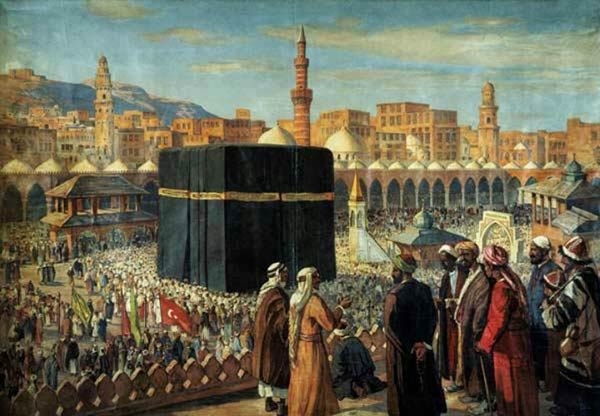
Additional notes on Pilgrimage and Sacred sites in Islam
The worship of saints or even of the Prophet Muhammad himself is blasphemy according to Islamic orthodoxy. When Muhammad died, he was buried in the house of his wife Aisha and it was forbidden to visit his corpse. In accordance with his teachings, no special treatment was given to the burial places of the four rightly guided Caliphs or the Umayyads or early Abbasids, and no special buildings of any importance were erected over any of their graves.
After the ninth century the veneration of tombs of pious men became popular, especially in eastern Iran, and the memorial tomb with religious or secular connotations assumed a leading place among the types of monumental buildings in Islamic architecture. Clearly the urge to build tombs owed nothing to Islamic dogma but rested on deep-seated popular belief.
The grave of a saint (awliya) is a point of psychic contact with the saint for the tomb is conceived as the dwelling place of the saint. These shrines, in different parts of the Islamic world may be called mashhad, maqam, ziyarat (Morocco), imamzada (Iran), mazar (Central Asia) and qabiristan (India) and they may be compared in function to the Christian martyrium.
Apart from the altruism involved in building a mosque, anyone who plans to include his tomb within the area of the mosque expects that this action will ensure the maintenance of his tomb, as it is integral to the architecture of the mosque, and also that his burial remains will benefit supernaturally from the prayers of the users of the mosque and also by the baraka that is generated every time the Koran is recited.
The concept of the living saint is extremely important in Islam. Pilgrims visit the shrine of a saint to receive his baraka and seek his intercession, shafa'a. .. On leaving a shrine, a pilgrim is careful not to turn his or her back on the cenotaph of the saint.
A coffin is optional, but a vault, no matter how simple, is indespensible, for the fact that the body must be able to sit up and reply to the Angels of the Grave, known as Munkir and Nakir, who question it on the first night after burial. ..Bodies are buried in the recumbent posture at right angles to the qibla (the direction of prayer towards Mecca) in such a way that they would face Mecca if turned on their side. This way the believer has the same physical relationship with Mecca in both life and death.
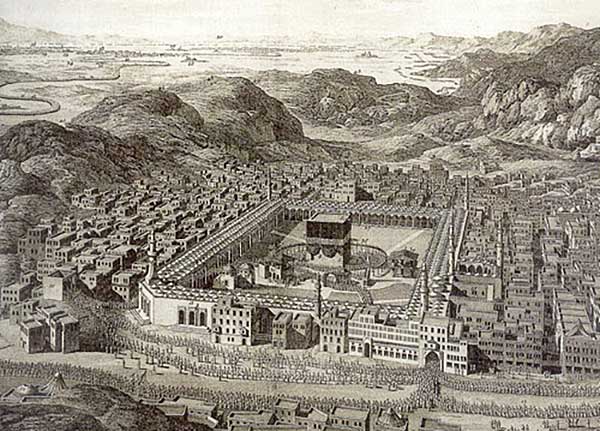
Also consult:
Non-Hajj Pilgrimage in Islam: A Neglected Dimension of Religious Circulation ; Bhardwaj, Surinder M.; Journal of Cultural Geography, vol. 17:2, Spring/Summer 1998
Sufism: Its Saints and Shrines: An Introduction to the Study of Sufism with Special Reference to India ; Subhan, John A.; Samuel Weiser Publisher; New York; 1970

- Global Sacred Sites List
- Introduction to Sacred Places
- New and Updated
- South Africa
- Dom. Republic
- United States
- Afghanistan
- North Korea
- Philippines
- South Korea
- Turkmenistan
- Netherlands
- Switzerland
- Saudi Arabia
Mecca is only accessible by Muslims, who often describe the moment they first lay eyes on the city's sacred Kaaba as an overwhelmingly emotional experience. For those living outside the Kingdom, a visit to Mecca – generally spelt 'Makkah' by Muslims and in Saudi Arabia – is a lifelong dream. Coming here to perform the hajj pilgrimage is a religious obligation for all Muslims who are financially and physically able to do so.
Attractions
Must-see attractions.

Al Masjid Al Haram
The focal point for every Muslim and the biggest mosque in the world, Al Masjid Al Haram is able to host a million worshippers and covers an area of 356…

Exhibition of the Two Holy Mosques
This little museum is brimming with relics from the two holy mosques, Al Masjid Al Haram in Mecca and the Prophet's Mosque in Medina. These include…

Cave of Thor
This small mountain (761m) is where the Prophet hid for three days with his companion Abu Bakr from the Quraysh tribe. According to Islamic custom, an…

Jabal Al Nour
The 640m-tall Jabal Al Nour is the location of the tiny Hira cave and one of the most important Islamic pilgrimage sites. According to Islamic tradition,…

Jabal Rahmah
Also known as the Mountain of Mercy, this granite hill is an important part of performing the hajj as pilgrims leave Mina for Arafat on the ninth day to…

Makkah Museum
Formerly Al Zahir Palace, the 3435-sq-metre Makkah Museum has a collection ranging from images of Saudi Arabia’s important archaeological discoveries to…

Jannat Al Muallaa Cemetery
Many of the Prophet’s family are buried here, including his first wife, Khadija, his sons Qasim and Abdullah, his uncle, Abu Talib, and his grandfather,…

Masjid Al Bay'ah
These remnants of Masjid Al Bay'ah mark the spot where tribal leaders pledged their allegiance to Muhammad in AD 621. Simple in design, an arched entrance…
Latest stories from Mecca
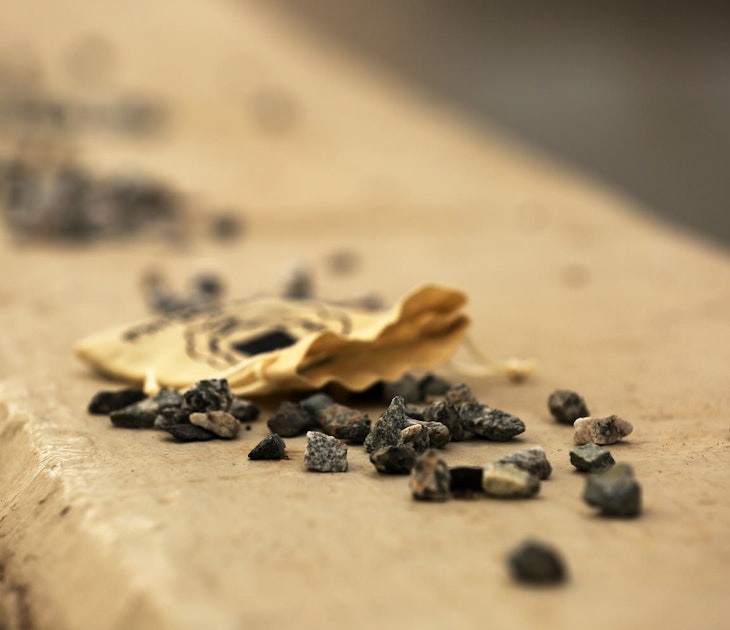
Festivals & Events
Sep 20, 2019 • 6 min read
Lonely Planet writer Tharik Hussain takes us through the most daunting chapter of his Hajj experience yet, the jamarāt (ceremony of ‘stoning the devil’).
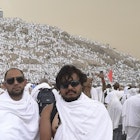
Sep 6, 2019 • 5 min read
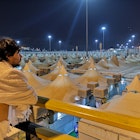
Aug 26, 2019 • 6 min read
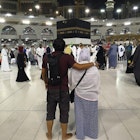
Aug 9, 2019 • 5 min read
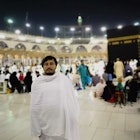
Aug 6, 2019 • 4 min read
in partnership with getyourguide
Book popular activities in Mecca
Purchase our award-winning guidebooks.
Get to the heart of Mecca with one of our in-depth, award-winning guidebooks, covering maps, itineraries, and expert guidance.

What to Know Before Visiting Mecca
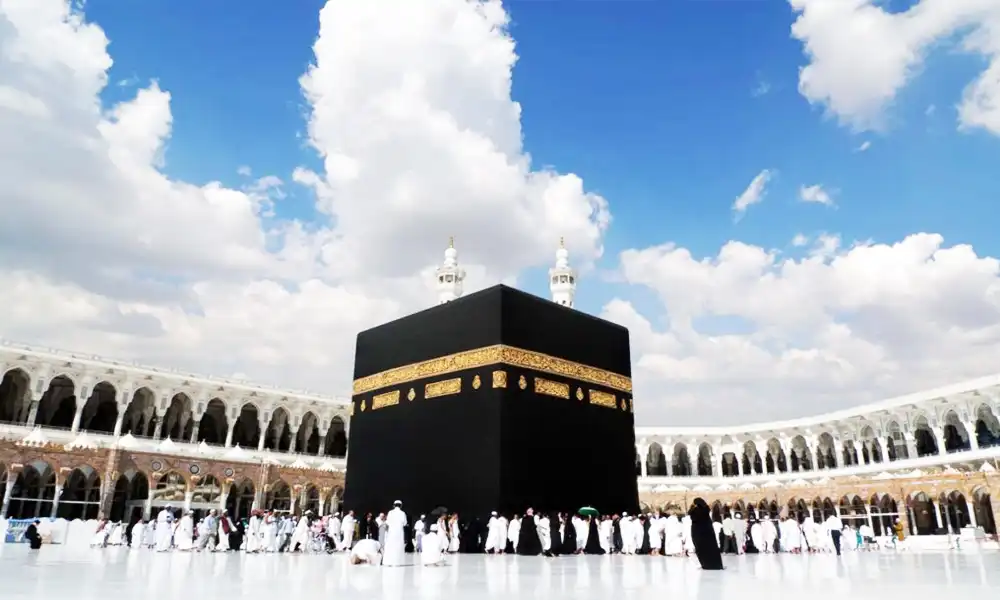
The most important city in Muslim culture, Mecca is a unique place in the world. Here’s what you need to know if you’re going for the Hajj.
The central spot in the world for all Muslims, Mecca is a city that’s always closed for non-believers. In fact, traveling there as a Christian is punishable by law, and transgressors are promptly fined and deported.
However, there are certain details even Muslim visitors should know before coming to the holiest site of Islam.
1. When to Come
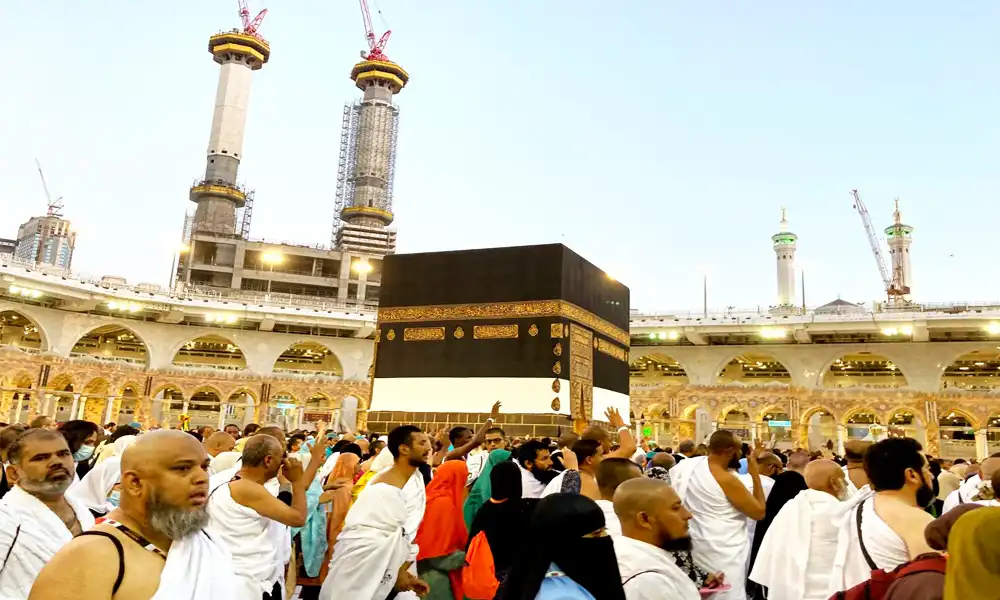
For Muslims worldwide, visiting Mecca is obligatory if they are physically and financially able to make the journey. However, not all months of the year are equal when it comes to the Hajj.
The pilgrimage is most valid if performed during the Islamic month of Dhu al-Hijjah, which can be translated as the month of pilgrimage.
Since the Islamic calendar is lunar, the year is about 12 days shorter than the regular solar year. This means that the months shift around and need to be calculated for each year. For example, the month of pilgrimage in 2021 starts on July 11, but it begins on June 30 the following year.
Luckily, visiting Mecca outside the designated period isn’t forbidden. But it doesn’t score as high and is only considered a minor pilgrimage.
2. How to Get There
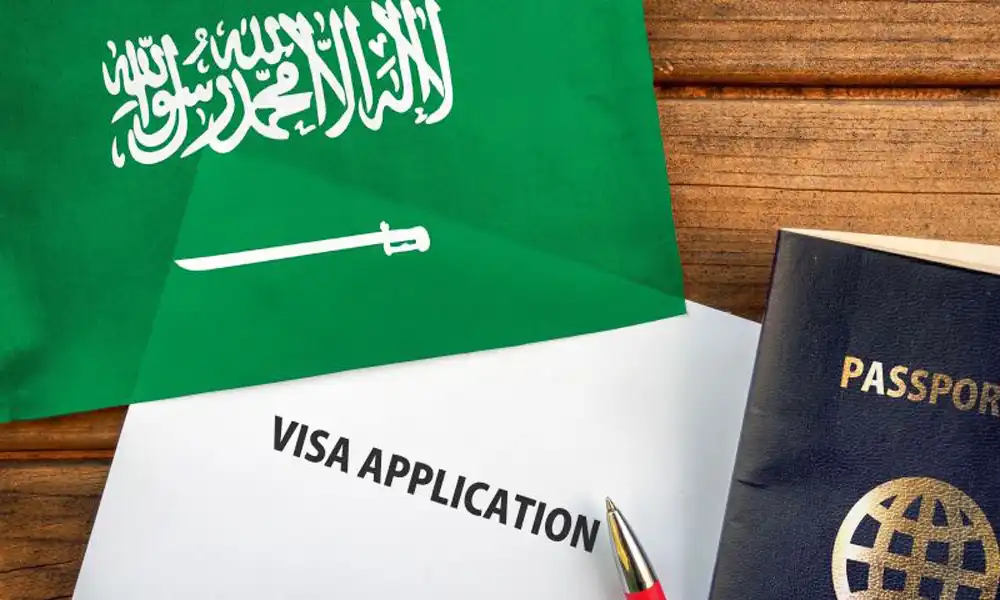
There are special visas issued by Saudi Arabia for those who want to make the pilgrimage. The paperwork involved is quite daunting, which is why many Muslims resort to hiring travel agencies to take care of all the necessities.
As expected for Saudi Arabia, women can’t travel alone but must be escorted by a man. The exceptions to this are women over 45 who are traveling as part of a group. But they must have consent signed by a man even then.
Once you get the paperwork in order, you can fly to Jeddah where there’s a dedicated airport terminal for those coming for the Hajj. From the city, you can take a bus, train, or travel by car to Mecca.
If you’re driving there, non-Muslims can get to the Christian bypass that’s located several miles outside Mecca and they’ll get stopped at the checkpoint. Meanwhile, Muslims can pass the police checkpoint where they’ll likely be allowed to enter the city.
3. The Essential Sites
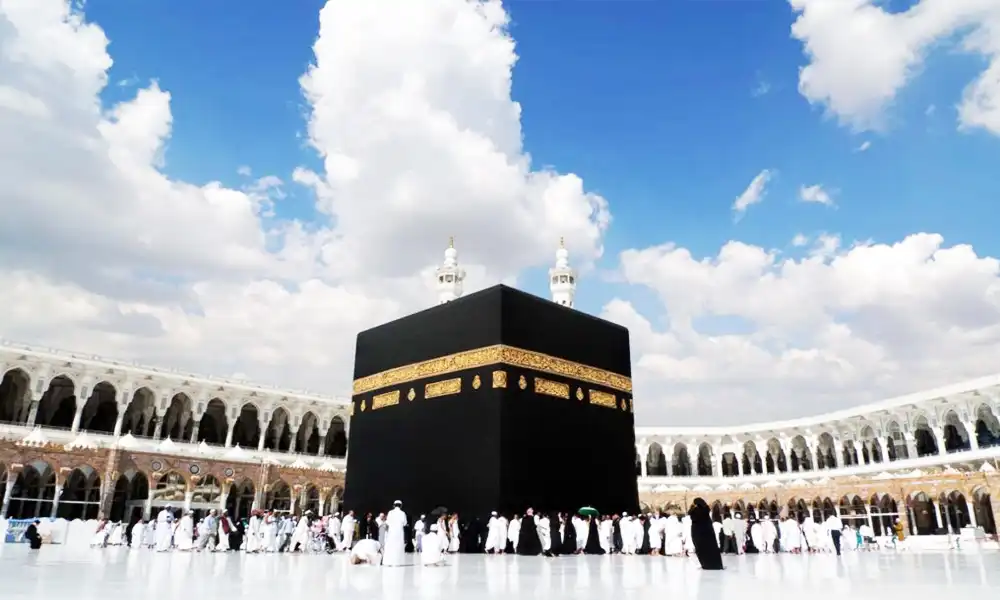
Moving around Mecca is rather straightforward, as there are buses, taxis, and a metro. The crucial sites to visit in the city mainly revolve around the Hajj, with the priorities being the Kaaba and the Sacred Mosque that surrounds it.
Besides the two main sites, the Hajj often involves going to the plain of Muzdalifah where you can gather the stones to throw at the Devil. Once that’s done, you can then proceed to Mina, or the “tent city,” to spend the night and participate in the symbolic ritual of stoning the Devil.
Arafat hill is where Muhammad had his last sermon, while Jabal Al Thur is the cave where he hid from the Meccans trying to kill him. And visiting the mosque of Masjid e Taneem is an essential step in the pilgrimage.
Although not directly tied to the Hajj, the Mountain of Light or Jabal Al Noor is an essential site in Islam since, according to legend, that’s the place where Archangel Gabriel first revealed the Quran to Muhammad.
Another site that doesn’t directly relate to the pilgrimage is Abraj Al Bait or the Mecca Royal Hotel Clock Tower. This towering hotel complex looms over the Sacred Mosque and offers various amenities to pilgrims, including an Islamic Museum, a Lunar Observation Center, and more.

4. What to Do
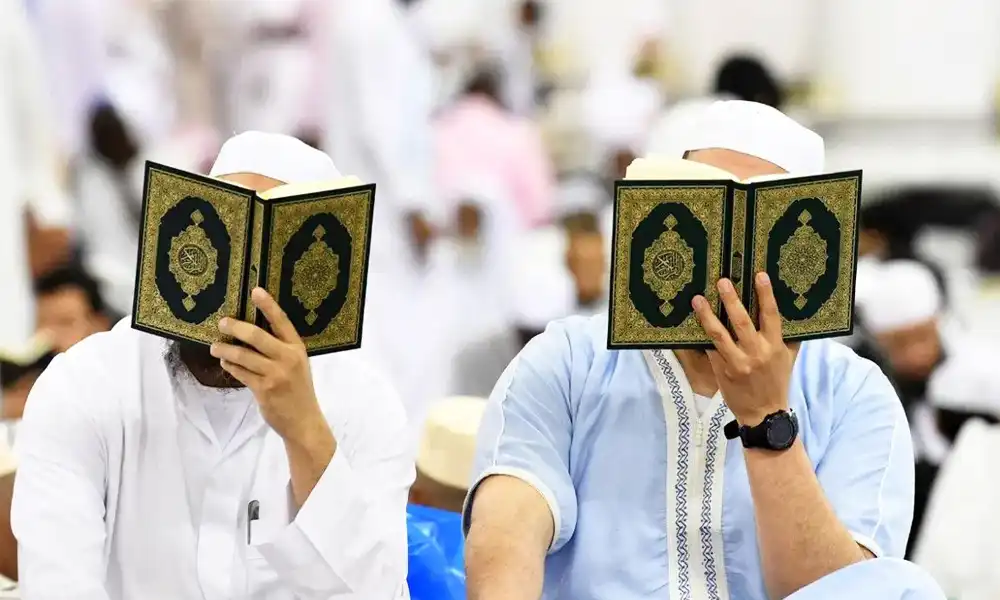
Many activities are available in Mecca and mostly revolve around religious matters. Visitors will have the chance to read the Quran, pray at the Sacred Mosque, stone the Devil at Mina, and visit the sacred sites, among others.
Besides these, you can visit some of the schools in Mecca including the Umm Al-Qura University, which is the only one of its kind in the city. There are also mountains around the city that are ideal for hiking.
5. Shopping and Dining
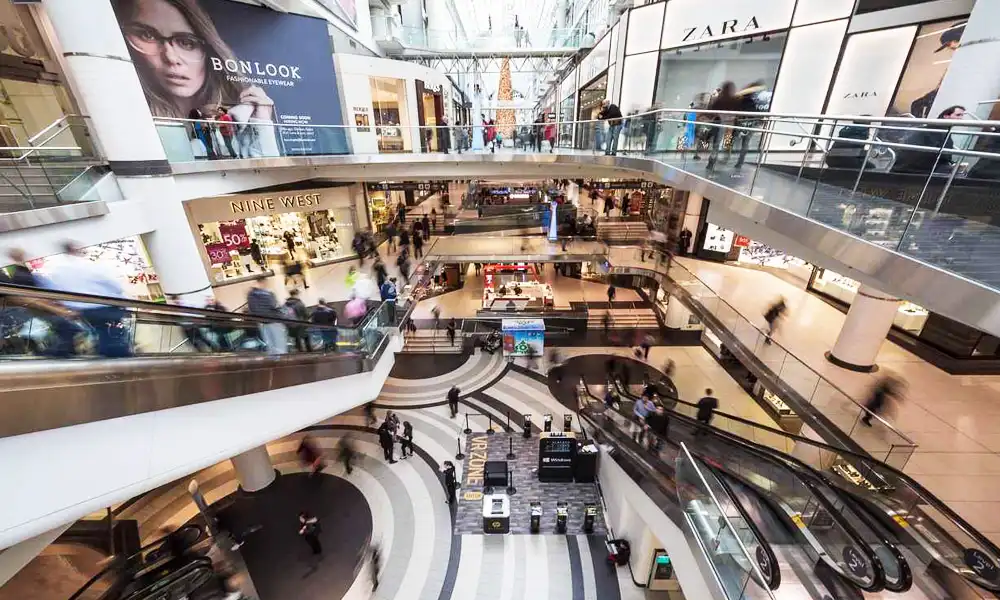
Shopping in Mecca is widespread and you can check out local shops and malls that house various international brands. You can find an abundance of souvenirs to bring back home, as well as different religious items like prayer mats and Islamic hats.
Among the most precious trading commodities that you definitely shouldn’t miss are the Arabian perfume oils. These perfumes are made of natural ingredients and are less likely to irritate the skin. And their beautiful fragrance will last long even with the smallest quantity applied.
When it comes to eateries, Mecca has a broad offer of restaurants that serve Middle Eastern, Indian, Southeast Asian, and international dishes. And if you’re in the mood for some classical American fast food, you can find everything from KFC and Pizza Hut to Dunkin Donuts.
The food produced in the city is compliant with Islamic Law, which means there is no forbidden food like pork or ham.
Similarly, alcoholic beverages are forbidden both in Mecca and the whole country. But you can enjoy different juices, tea, and free Zamzam holy water.
6. Where to Stay
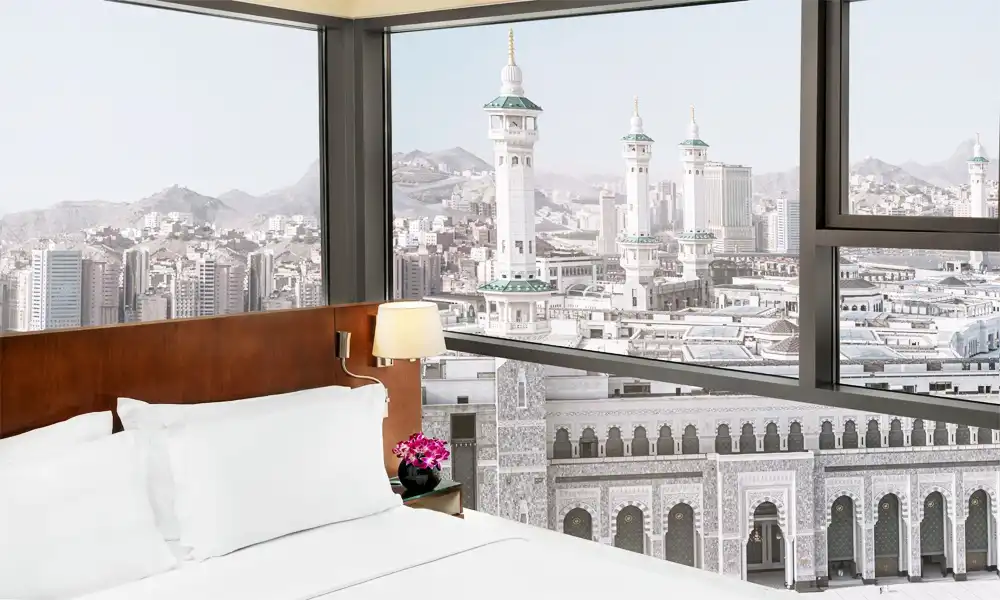
The range of hotels in Mecca is excellent. Pilgrims who can afford it can stay at the Hilton or the Inter-Continental, while others might choose accommodation in a lesser-known place. As expected, the prices of accommodations decrease as you move away from the Sacred Mosque.
Since Mecca can get quite crowded throughout the year, your best bet would be to book as early as possible to ensure a nice place to stay in some of the finer hotels in Mecca.
7. Safety Concerns
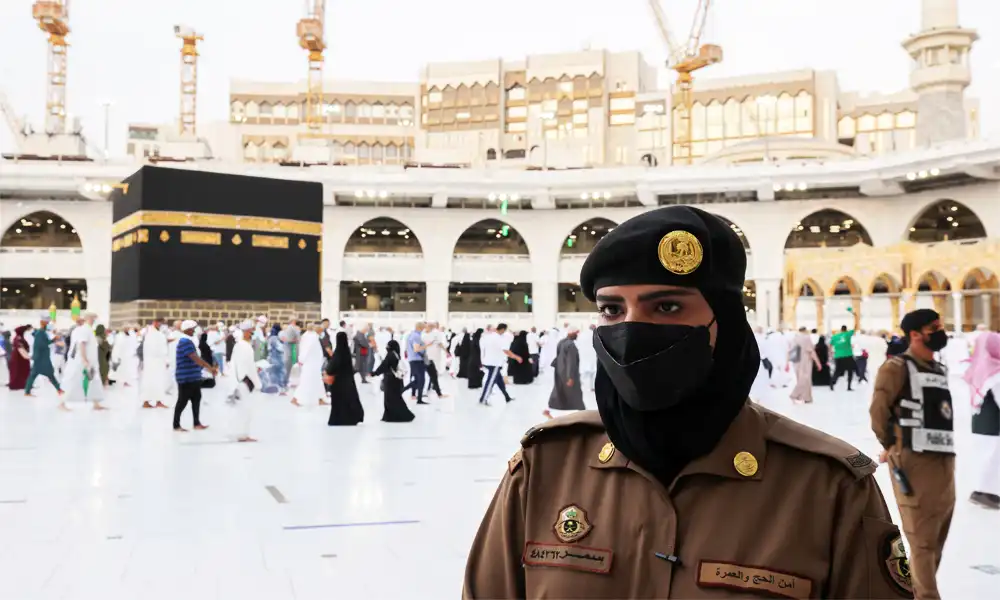
It’s not unusual for dozens of people to die under the stampedes of pilgrims that can be expected. Lately, some precautions have been taken to prevent the unnecessary loss of life. But the risk is still present.
It would also be best to remain cautious of the pickpockets that lurk among the crowd. The best advice here is to leave your valuable possessions in a safe place before going out.
Navigating Through the Holy City of Islam
As is the case with Middle Eastern locations, especially those as overcrowded as Mecca, there are many considerations and preparations to take before visiting. But for true believers, the experience is precious and will present a long-lasting memory.
12 Fascinating Mecca Attractions You Must Visit
Eight Things that Make Colorado Springs Worth Visiting

You may like
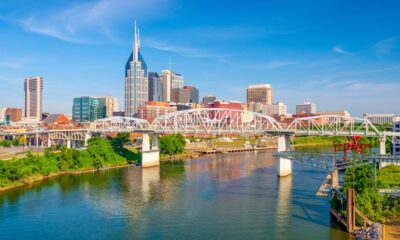
3 Days in Nashville: The Ultimate Nashville Itinerary
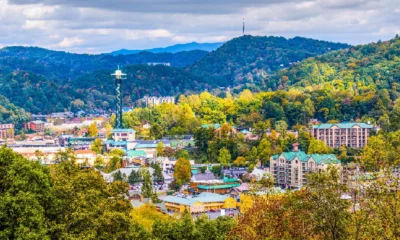
10 Very Best Things To Do In Gatlinburg, Tennessee

New AI Technology Helps Travelers Find the Best Flight Deals
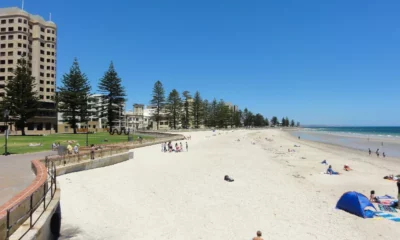
Awesome Adelaide (And the 11 Tourist Spots for Visitors)
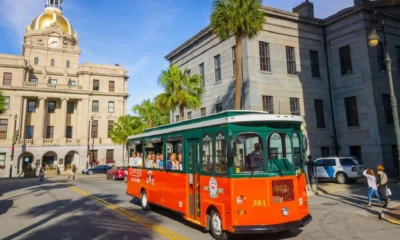
Visiting the Oldest City in Georgia – The Top Tourist Spots in Savannah
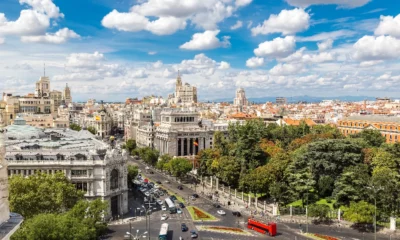
The 9 Essential Madrid Sights for Art and History Lovers
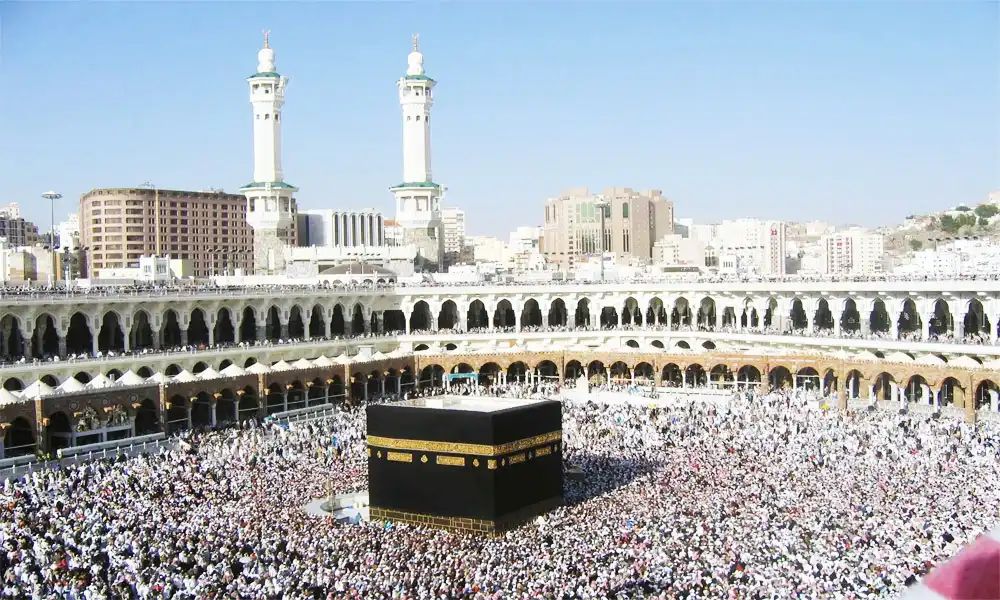
There’s a surprisingly large number of things to see in Mecca, and it’s not limited to religious sites either. Discover some of the city’s highlights you shouldn’t miss.
The holy city of Mecca is best-known as the site of pilgrimage for Muslims all over the world. And if you’re interested in other things to see in Mecca, there are plenty of attractions worth considering.
In this article, we’ll tell you the 12 most interesting sights you should consider adding to your itinerary.
1. The Kaaba and the Sacred Mosque

The Kaaba is an ancient Muslim sanctuary and the great mosque was built around it. Around four million people can fit into the world’s largest mosque. With its intricate structure and delicate decorations, it’s a fascinating sight to see.
Visits to the holy site are quite challenging during the day, as the place is constantly overcrowded. That’s why coming there in the evening will prove much more pleasant.
2. Mount Arafat
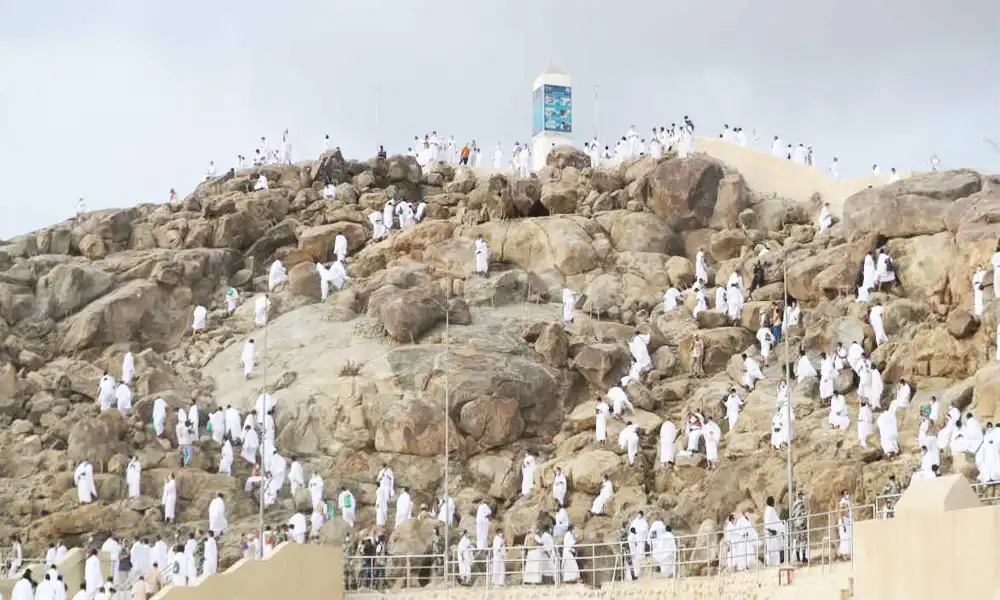
Located east of the city, the Arafat hill is purportedly the spot where Muhammad delivered his final sermon. And according to Muslim belief, this location is where the faithful will resurrect.
With steep sections and piles of rock, the hill might be somewhat demanding to climb. But it’s entirely manageable if you stay hydrated and rest regularly as you go on that trek.
3. Al Aziziyah District
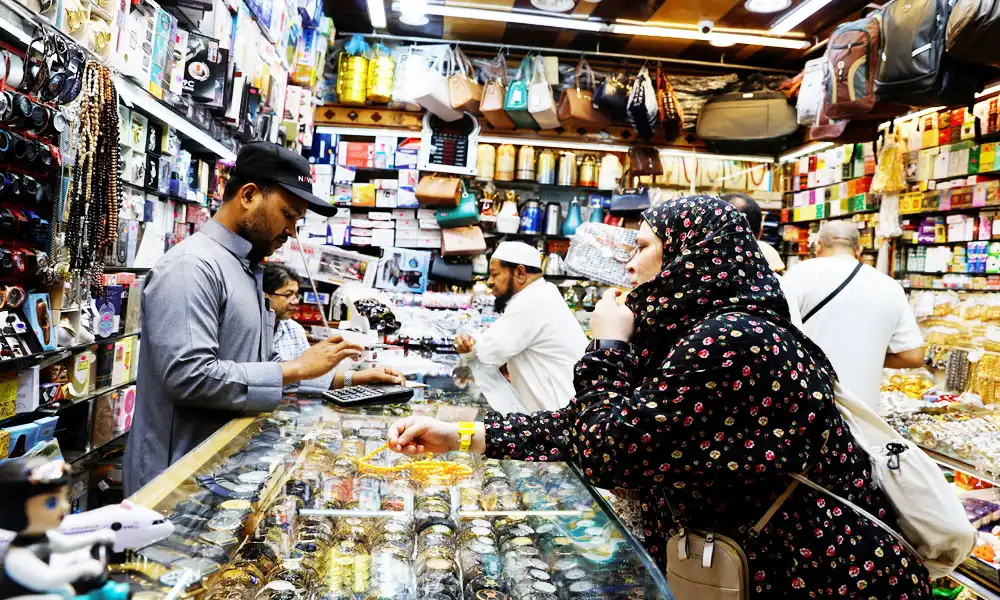
This renowned shopping district is well-known for the markets, with the central market being the most popular spot. Conveniently close to the Sacred Mosque, Al Aziziyah is the best spot for those looking for clothes, accessories, shoes, cosmetics, and more.
Both Al Aziziyah central market and the neighboring Al Majaz market house various local and international brands that deal in textiles and jewelry.
4. Jabal Thawr
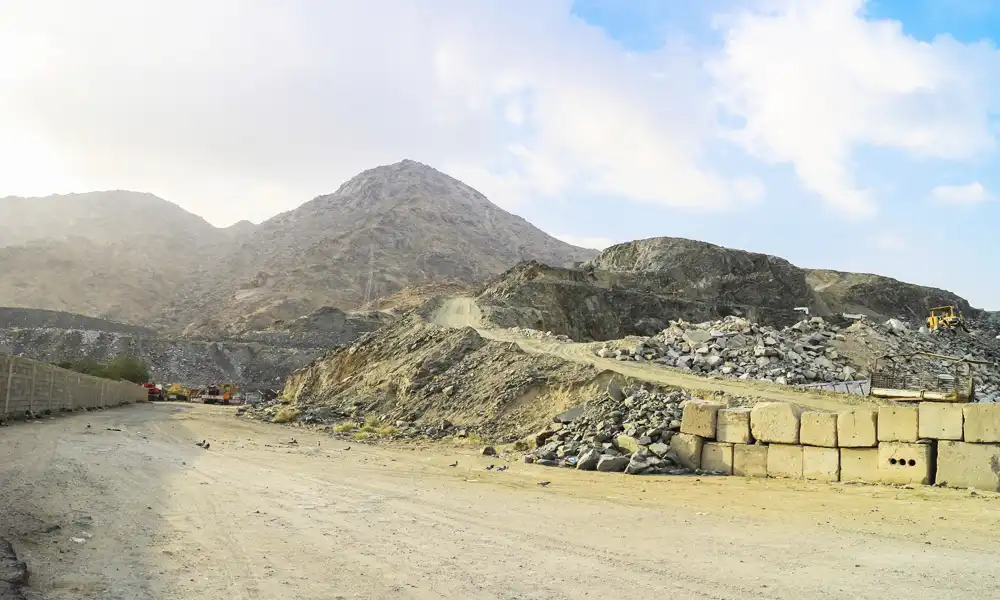
Jabal Thawr is a mountain over 4,500 feet high, and its significance lies in the cave where Muhammad hid while escaping the Meccans who wanted to kill him. There’s a wide path leading to the top and the mountain is perfect for viewing the surrounding landscape.
5. Muhammad’s Birthplace
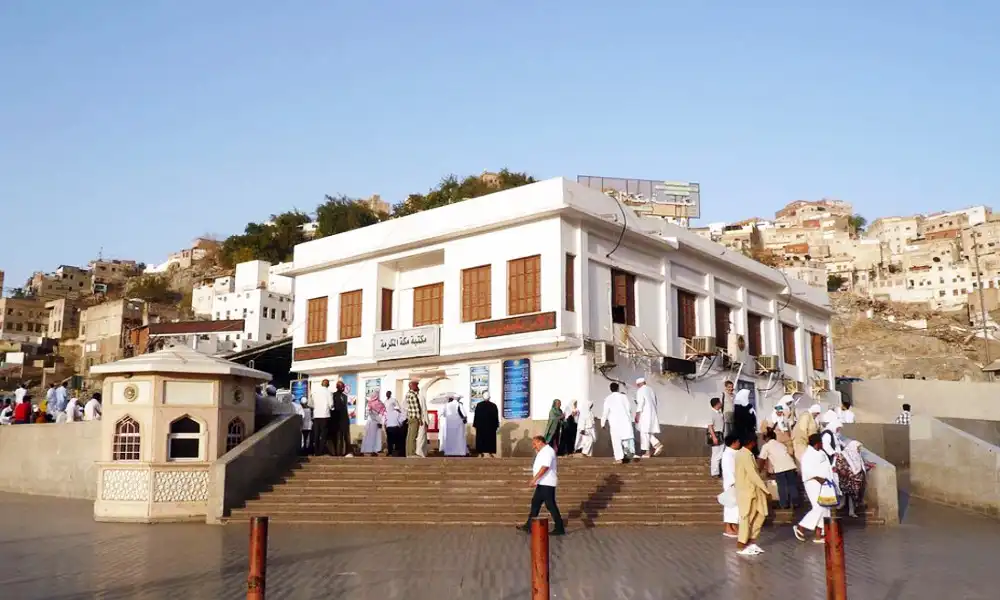
The place where Muhammad was born now houses a library and museum. It’s an excellent spot for learning about the history of the religion. For devoted Muslims, being at the same spot where the prophet was born might be the most sentimental experience during their visit to Mecca.
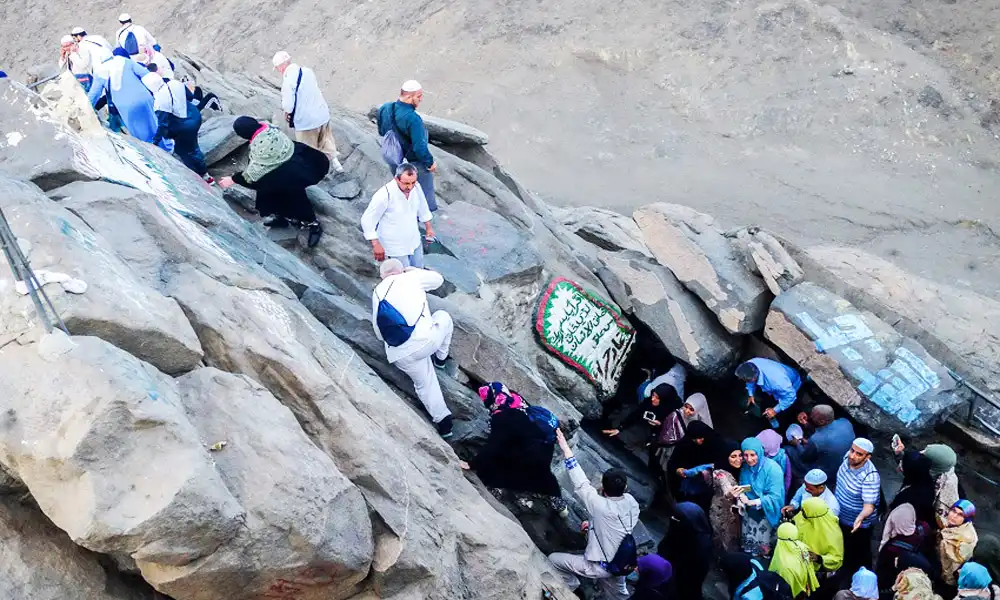
Muhammad had the first revelations in this cave near the city of Mecca. The journey to the cave involves taking a three-hour hike up the mountain in the desert weather, making it quite challenging for most visitors.
It’s recommended to bring plenty of water and some snacks to remain energized during the trip. Hikers should keep a reasonable pace so they don’t become exhausted before reaching the destination. Once on top, you’ll appreciate the excellent view of the city below.
7. Al Diyafa Mall
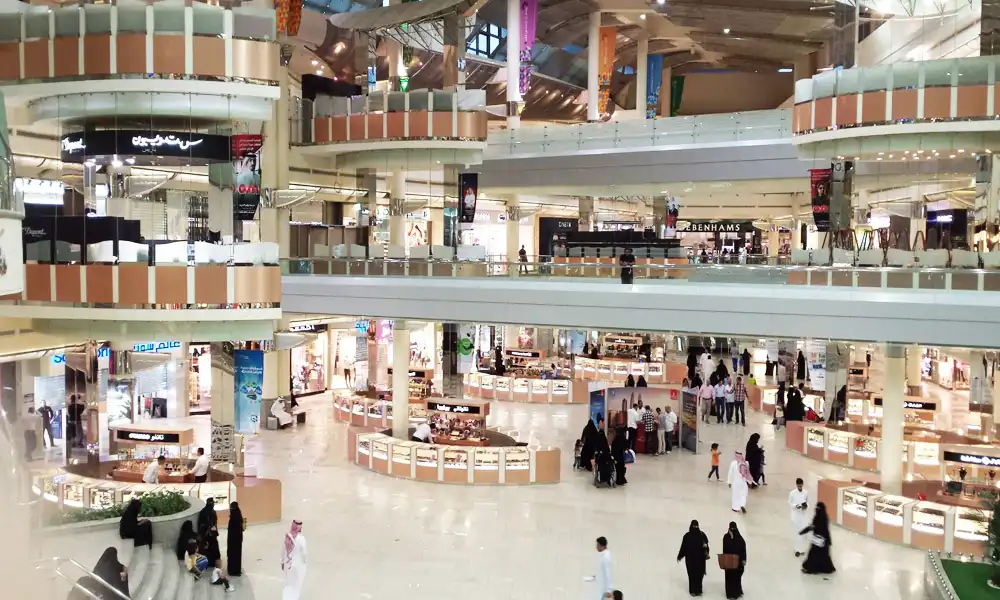
Contrasting the historical sites nearby, the Al Diyafa Mall is a modern-looking structure that houses lavish fashion stores and represents the trendy side of Mecca. Its name translates to ‘hospitality’ and the mall is located in the Al Zahir neighborhood
With plenty of fashion stores, restaurants, and an area for children, Al Diyafa Mall is an ideal place where you can spend several hours browsing and shopping.
8. Abraj Al Bait
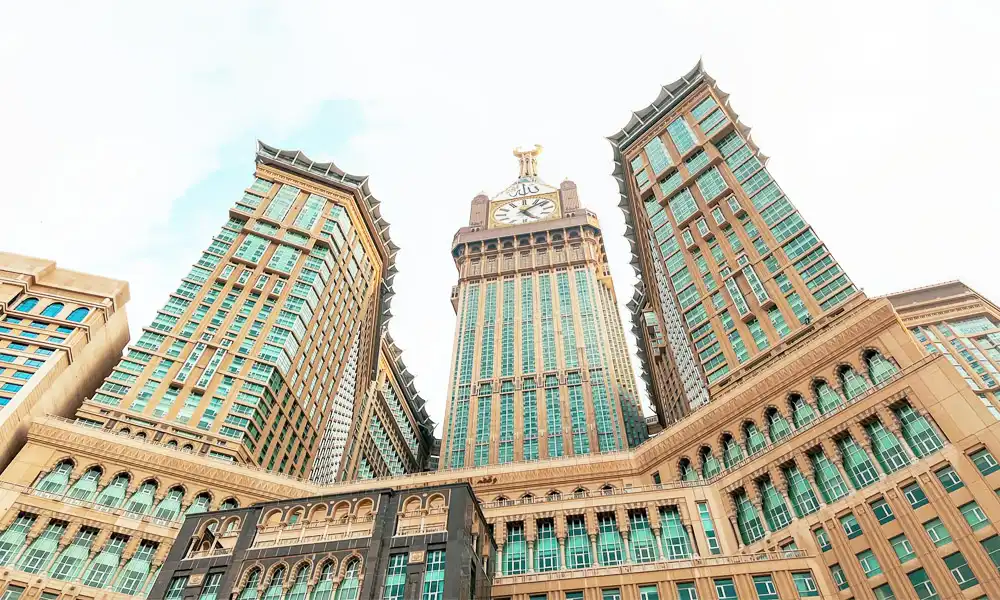
The giant building towering above the Kaaba, Abraj Al Bait is a complex owned by the government and represents one of the most famous attractions in Mecca. Located in it are a shopping mall, a high-end hotel, and a praying space.
The outstanding feature of the massive building is the clock tower that can be seen shining like a beacon from miles away. There’s also an observatory at the top that offers a great view of the surrounding area, making the visit to the building a must.
9. Masjid E Taneem
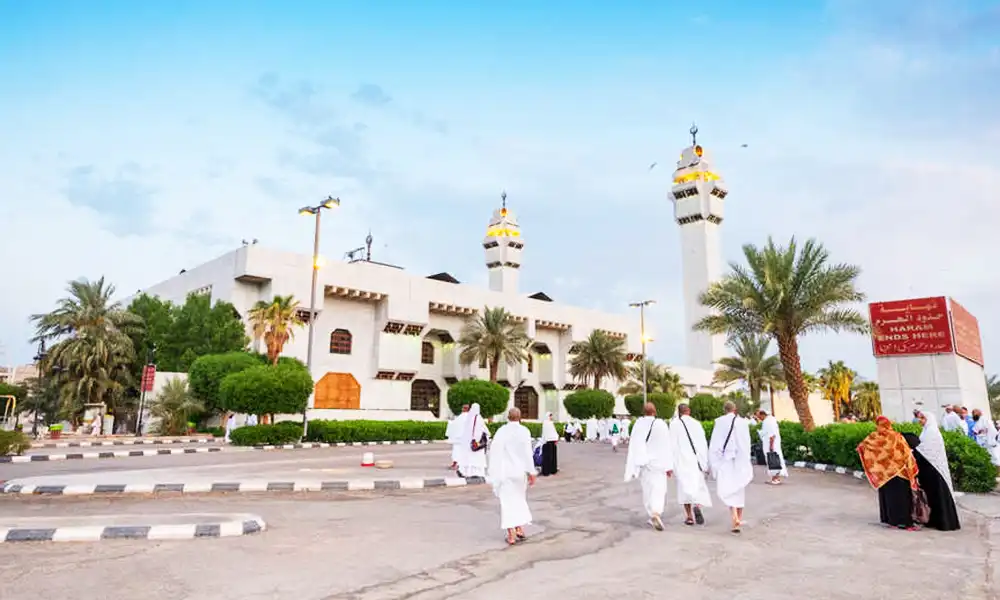
Very close to Mecca, Masjid E Taneem is a mosque and one of the crucial points in pilgrimages. It’s outfitted with bath and changing facilities. Faithful Muslims use it as Miqat or a station where they can change into appropriate garments for the pilgrimage.
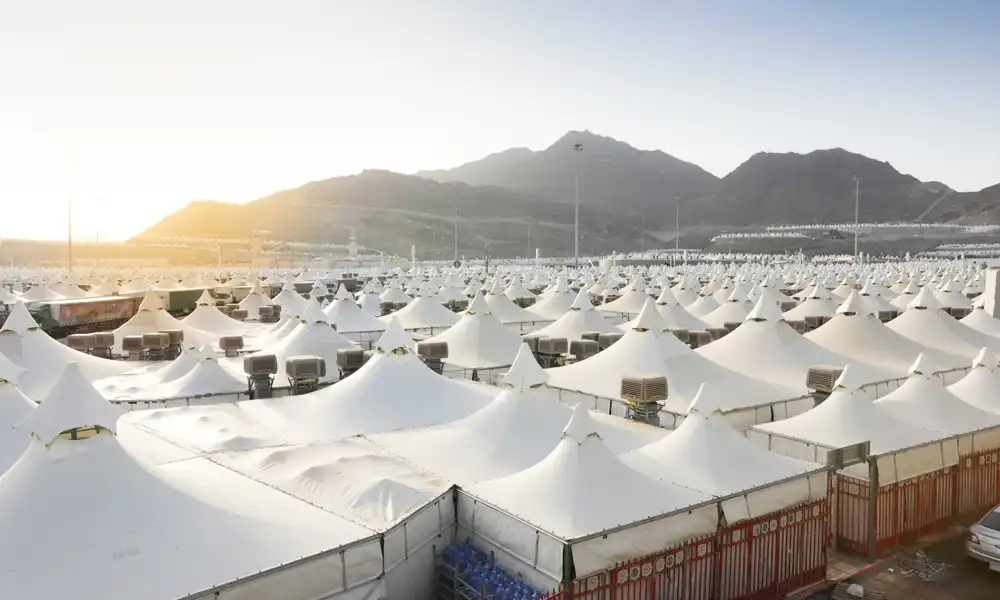
Mina is a neighborhood designed for pilgrims to have a sleep-over during the Hajj. There are tens of thousands of tents that have air conditioning and Teflon coating for everyone to remain comfortable in the high desert heat.
11. Makkah Mall
Away from the desert climate, Makkah Mall is a high-end shopping center with a vibrant atmosphere and plenty of amenities for all kinds of customers. This mall is the essential shopping hub for visitors and it houses many different brands, from local to international.
There are various shops, boutiques, supermarkets, and restaurants, with over 140 brands represented there. You’ll also find various entertainment areas, making the mall very convenient for families with kids.
12. Al Wahba Crater
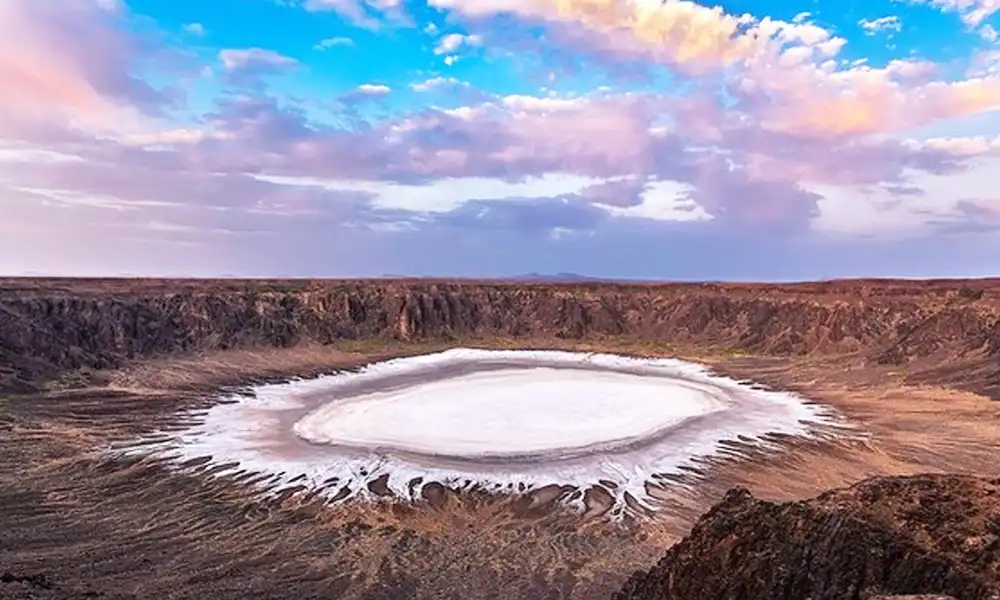
This volcanic crater can be found to the northeast of Mecca, an otherworldly area in the middle of the desert. Measuring almost a mile in diameter and featuring cliffs that reach the height of around 850 feet, the Al Wahba crater is truly massive.
Among the most interesting things to see in Mecca is this crater when it becomes filled with water during the wet season. And once evaporation happens, a layer of salt is left covering the bottom.
Created during the period when the area had plenty of volcanic activity, Al Wahba is surrounded by plains that contain large amounts of volcanic ash. You’ll find some refuge from the sun under the shade of palm trees when hiking through and around the crater. These trees cover the cliffs to the north and you can even choose to camp on the site.
Experience Mecca
From the unavoidable religious sites to excellent shopping venues and wonders of nature, there’s much to see in and near Mecca. It doesn’t matter what one’s level of devotion as a Muslim is. Every visitor will find something to enjoy in the holy city.
- Travel Tips
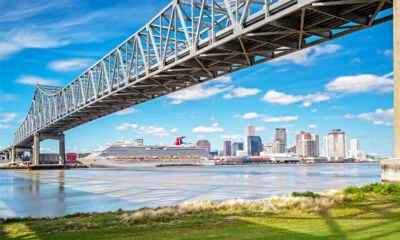
14 Best Scenic Drives in New Orleans: An Expert’s Secret Guide
New Orleans isn’t just about Bourbon Street and beignets! This city’s got a wild side, with hidden pockets of natural...
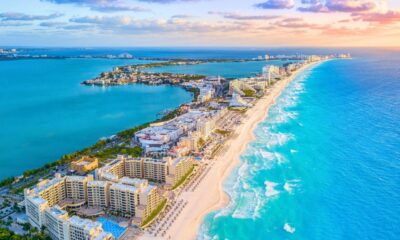
18 Best Resort Spas in Cancun, Mexico (2024)
Escape to Bliss: 18 Resort Spas in Cancun That Will Melt Your Stress Away (2024) Cancun, Mexico, the land of...
Welcome to Nashville, Tennessee, affectionately known as Music City, where the spirit of country music thrives alongside the aroma of...
Get ready to ditch the dull and dive headfirst into the fun-tastic world of Gatlinburg, Tennessee! Located amidst the smoky...
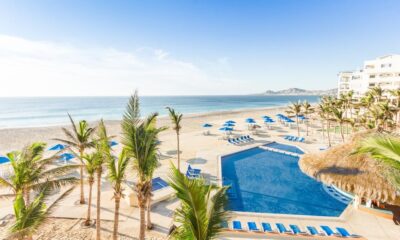
Endless Luxury: The Gateway to Exclusive Travel Savings
In the realm of travel, the pursuit of luxury and affordability often seems like an elusive dream. Enter Endless Luxury...
Flight Wizard is the new game changer in the world of travel. This revolutionary website uses cutting-edge AI technology to...
Awesome Adelaide (And the 11 Tourist Spots for Visitors) Is Australia next on your to-visit list? We suggest taking a...
Visiting the Oldest City in Georgia – The Top Tourist Spots in Savannah You shouldn’t postpone your trip to Savannah....
The 9 Essential Madrid Sights for Art and History Lovers Go beyond sports and Mediterranean cuisine. Madrid is a top...
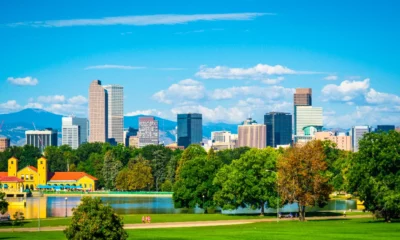
The 12 Things You Need to Know Before Visiting Denver, Colorado
The 12 Things You Need to Know Before Visiting Denver, Colorado Planning a trip to the Mile High City? The...
- Myrtle Beach
- Indianapolis
- South Korea
- Port Macquarie
- Switzerland
- Weekend Getaways
- Romantic Trips
- Family Travel
- Beach Vacations
- World's Best
- Best Hotels
- Best Islands
- Best Cities
- Tips + Planning
- Travel Deals
- Middle East
- South Carolina
- Dominican Republic
- Arts & Culture
- Philippines
- Massachusetts
- Lake George
- San Antonio
- Santa Barbara
- Palm Springs
- Pismo Beach
- Niagara Falls
- Netherlands
- Central Coast
- Saudi Arabia
- Colorado Springs
- San Francisco
- New Orleans
- North America
- Australia & New Zealand
- North-Central Indian Ocean
- Caribbean Islands
- Latest News
- Destinations
- Virginia Beach
- Miami Beach
- Port Douglas
- Daytona Beach
- Kuala Lumpur
- Uncategorized
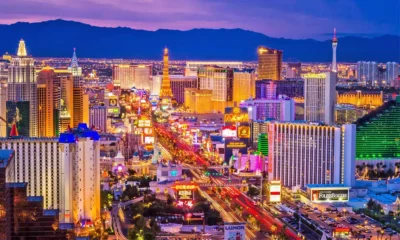
What to Know Before Visiting Las Vegas
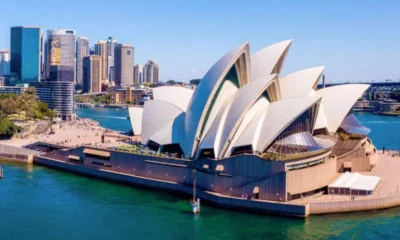
The Eight Places That Tourists Need to Visit in Sydney
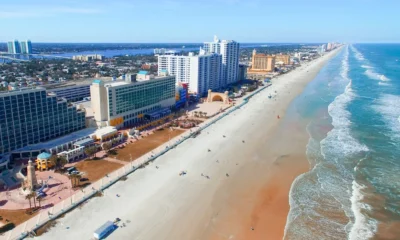
The 9 Reasons You Should Visit Daytona Beach,
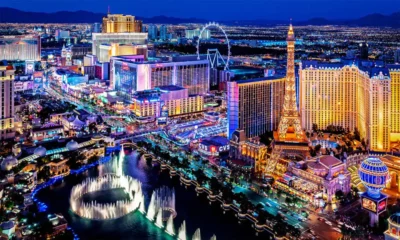
What to Do in Las Vegas During the Night
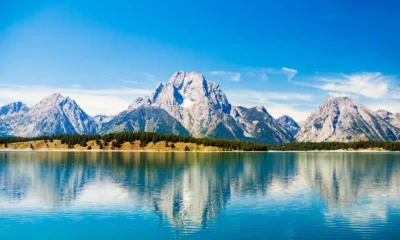
The 15 Best Vacation Spots in the USA During Covid-19
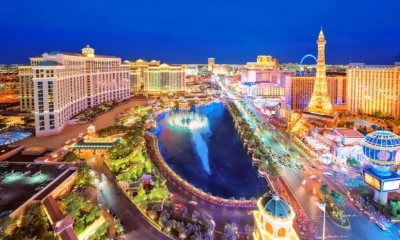
10 Best Activities for an Unforgettable Las Vegas Adventure
Why Are Only Muslims Allowed to Visit the Holy City of Mecca?
Mecca and Non-Muslim Visitors
Reza / Getty Images
- Hajj and Eid Al Adha
- Important Principles
- Prayer Salat
- Prophets of Islam
- Ramadan and Eid Al Fitr
- M.Ed., Loyola University–Maryland
- B.S., Child Development, Oregon State University
Mecca is a city of terrific importance in Islamic tradition. It is a center of pilgrimage and prayer -- a sacred place where Muslims are free from the distractions of daily life. Only Muslims are allowed to visit the holy city of Mecca and enter its inner sanctum, the birthplace of the Prophet Muhammad and Islam. As the holiest city in the Islamic faith, every Muslim who is of sound health and financially able is required to make the pilgrimage -- or Hajj (one of the Pillars of Islam) -- to Mecca at least once in their lifetime in order to show honor, obedience, and respect to Allah.
Where Is Mecca?
Mecca -- home to the Kaaba, Islam's holiest site, otherwise known as the House of God (Allah) -- is located in a narrow valley in the Hijaz region (so-called because of the geography of its "hijaz," or "backbone," the Sarat Mountains, which consists of volcanic peaks and deep depressions) of Saudi Arabia, about 40 miles inland from the Red Sea coast. Once an oasis and caravan trade route, ancient Mecca linked the Mediterranean with South Asia, East Africa, and South Arabia.
Mecca and the Quran
Non-Muslim visitors are banned in the Quran: "Oh you who believe! Truly the idolaters are unclean; so let them not, after this year, approach the Sacred Mosque. ..." (9:28). This verse specifically refers to the Grand Mosque in Mecca. There are some Islamic scholars who would permit exceptions to this general rule, for trade purposes or for people who are under treaty permission.
Restrictions to Mecca
There is some debate about the exact area and borders of the restricted areas -- several miles around the holy sites are considered haram (restricted) to non-Muslims. Nevertheless, the government of Saudi Arabia -- which controls access to the holy sites -- has decided upon a strict ban to Mecca in its entirety. Restricting access to Mecca is intended to provide a place of peace and refuge for Muslim believers and preserve the sanctity of the holy city. At this time, millions of Muslims visit Mecca each year, and additional tourist traffic would simply add to the congestion and detract from the spirituality of the pilgrimage visit.
- The Stages of Hajj, the Islamic Pilgrimage to Mecca (Makkah)
- The Architecture and History of the Kaaba
- What happens after one performs Hajj?
- Why Is the City of Jerusalem Important in Islam?
- Madinah City Guide
- Biography of the Prophet Muhammad's Later Life
- Top Islamic Art Museum Collections
- When Is the Hajj Held?
- Are Muslims Allowed to Get Tattoos?
- Why and When Do Muslim Girls Wear the Hijab?
- Is Smoking Allowed in Islam?
- How Does One Prepare to Go for Hajj?
- Authorized U.S. Travel Agents for Hajj and Umrah Trips
- Islamic Festival Eid al-Adha
- Lesson Plans for Eid al Adha, an Islamic Celebration
- Ihram Clothing for Hajj--the Muslim Pilgrimage to Makkah (Mecca)
If you're seeing this message, it means we're having trouble loading external resources on our website.
If you're behind a web filter, please make sure that the domains *.kastatic.org and *.kasandbox.org are unblocked.
To log in and use all the features of Khan Academy, please enable JavaScript in your browser.
AP®︎/College Art History
Course: ap®︎/college art history > unit 2.
- Introduction to Islam
- The Five Pillars of Islam
- Introduction to mosque architecture
Prayer and pilgrimage
The history and form of the kaaba, modifications, the kaaba today.
Want to join the conversation?
- Upvote Button navigates to signup page
- Downvote Button navigates to signup page
- Flag Button navigates to signup page

How the holy city has changed over the past 100 years
As the sun rises over Mecca on Sunday July 18, up to 60,000 pilgrims dressed in customary white robes called Ihram will begin their five-day long spiritual journey to seek forgiveness for past sins and start anew before God.
The Hajj is is one of the five pillars of Islam and a once-in-a-lifetime duty for all able-bodied Muslims to perform if they can afford it. Before the coronavirus pandemic, some 2.5 million pilgrims would descend on Mecca for the annual Hajj.
However, this year, like 2020, no foreign pilgrims will attend the Hajj after Saudi Arabia restricted the annual pilgrimage to a maximum of 60,000 vaccinated citizens and residents between the ages of 18 and 65.
Mecca from the sky
Central to the Muslim pilgrimage is the Grand Mosque of Mecca which houses the Kaaba, a cube-shaped structure elegantly draped in black silk with verses of the Quran woven into it with gold and silver threads.
Muslims believe that the prophet Abraham and his son, Ishmael built the Kaaba as the house of God. The structure has been built and rebuilt several times with the last major renovation taking place in 1996 to strengthen its foundation. Wherever they are in the world, Muslims face the direction of the Kaaba when performing their prayers.
To accommodate the millions of pilgrims who normally attend the annual pilgrimage, the grounds of the Grand Mosque have expanded considerably over the past few decades. In 2019, Saudi Arabia announced that it had received more than 95 million pilgrims over the past 50 years, and that it planned to host 30 million pilgrims for Hajj and Umrah each year.
Google Earth satellite images captured from 2004 through to December 2020 show just how quickly the holy city has expanded.
For Muslims, the Hajj re-enacts the actions of the Prophet Muhammad in his “farewell pilgrimage” in 632 AD which traces the footsteps of the prophets Abraham and Ishmael through the Arabian desert. It is a central pillar of the Islamic faith meant to cleanse followers of sin and bring them closer to God.
Hajj falls on the 8th of Dhul al-Hijjah, the twelfth and final month in the Islamic lunar calendar which shifts 10-12 days earlier each year. The pilgrimage spans five days and involves travelling to key locations around Mecca including Mina, Mount Arafat, Muzdalifah, the Jamarat and the Grand Mosque.
We take a look at the step-by-step process in the infographic below.
For hundreds of years pilgrims from all over the world would travel on camelback or by ship for weeks at a time to reach Mecca. With the convenience of modern air travel this journey can now be completed within hours.
Click through the 8-image gallery below to see some of the iconic moments in history starting in 1889.
Hajj socially distanced
At its peak in 2012, nearly 3.2 million pilgrims from over 190 countries performed the Hajj. Just one year later, an outbreak of the Middle East Respiratory Syndrome, or MERS coronavirus, forced roughly a million pilgrims to forgo the trip to Mecca.
In 2020, following the outbreak of COVID-19, Saudi officials announced that they would permit only about 10,000 pilgrims residing in the kingdom to perform the Hajj with no overseas visitors allowed.
This year, up to 60,000 vaccinated citizens and residents of Saudi Arabia between the ages of 18 and 65 will be permitted to perform the annual pilgrimage.
On March 19, 2020, Saudi authorities suspended all prayers at the two main mosques in Mecca and Medina. Congregational prayers resumed seven months later with protective measures in place. Muslim travellers from outside Saudi Arabia were permitted a limited number of Umrah visas starting on November 1, 2020.
Before and after satellite images taken just two months apart show how the usually crowded Grand Mosque was left empty following the global pandemic.
Hajj in the digital world
For millions unable to make the pilgrimage this year, a digital experience may offer a glimpse of what it is like to worship at Islam’s holiest site. In 2015, Al Jazeera produced a 360-degree VR experience that takes viewers on a tour to see the major landmarks that millions of Muslims visit during the Hajj.
Experience the journey by moving your phone around or drag the video around to see what Mecca looks like from all angles.
Eid al-Adha or the Feast of Sacrifice is celebrated on the third day of Hajj and lasts for three days. This year Muslims worldwide will celebrate Eid on 20-22 July. Eid al-Adha is the second major Muslim festival after Eid al-Fitr, which marks the end of Ramadan, the month of fasting.
Here is how people say Eid Mubarak in different languages around the world.
- Newsletters
Site search
- Israel-Hamas war
- Home Planet
- 2024 election
- Supreme Court
- TikTok’s fate
- All explainers
- Future Perfect
Filed under:
- World Politics
Hajj, the Islamic pilgrimage to Mecca, explained for non-Muslims
It’s like Burning Man, but for Muslims. Okay, it’s nothing like Burning Man.
Share this story
- Share this on Facebook
- Share this on Twitter
- Share this on Reddit
- Share All sharing options
Share All sharing options for: Hajj, the Islamic pilgrimage to Mecca, explained for non-Muslims
/cdn.vox-cdn.com/uploads/chorus_image/image/50787355/GettyImages-93497054.0.jpg)
At this moment in mid-August, 1.5 million people from dozens of countries around the world are in Mecca, Saudi Arabia, to perform the hajj, the Islamic religious pilgrimage.
It’s a huge event — in terms of both its significance in Islam and the massive logistical challenge of having that many people from all walks of life and every corner of the globe descend on one relatively small place all at once.
But what actually goes on at the hajj? What is its religious and political significance? How do they handle all those people? And what is inside that big black box?
We've got you covered: Here are the most basic answers to the most basic questions about the hajj.
What is the hajj?
The hajj — Arabic for “pilgrimage” — is a five-day religious pilgrimage to Mecca and nearby holy sites in Saudi Arabia that all Muslims who are physically and financially able must perform at least once in their lives. It is one of the five pillars, or duties, of Islam, along with the profession of faith in the one God and Mohammed as his prophet, prayer, charitable giving, and fasting during the holy month of Ramadan .
The hajj takes place only once a year, in the 12th and final month of the Islamic lunar calendar; pilgrimages to Mecca made at other times in the year are encouraged but do not count as the hajj. Because the Islamic lunar calendar is about 11 days shorter than the 365 days of the standard Gregorian calendar, the timing of the hajj moves backward each year.
Over the five days of the hajj, pilgrims perform a series of rituals meant to symbolize their unity with other believers and to pay tribute to God. On the last three days of the hajj, pilgrims — as well as all other Muslims around the world — celebrate Eid al-Adha, or the Festival of Sacrifice. This is one of the two major religious holidays Muslims celebrate every year. (The other is Eid al-Fitr, which comes at the end of Ramadan.)
At the end of the hajj, pilgrims return home and are often given the honorific “hajji,” meaning one who has performed the hajj. (One interesting note here: During the Iraq War, US troops frequently used the term “hajji” as a derogatory term for any Iraqi, Arab, or other person of Middle Eastern or South Asian descent. So although they certainly didn’t mean it this way, and it almost certainly wasn’t taken this way by the person on the receiving end of the slur, US troops were inadvertently applying a term of respect and honor to these individuals.)
What is the religious significance of the hajj?
People may be surprised to learn that the hajj has very little to do with the Prophet Mohammed. Rather, it mostly commemorates events in the life of the Prophet Ibrahim — that is, Abraham. Yes, that Abraham.
If you’re from a non-Abrahamic faith tradition or if it’s just been a while since Sunday school, Abraham is a venerated patriarchal figure in Judaism, Christianity, Islam, and the Baha’i faith. He is perhaps best known for being willing to personally kill his beloved son when God commanded him to do so. At the last minute, so the story goes, God stepped in and told Abraham to sacrifice an animal instead, rewarding Abraham’s unwavering faith.
In the Judeo-Christian narrative, the son Abraham almost sacrifices is Isaac. In Islam, however, it’s Abraham’s other son, Ismail (Ishmael), who is almost sacrificed. Muslims consider both Abraham and Ismail to be prophets of God, and Mohammed’s ancestry is said to be traced back to Ismail.
There is another event involving Ismail and his mother, Hagar, that looms large in the hajj. The story goes like this: God commanded Abraham, as a test of faith, to take Hagar and the infant Ismail out to a barren desert area located between the two hills of Safa and Marwah in Mecca, and leave them there alone with only basic provisions. Eventually the water ran out, and the increasingly frantic Hagar ran back and forth from hill to hill seven times searching for water for her parched child.
Then a miracle occurred: A well, later called the Zamzam well, sprang from the ground, saving both of them. The story of how the well was discovered differs: Some accounts say it was the baby Ismail’s distressed kicking of his feet that scratched away the dirt and revealed the water source. Other accounts hold that the angel Gabriel (Jibril in Arabic) tipped his wing into the dirt to reveal the well.
Abraham and Ismail later went on to build the Kaaba, the black cuboid structure in Mecca that Muslims face when they pray, together, as a place of worship of the one God. (Abraham eventually came back and retrieved his family from the desert, evidently.)
Soon after they built the Kaaba, tradition holds, God commanded Abraham to proclaim a pilgrimage to the site — in other words, the hajj — to all mankind (well, all monotheists) so that they can come together in one place to show their devotion to God.
Okay, seriously, what’s the deal with the big black cube?
Muslims around the world face the direction of the Kaaba — Arabic for “cube” — when they pray, but they don’t worship the Kaaba (or the Black Stone). Rather, it is a place of worship of the one God. It is also a focusing mechanism, a central point on the globe toward which all Muslims, in a symbol of unity, direct their thoughts and prayers to God.
According to Islamic tradition, the site of the Kaaba was originally a sacred place where angels would worship God in the days before man was created. Later, Adam (yes, that Adam, partner to Eve) built a shrine to God on that spot, but it too was destroyed by the ravages of time. When Abraham came along, he and his son Ismail rebuilt the Kaaba on the foundations of Adam’s earlier shrine as a place of worship of the one God.
The structure consists of four walls and a roof, all made from stone from the hills surrounding Mecca. The four corners roughly face the four points of the compass. The building is often referred to as a “cube” (that’s where “Kaaba” comes from, after all), but this is not technically correct. To be a true geometric cube , all its edges must have the same length, and every corner in the cube must have an angle of 90 degrees.
The Kaaba’s edges are not all the same length, so therefore it is best described as a “cuboid,” not a “cube.” It is covered by a black silk cloth decorated with verses of the Quran in gold-embroidered Arabic calligraphy. This cloth is known as the kiswah, and it is replaced yearly, on the second day of the hajj.
While Abraham was building the Kaaba, so the legend goes, the angel Gabriel came down and gave Abraham the famous Black Stone, which he placed in the eastern corner of the structure.
There is another squarish stone on the ground a few feet away from the Kaaba with what look like two footprints in it. This is known as the Station of Abraham and is said to be the stone where Abraham stood while watching over the construction of the Kaaba. Today it is encased in a beautifully ornate golden glass-and-metal structure.
There is a famous story in Islam about Mohammed and the Black Stone. By Mohammed’s time, the Kaaba had again been damaged and was being repaired (it has been damaged or destroyed and rebuilt or repaired numerous times over the centuries). The story goes that when construction was finished and it came time to place the Black Stone back in the eastern corner, the final step, the tribes of Mecca argued fiercely over who would get to do the honors.
They decided to ask the next man who walked by to decide for them, and that man happened to be Mohammed. His solution was to put the stone on a large cloth and have each of the leaders of the four tribes hold a corner of the cloth and carry the stone to its place. Mohammed himself then placed the stone into its final position.
This was back before Mohammed had received his first revelation from God. The next time Mohammed was involved with the Kaaba, though, would prove to be much less ... harmonious.
Islamic tradition holds that although Abraham built the Kaaba to worship the one God, over time the Kaaba had been more or less co-opted by the various pagan tribes in the area, all of whom had placed idols to their preferred deity inside the Kaaba, thereby “corrupting” it.
One particularly popular idol was a figure of Hubal, a moon deity worshipped by many in Mecca at the time. Access to the Kaaba (and thus the idol) was controlled by the powerful Quraysh tribe, of which Mohammed was a member, and they basically capitalized on this to get rich, charging fees and selling wares to pilgrims coming to worship the idol.
When Mohammed began receiving revelations from God (he received his first one about five years after the incident with the Black Stone) and preaching his message of monotheism, the rich Qurayshi merchants started getting a little antsy. Worried that the growing popularity of his decidedly anti-idol worshiping message could potentially hurt business, they ran Mohammed and his small band of followers out of town.
Ten years later, Mohammed and his now much larger and more powerful army of followers defeated the Quraysh tribe and took control of Mecca. One of Mohammed’s first acts upon taking control of the city was to go into the Kaaba and smash the idol of Hubal and the hundreds of other idols to pieces, rededicating the shrine as a place of worship of the one God.
Today, the Kaaba is kept closed during the hajj because of the overwhelming number of people, but those who visit the Kaaba during other times of the year are sometimes allowed to go inside. It’s quite beautiful: The walls are white marble on the lower half and green cloth on the upper half. There is very little inside it, though — just three tall stone pillars, a small table, some hanging lamp–looking things, and a staircase to the roof.
Oh, and aliens.
:no_upscale()/cdn.vox-cdn.com/uploads/chorus_asset/file/7077657/inside%20the%20kaaba.jpg)
Just kidding.
What are the main rituals performed during the hajj?
The most well-known ritual is the tawaf (literally “circumambulation”), during which pilgrims circle the Kaaba counterclockwise seven times at both the very beginning and the very end of the hajj. Although it’s not entirely clear exactly why it’s seven specifically, many believe it has to do with the motion of celestial bodies. Seven is also a prominent number associated with the divine in many religions, including Christianity and Judaism.
Other rituals include a ceremony where pilgrims throw small pebbles at three large stone walls, called jamarat, to symbolize the stoning the devil that tempted Abraham to defy God, and the slaughtering of an animal (usually a sheep) to honor the animal Abraham slaughtered instead of his son.
The meat is then given to feed the poor and needy. These days, pilgrims frequently elect to purchase tokens to have an animal slaughtered for them.
:no_upscale()/cdn.vox-cdn.com/uploads/chorus_asset/file/7076775/GettyImages-93445708.jpg)
There is also a ritual called Sa’ee, in which pilgrims walk back and forth between the two hills of Safa and Marwah seven times to commemorate Hagar’s frantic search for water for her infant son.
Today, both hills are enclosed within the Masjid al-Haram (Sacred Mosque) complex (which also houses the Kaaba), and the path between the hills is a long, beautiful indoor gallery with marble floors and air conditioning. Many also drink from the Zamzam well located there.
The only ritual that is solely related to Mohammed is the climbing of Mount Arafat, which is where Mohammed preached his last sermon. On the second day of hajj, pilgrims wake at dawn and walk a short distance to Mount Arafat, where they spend the remainder of the day on or near the mountain in quiet worship and contemplation of God.
Can non-Muslims do the hajj?
No. Although Christians and Jews believe in the God of Abraham, they are not allowed to perform the hajj. Indeed, the government of Saudi Arabia forbids all non-Muslims from entering the holy city of Mecca at all.
:no_upscale()/cdn.vox-cdn.com/uploads/chorus_asset/file/7074591/GettyImages-72956966.jpg)
The Saudi government takes this very seriously, so the odds that a non-Muslim would be able to slip in unnoticed among the throngs of pilgrims undetected or pretend to be Muslim and get in that way are extremely small. It’s not completely impossible — it has happened a handful of times over the centuries — but given the millions who attend every single year, the rate of success is miniscule. The Saudis have been doing this for a long time, and they’re not idiots.
Legal entry into the country is extremely tightly controlled, and the paperwork required to get a hajj visa is incredibly detailed. Pilgrims must book their hajj trip through a Saudi government–approved hajj travel agent. For a Western Muslim convert to be allowed to go on hajj, he or she must present documentation from an imam (Muslim religious leader). The imam must testify in writing that he knows the person in question and that the person is a true convert.
Trying to come in on a regular tourist visa and then stealthily making your way to Mecca is also a nonstarter. Getting a tourist visa as a Westerner is notoriously hard, and the likelihood of you being able to just slip away from your Saudi government minder and travel undetected all the way from the capital Riyadh to Mecca — more than 500 miles away, on the other side of a vast desert — is basically laughable.
The only way for a non-Muslim to get in is essentially to play the long con, pretending to convert to Islam seemingly sincerely enough to convince the local imam that you’re for real. That has happened before: In 2015, WND published a three-part series written pseudonymously by someone who claimed to be a white British non-Muslim man who successfully fake-converted to Islam and went on hajj.
So it’s not impossible. But you have to really, really, really want to go to all that trouble and risk potentially being deported and banned from the country (not to mention causing a major international incident and pissing off just about every Muslim on the planet) just to get into a city to see some sites that aren’t even of religious significance to you.
What about women and children?
Parents may choose to bring even their very young children with them, but the hajj won’t “count” toward fulfilling the child’s personal religious obligation, as that requires the child to be mature enough intellectually and spiritually to understand the significance of the hajj.
Women are also allowed — indeed, required, just like every other physically and financially able Muslim is — to perform the hajj. However, they have to be accompanied by an appropriate male guardian (called a mahram). Here are the rules, per the US State Department:
Women below the age of 45 must be accompanied by a “mahram” (e.g. close adult, male relative such as a husband, son, father, or brother) for Hajj. Women must be met by their sponsor upon arrival. Women who are traveling alone and not met by sponsors have experienced delays before being allowed to enter the country or to continue on other flights. Women over 45 may travel without a mahram in an organized group, provided they submit a notarized letter of no objection from the husband, son, or brother, authorizing travel for Hajj with the named group. Violators face deportation.
Women who are members of the minority Shia sect of Islam (the majority of the world’s Muslims are Sunni), on the other hand, are not required by Saudi authorities to have a mahram when attending hajj and are allowed to travel alone. This is likely because Shia scholars have, unlike Sunni scholars, ruled that a woman may travel alone on hajj if she feels that she will be safe.
And since it’s basically impossible to talk about women in Islam these days without someone bringing up the issue of how much clothing they’re required (or not required) to wear, here’s a fun fact: Although women must cover their hair with a scarf, the face veil, known as a niqab, and the burqa, the garment that covers from head to toe with only a mesh-like panel through which to see, are not allowed during hajj.
Yes, you read that right: The two pieces of clothing that are the most controversial and are seen by many anti-Islam critics as symbols of the pervasive and pernicious cultural intrusion of Islam and its inherent oppression of women, are not allowed during one of Islam’s most sacred rituals, even though men and women mix freely during it.
Some women still wear them, though, despite the prohibition, and it doesn’t seem to be something that’s actually enforced. Some have also come up with rather creative workarounds, such as wearing large, darkly tinted sunglasses and those paper face masks doctors wear.
So why the prohibition? The reason is basically that while Mohammed’s various statements regarding women’s dress are hotly debated among Muslim scholars (Mohammed lived a long time, after all, and he said a lot of things over the course of his life), his statement on women not covering their faces (or hands) during hajj is crystal clear: A woman in the state of ritual purity for hajj “should not cover her face or wear gloves.” Not a whole lot of room for debate there (though, of course, people still do debate it, because humans).
Men also wear special clothing during hajj. Male pilgrims wear two pieces of clean, unstitched cloth (usually plain white) — one wrapped around their waist and one wrapped around their torso — and plain sandals. The purpose of making all men dress in this same simple garb is to strip away all indications of wealth and status so that all pilgrims are seen as equal, as they are in the eyes of God.
How in the world does Saudi Arabia handle such a massive number of people each year?
In general, the Saudi government does a pretty good job at managing things, all things considered. But not always: Over the years, there have been many horrific examples of large numbers of people dying.
1.5 million people are attending the hajj this year. That’s way bigger than the Olympics (10,500 athletes and 500,000 foreign tourists went to Rio for the 2016 Olympics), Burning Man (the annual gathering in the Nevada desert currently has an attendance cap of 70,000 ), and the average Taylor Swift concert combined.
It’s not the biggest world event — that honor probably goes to the Kumbh Mela Hindu religious festival held every three years in India (in 2013, some 100 million people are believed to have attended) — but it’s still pretty impressive. For instance, the Saudi government’s target for the number of people performing tawaf (circling the Kaaba seven times) last year was 107,000 an hour .
But considering there are an estimated 1.6 billion Muslims on the planet, all of whom are required to perform the hajj at least once in their lives if they are financially and physically able, the numbers could actually be a lot higher. The main reason they aren’t is because every year the Saudi government sets quotas for each country on how many pilgrims they’re allowed to send on hajj.
To manage the people who do get to come, the Saudi government has invested billions of dollars in building a vast and elaborate infrastructure in and around the holy sitesa massive hajj terminal at the main airport in Riyadh, a complex network of roads to bring pilgrims to the city of Mecca, wide foot bridges to carry the tens of thousands of pedestrians who move from place to place at preset, staggered times to minimize traffic flow (personal vehicles are prohibited, for obvious reasons, so most people walk everywhere, though some — mostly the elderly — take shuttle buses), multi-tiered galleries around the Kaaba and the jamarat (the stone walls where the symbolic stoning of the devil takes place), and more.
Perhaps the most stunning logistical feat, though, is the vast tent city at Mina, located just a few kilometers from Mecca, where more than 160,000 air-conditioned, fireproof, Teflon-coated fiberglass tents provide temporary accommodation for pilgrims. Men and women, even married couples, sleep in separate tents. The majority of the tents can accommodate about 50 people, and the average price for each pilgrim is $500, according to Al Jazeera’ s Basma Atassi.
However, luxury tents costing as much as $10,000 per pilgrim — including some equipped with jacuzzis — are available for those few wealthy enough to afford them. As Atassi writes, though, the Saudi government in recent years has taken steps to ban them, stating that they “defied the spirit of the Hajj.”
:no_upscale()/cdn.vox-cdn.com/uploads/chorus_asset/file/7078625/Mina%20tent%20city.jpg)
For 51 weeks of the year, the tent city, roads, and other infrastructure built to accommodate pilgrims are almost completely deserted. Then for one week each year, they seethe with humanity.
There is also an extensive security apparatus in place to monitor every aspect of the hajj — to maintain order and safety, but also to ensure that proper Islamic protocol is followed by all in attendance. This year, the Saudis have deployed tens of thousands of security forces to control crowds and help keep pilgrims safe.
Unfortunately, that same number of security forces wasn’t enough to prevent catastrophe from striking in 2015: That year, more than 2,400 people were killed when a stampede occurred at the intersection of two pedestrian walkways leading out of the tent city toward the jamarat bridge.
Though this was the deadliest hajj disaster in history, other disasters have occurred. As Al Jazeera’s Atassi notes:
A 1990 stampede inside a pedestrian tunnel killed almost 1,500 people, while stampedes in the stoning of the devil area in 1990, 1994, 1998, 2003, 2004 and 2006 claimed the lives of hundreds. The eruption of a fire in 1997 burned thousands of tents and killed over 300 people.
Health issues are also a major concern during the hajj. So many people from all corners of the globe gathering in such a small area means the chances of contagious diseases spreading through the population are very high. There is also a high risk of heat stroke, heat exhaustion, dehydration, and sunburn, especially when the hajj falls in the summer months (as it does this year). For instance, in August 1985 , 2,000 cases of heatstroke were reported, and more than 1,000 of the sufferers died within a few days.
To try to prevent this from happening, the Saudi government makes all pilgrims adhere to strict guidelines regarding vaccinations, especially for particularly contagious diseases such as meningitis. Pilgrims are also advised to drink lots of water and to be mindful of the perils of the blistering desert heat.
The Saudi government also provides complimentary water distributed from refrigerated trucks, air-conditioned tents at Mina, large sun-blocking canopies, and thousands of fine-mist sprinklers, according to the US Centers for Disease Control and Prevention .
Medical facilities are also available in and around the main hajj sites. As Asaad Shujaa and Sameer Alhamid write in the Turkish Journal of Emergency Medicine , in 2012 there were 25 hospitals with 4,427 bed capacity (500 critical care and 550 emergency care) and 141 health centers with 20,000 qualified specialized personnel. They also note that all health care is provided at no cost to all pilgrims.
And, finally, there’s the politics.
Saudi Arabia and Iran have for years been in a sort of proxy struggle for dominance of the Middle East and the broader Muslim world. Saudi Arabia's government is officially Sunni, and Iran's is officially Shia. Both countries frequently exploit this by pushing a sectarian worldview of Sunni versus Shia. And that often comes to a head over the hajj.
The political legitimacy of the Saudi royal family rests largely on its religious credentials, which it gets at home from the support of the country's ultra-conservative Wahhabi religious establishment, and internationally from being the "custodian" of the two holiest places in Islam, the Prophet Mohammed's mosque in Medina and Masjid al-Haram in Mecca.
Iran, then, has long sought to portray the Saudis as incompetent custodians in an effort to damage their credibility, and has even called for an international body to take over administration of these places. When a horrific stampede occurred at the 2015 hajj, Iran jumped at the chance to blame the Saudis.
More than 400 Iranian pilgrims were reportedly killed in the incident. But before most of the victims had even been identified, Iranian leaders issued statements blaming the Saudis for the accident.
Iran’s Supreme Leader Ayatollah Khamenei stated , “The Saudi government is obliged to accept its heavy responsibility in this bitter incident and meet its obligations in compliance with the rule of righteousness and fairness; mismanagement and improper measures that were behind this tragedy should not be undermined,” and declared three days of mourning for the victims of the stampede.
The fight bled into the 2016 hajj. Khamenei issued a blistering statement on his website calling the Saudis murderers for their handling of the stampede last year and suggesting they may even have caused the stampede on purpose:
Saudi rulers were at fault in both cases. This is what all those present, observers and technical analysts agree upon. Some experts maintain that the events were premeditated. The hesitation and failure to rescue the half-dead and injured people, whose enthusiastic souls and enthralled hearts were accompanying their praying tongues on Eid ul-Adha, is also obvious and incontrovertible. The heartless and murderous Saudis locked up the injured with the dead in containers- instead of providing medical treatment and helping them or at least quenching their thirst. They murdered them.
Not to be outdone, Saudi Arabia’s top religious leader struck back, accusing the Iranians of being pagan fire worshipers, not Muslims. From Al Jazeera :
In comments to the Makkah newspaper published on Tuesday, Saudi Arabia's Grand Mufti Abdulaziz Al Sheikh was quoted as saying that Khamenei's remarks blaming Riyadh for last year's tragedy were "not surprising" because Iranians are descendants of Magi. Magi refers to Zoroastrians and those who worship fire. Predating Christianity and Islam, Zoroastrianism was the dominant religion in Persia before the Arab conquest. "We must understand they are not Muslims, for they are the descendants of Majuws, and their enmity towards Muslims, especially the Sunnis, is very old," Saudi's grand mufti said, according to the AP news agency.
The Iranians also decided to bar their citizens from attending the hajj at all last year, claiming the Saudis failed to adequately guarantee the safety of Iranian pilgrims and accusing them of having “blocked the proud and faithful Iranian pilgrims’ path to the Beloved’s House [the Kaaba].” The Saudis, of course, blamed the Iranians , arguing they had refused to sign the agreement both sides had reached over the 2016 hajj:
“Saudi Arabia does not prevent anyone from performing the religious duty,” the Saudi foreign minister, Adel al-Jubeir, said at a news conference with his visiting British counterpart, Philip Hammond. “Iran refused to sign the memorandum and was practically demanding the right to hold demonstrations and to have other advantages … that would create chaos during hajj, which is not acceptable,” he added.
Whoever’s fault it was, no Iranian pilgrims were allowed at the hajj in 2016. In 2017, however, Iran lifted the ban, and around 80,000 Iranians performed the hajj that year.
And there are tons of Shia Muslims from other countries, too. For the most part, Sunni and Shia pilgrims on hajj get along just fine — despite the best efforts of the governments of Iran and Saudi Arabia to stir up sectarian tension every year for geopolitical gain.
That Sunni and Shia pilgrims come together as brothers and sisters in Islam during the hajj is a powerful reminder of how religion can unite people as well as divide them. Pilgrims planning to go on hajj are advised to avoid conflict and disagreement with other Muslims, to refrain from judging or being harsh toward others whose customs or interpretations of Islam may seem ignorant or incorrect.
Because that’s what the hajj is really supposed to be about: believers from around the world coming together, putting aside linguistic, cultural, class, and sectarian differences, and worshiping God.
Will you support Vox today?
We believe that everyone deserves to understand the world that they live in. That kind of knowledge helps create better citizens, neighbors, friends, parents, and stewards of this planet. Producing deeply researched, explanatory journalism takes resources. You can support this mission by making a financial gift to Vox today. Will you join us?
We accept credit card, Apple Pay, and Google Pay. You can also contribute via
Next Up In World Politics
Sign up for the newsletter today, explained.
Understand the world with a daily explainer plus the most compelling stories of the day.
Thanks for signing up!
Check your inbox for a welcome email.
Oops. Something went wrong. Please enter a valid email and try again.
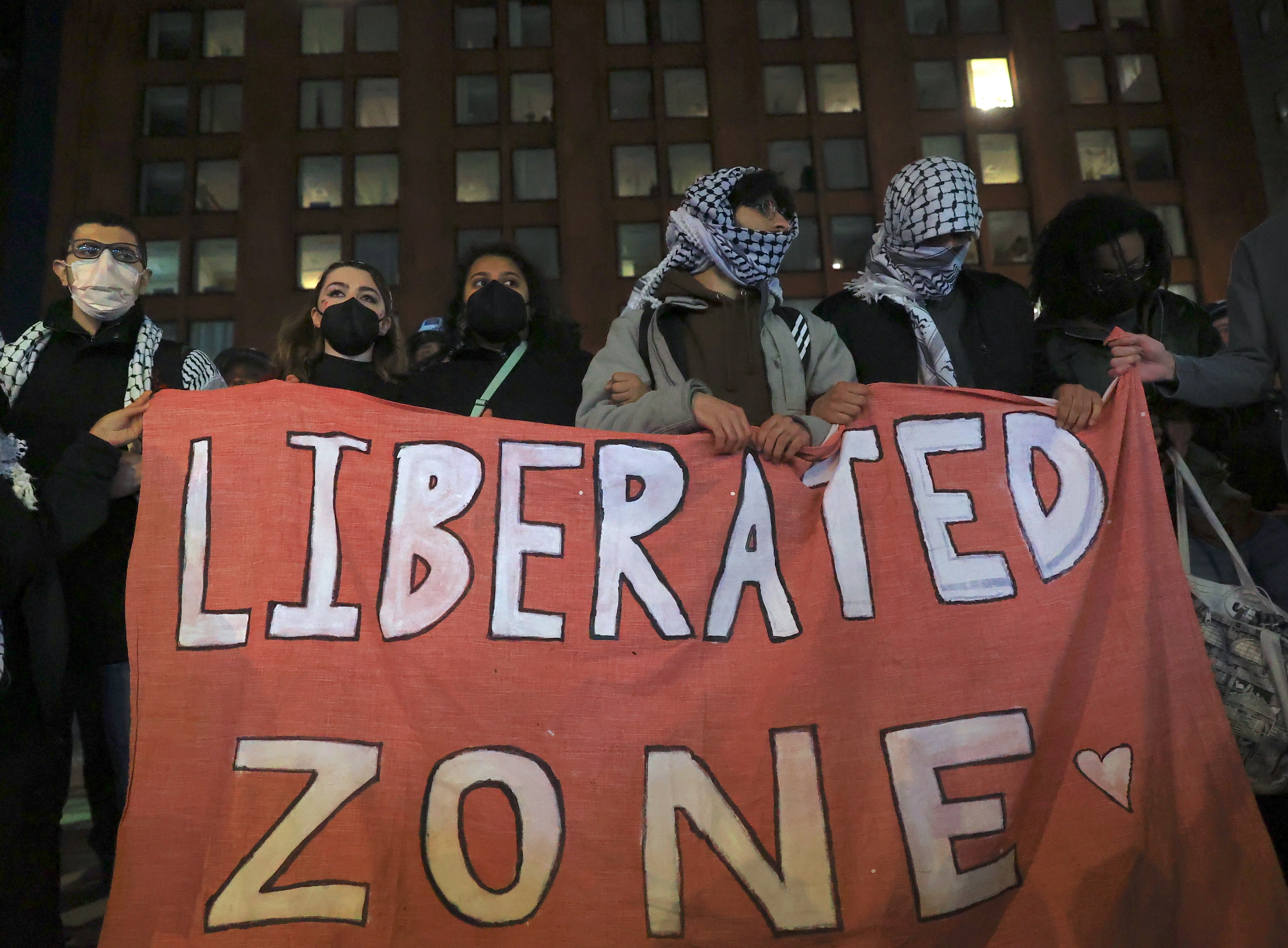
What the backlash to student protests over Gaza is really about

The lessons from colleges that didn’t call the police

Should humans get their own geologic era?

The longshot plan to end the war in Gaza and bring peace to the Middle East
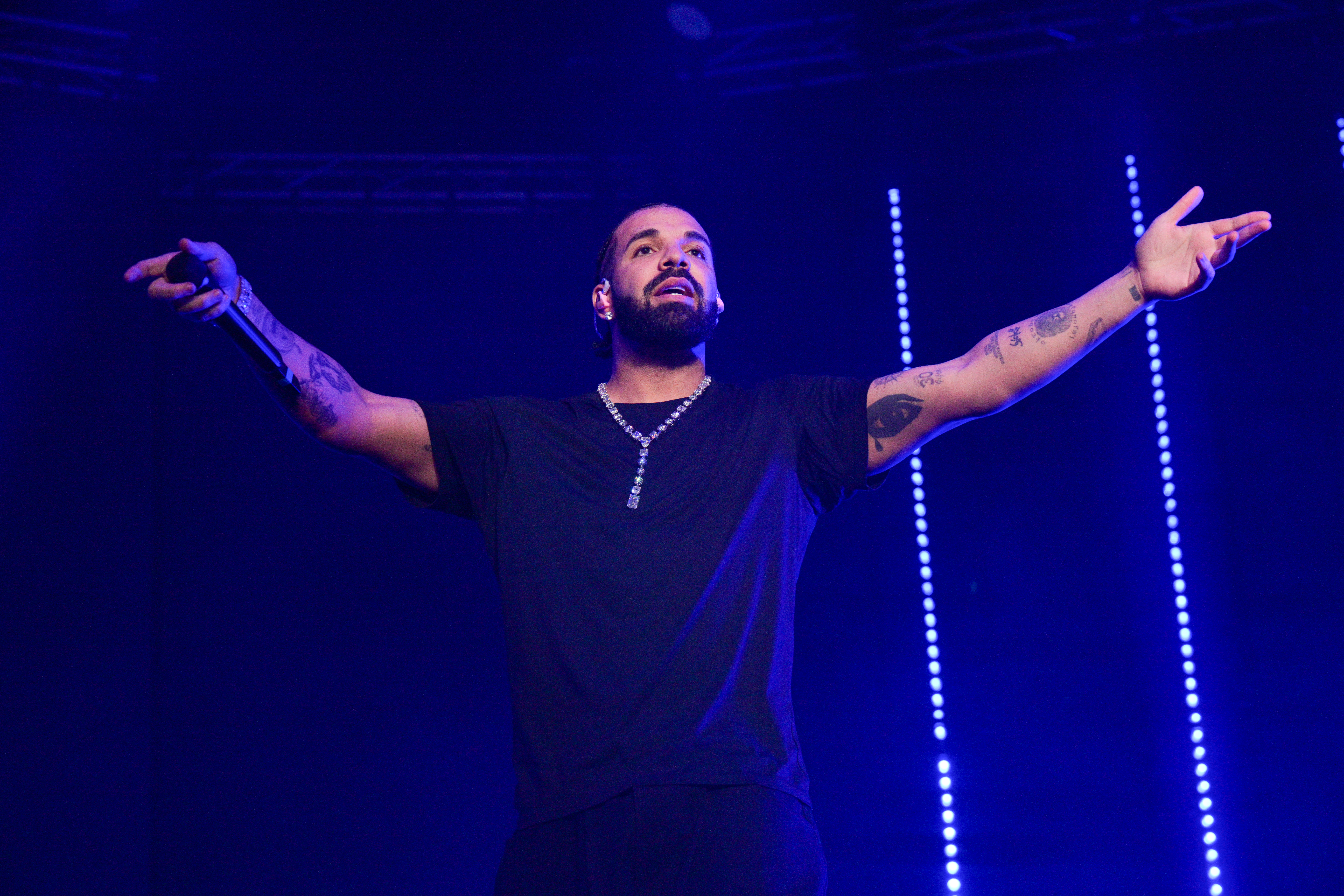
Drake vs. everyone, explained
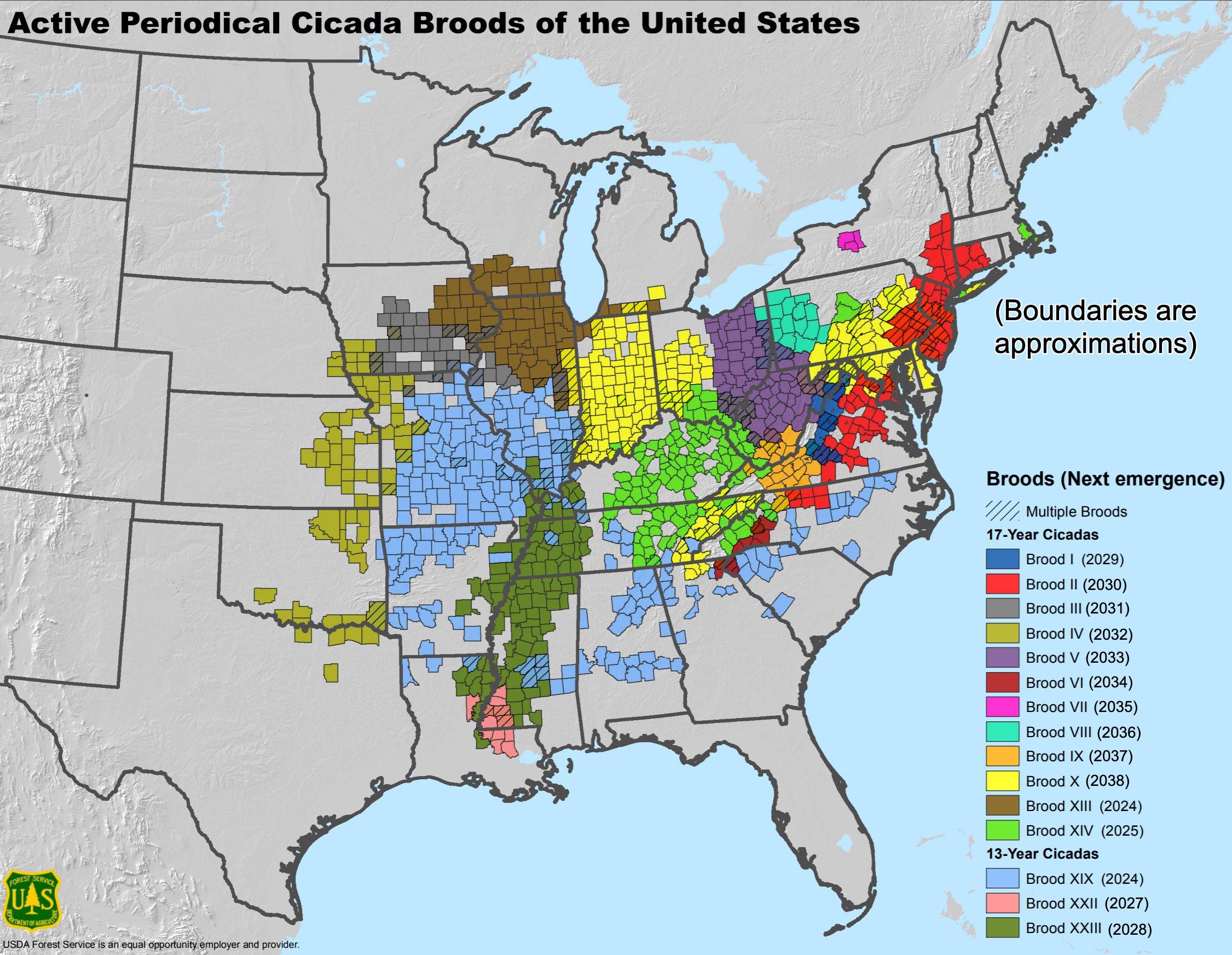
Where billions of cicadas will emerge this spring (and over the next decade), in one map

What are the requirements for traveling to Mecca? passport and rules
What are the requirements.
Muslim pilgrimage to the Mecca once a year. The most important of them all is the so-called Hajj, pilgrimage that takes place in a particular month. During the rest of the year, other pilgrimages take place, but these are considered minor and are not mandatory.
There are some requirements to travel to the Mecca and make the pilgrimage. The first one is almost tacit: to be a Muslim. Non-Muslims ‘unfaithful’ or are banned from this city. The next requirement to travel to the Mecca is to be an adult, male or female and have the possibility, whether economic to make the pilgrimage.
If yoy want know about travel to mecca enter here
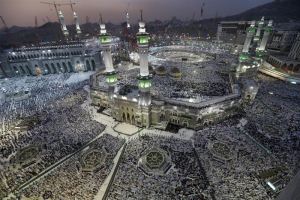
The following requirements to travel to the Mecca are quite , such as being healthy and being an adult, means mature, in order to understand the meaning of the pilgrimage to Mecca. In addition, the believer must be free and be able to make the pilgrimage without any problem at all.
Another group of the requirements to travel to Mecca is of a financial nature: being able to pay for the round trip, as well as supporting your family during the time the believer is absent from the house. This is one of the most important requirements since the pilgrimage to Mecca is expensive. To carry out this Muslim rite matter, several believers dedicate an important part of their lives saving money to make it possible.
Some believers do not have the chance to raise enough money to perform the rite. That is why there are several foundations and organizations around the world that donate money to pay for travel and lodging for some rigorously selected believers, during the days when the pilgrimage lasts. In some cases, the foundations get money from the sponsors, while in other cases, they get it from the government.
For the sponsors, offering the pilgrimage of another believer, it is like giving them a blessing, since they are giving them the opportunity to live a unique experience and that will be of great benefit to their spirituality. Among the requirements to travel to Mecca under this scheme, it is precisely not having the money to do so. In addition, you have to be over 40 and converted to Islam. This foundations treat believers to live the spiritual experience this rite gives, and the idea is to favor the less privileged. For example, they try to pay for the trip to the elderly, since it is considered that he or she will be less likely to make the pilgrimage in the remaining time of their life.
These are not the only requirements to travel to the Mecca. Apart from the economic barrier, there is another important barrier, which is the permission to enter the country. Saudi Arabia does not issue a tourist visa, nor is tourism allowed on its border, because of this, a limited amount of fees are given to each country, in proportion to the number of Muslims living in the country, so that they can Make the pilgrimage. In this way, Muslims who do not live in Mecca or Saudi Arabia can enter to make the pilgrimage.
There are other requirements to travel to Mecca of a religious nature. This is due to the fact that there are three ways to make the pilgrimage: one for those who live in the same city, another for those who live outside, as long as they do not live more than 88 kilometers from it, and another for those who live more than 88 kilometers of it. As the latter is the most important, important characteristics will be mentioned.
It has two parts, the first one has 5 defined rites, like consecration as a pilgrim, circling around the Kaaba, praying after turning around the Kaaba, running between two points and finally shaving the mustache and with the haircut. The second part has more requirements.
During the first rite of the pilgrimage, the believer has to have every intention of finding God during the pilgrimage, wearing a special costume and saying the prayer. For the second rite, seven laps must have around the black stone, with departure and arrival in it. Immediately after that, the prayer must take pleasure in front of a monument. After the run between the two points between which it is believed that Agan ran to get water for Ishmael takes place. To end the rite, the fifth stop is to have a little haircut, shave your mustache or beard.
Leave a Comment Cancel Reply
Your email address will not be published. Required fields are marked *

Commerce & Finance
- Palestine: Jerusalem
- Palestine: Masjid al-Aqsa
- Palestine: Other
- Makkah: Hajj places
- Makkah: Masjid al-Haram
- Makkah: Other
- Madinah: Masjid-e-Nabwi
- Madinah: Other
- Saudi Arabia: Additional places
Can non-Muslims go to Mecca or Madina? Can Tourists Enter?
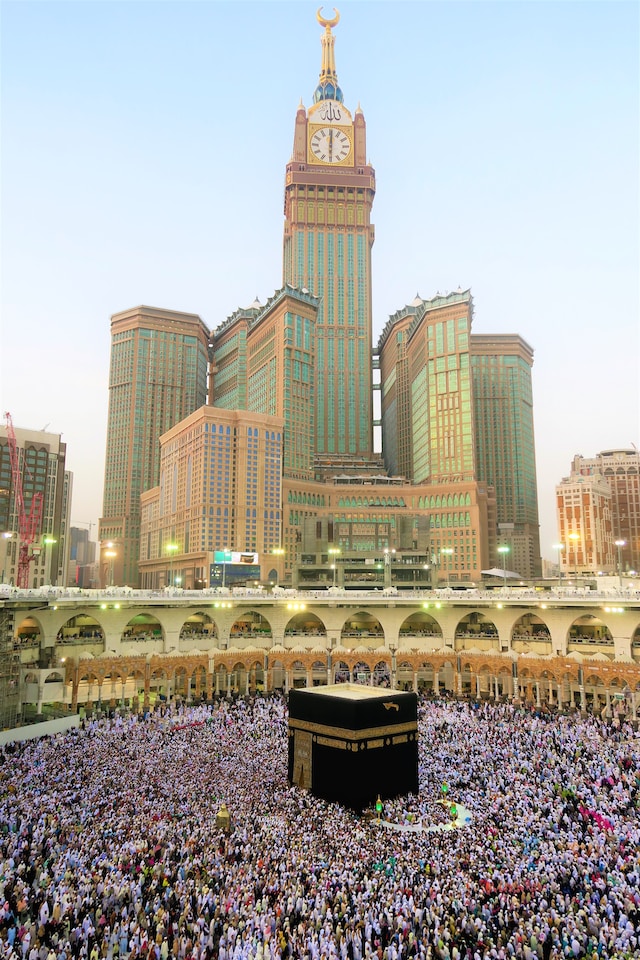
Table of Contents
Mecca and Medina are the two most important cities in the Islamic world, and millions of Muslims from around the world visit these cities each year to perform Hajj or Umrah.
However, non-Muslims are not allowed to enter Mecca, but are allowed to visit Madinah. This raises a lot of questions for people who wish to visit Mecca or Medina, especially for tourists and people of other religions.
Why Are Non-Muslims Not Allowed in Mecca or Madina?
When the question arises, ‘ Can non-Muslims go to Mecca ‘ the answer is No.
Non-Muslims are not allowed to enter the holy cities of Mecca in Saudi Arabia. The reasons for this restriction are deeply rooted in the Islamic faith and history.
Mecca and Medina are considered the holiest cities in Islam and are revered by Muslims worldwide. Mecca is home to the Kaaba, the first house of worship dedicated to the one true God, Allah. It is also the site of the annual Hajj pilgrimage , which is one of the five pillars of Islam and mandatory for every able-bodied Muslim who can afford it.
The Quran, the holy book of Islam, states that Mecca is a sanctuary that is reserved exclusively for Muslims and non-Muslims cannot vsit Mecca.
It says in the Quran,
“O you who have believed, indeed the polytheists are unclean, so let them not approach al-Masjid al-Haram after this, their [final] year” (9:28). This Quran verse is interpreted by Islamic scholars as a commandment to keep non-Muslims out of Mecca.
Furthermore, the Prophet Muhammad (SAW) declared that Mecca and Medina are sacred lands that are not to be polluted by non-Muslims.
“No unbeliever may enter Mecca. No one may circumambulate the Kaaba naked or perform the pilgrimage naked” (Sahih Muslim, 1355).
This restriction on non-Muslims entering Mecca has been in place for centuries and is strictly enforced by the Saudi Arabian government. Non-Muslims who attempt to enter Mecca can face severe consequences, including imprisonment and deportation.
The rationale behind this ban is to preserve the sanctity and purity of Mecca as holy site for Muslims . Allowing non-Muslims to enter Makkah could potentially lead to the desecration of these sacred sites and compromise their spiritual significance for Muslims.
In addition to the religious and cultural reasons, there are also security concerns that justify the ban on non-Muslims entering Mecca. The Saudi Arabian government takes the responsibility of protecting the holy cities and their visitors very seriously. It believes restricting access to these cities is necessary to ensure their safety.
How Do They Check if You Are Muslim in Mecca?
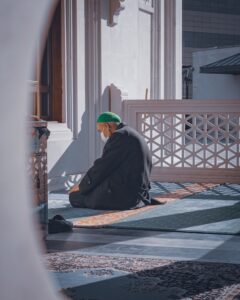
The passport will be checked at the arrival registration counter at airport when arriving in Saudi Arabia, and if the passport has any visa stamps from Israel, it will be deemed invalid.
Additionally, non-Muslims are not allowed to apply for the special Hajj or Umrah visas, which are required to enter Makkah and Medina.
Furthermore, there are checkpoints and barriers set up on the roads leading to Mecca to ensure that only Muslims enter the city.
At these checkpoints, visitors will be asked to show their Hajj or Umrah visas as well as their ID cards, which will indicate their religion.
Additionally, there are officers who will be observing the visitors’ behavior and dress to ensure that they are adhering to Islamic norms and customs.
What if I’m a Tourist Visiting Saudi Arabia?
If you are a non-Muslim tourist visiting Saudi Arabia, you will not be allowed to enter the holy citiy of Makkah. However, you can still visit other parts of the country, such as Madina, Riyadh or Jeddah, and experience the culture and hospitality of the Saudi people.
The government has also started promoting tourism in the country, and there are many tourist attractions that you can visit.
Can a Revert/Converted Muslim Go to Mecca?
Yes, a revert Muslims can of course go to Mecca.
However, it is important to note that the Saudi Arabian government has implemented strict rules and regulations for Hajj and Umrah pilgrims, and you must follow these rules to perform the pilgrimage.
Can a Christian Enter Mecca?
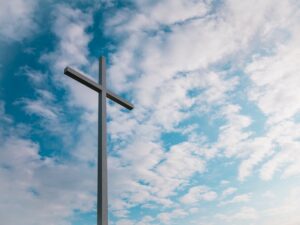
No, Christians are not allowed to enter Mecca. According to Islamic teachings, Christians are considered to be polytheists, and they are not allowed to enter the holy cities.
However, there have been reports of some non-Muslims being allowed to enter the cities for diplomatic or business reasons, but these are rare cases.
Can a Hindu Enter Mecca?
No, Hindus are not allowed to enter Mecca or Medina. Hindus are considered to be idolaters, and according to Islamic teachings, idolaters are not allowed to enter the holy cities.
However, there have been some exceptional cases of Hindus being allowed to enter Mecca for diplomatic or business reasons.
Can a Jew Enter Mecca?
No, Jews are not allowed to enter Mecca. The Saudi Arabian government strictly prohibits non-Muslims from entering the holy city of Mecca, and this includes Jews.
This rule is in place to preserve the sanctity and purity of the holy sites for Muslims and to prevent any potential harm to the religious and cultural identity of the city.
Is There an Age Limit for Hajj?
There is no specific age limit for Hajj, but the pilgrim must be physically and financially capable of performing the journey. However, due to safety concerns, the Saudi government has set the minimum age for performing Hajj at 12 years .
Elderly people and those with underlying health conditions are advised to consult their doctors before embarking on the Hajj journey.
What Happens if a Non-Muslim Enters Mecca?
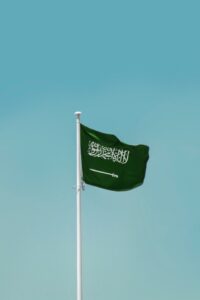
If a Non-Muslim is found entering Mecca, they will be arrested and deported back to their country.
The Saudi government takes the ban on non-Muslims entering Mecca seriously, and violators can face severe punishment, including imprisonment and fines.
Incidents When Non-Muslims Entered Mecca
There have been instances in the past where non-Muslims have entered Mecca. In 1979, a group of armed militants led by Juhayman al-Otaybi took control of the Grand Mosque in Mecca.
The militants were from Saudi Arabia and Yemen, and they believed that the ruling Saudi monarchy had become corrupt and unIslamic.
The Saudi government eventually regained control of the mosque after a two-week siege, during which many people were killed or injured. This incident highlighted the potential security risks that non-Muslims could pose if they were allowed to enter Mecca.
In 2002, an American Jew and TV journalist in Israel named Gil Tamary secretly entered Mecca to record footage for a travelogue.
Despite the strict enforcement of the ban on non-Muslims in Mecca, Tamary managed to gain entry along with only 17 other non-Muslims known to have done so in recent decades.
The incident caused an uproar among Muslims, Israelis, and Westerners alike, as they feared it would increase hostility. The Saudi government pressed criminal charges against Tamary and his Saudi driver.
Tamary later issued an apology and claimed his intention was to highlight the significance of Mecca and the beauty of the religion to promote religious tolerance.
These incidents demonstrate the importance that Muslims place on the sanctity of Mecca and the need for strict measures to prevent non-Muslims from entering the city.
While there may be some curiosity among non-Muslims about what lies inside the holy city, it is important to respect the religious beliefs and practices of others and refrain from attempting to enter Mecca without permission.
Can Non-Muslim Enter Mosques?
Non-Muslims are allowed and welcomed to enter mosques in Saudi Arabia, however the only mosques they are not allowed to enter is Masjid Al Haram and sacred areas around it.
In many Muslim-majority countries, non-Muslims are allowed to enter mosques, although there may be certain restrictions or protocols that they need to follow, such as dress code and behavior. Visitors are often required to remove their shoes and dress modestly, and photography and loud talking may not be allowed.
In some cases, non-Muslims may be allowed to enter mosques but only in certain areas, such as a designated viewing area or the outer courtyard. In other cases, non-Muslims may be allowed to enter the mosque but only during certain times, such as outside of prayer times. But in most cases non Muslims are welcomed to visit mosques.
There are times when some mosques that do not allow non-Muslims to enter at all. This may be because the mosque is considered to be a particularly sensitive or sacred site or because there have been security concerns in the past.
In general, it is recommended that non-Muslims who wish to visit a mosque should be respectful of Islamic customs and traditions. This may include dressing modestly, removing shoes before entering the mosque, and refraining from any behavior that could be seen as disrespectful or disruptive.
Overall, non-Muslims are permitted to enter mosques, unless that mosque is Masjid Al Haram. With proper respect and consideration for Islamic customs and traditions, it is often possible for non-Muslims to visit and appreciate these important cultural and religious sites.
Islam Is Not the Only Religion That Bans/Restricts Access to Holy Sites
It is important to note that Islam is not the only religion that restricts access to certain holy sites. Many religions around the world have similar practices, and it is often done to preserve the sanctity and religious significance of these places.
For example, in Hinduism, non-Hindus are not allowed to enter certain temples.
In addition, there are also many secular restrictions on access to certain areas around the world, such as military zones, national parks, and private property.
Summary – Can Non-Muslims Go to Mecca or Medina?
The bottom line is non-Muslims are generally not allowed to enter Mecca, which are considered the holiest cities in Islam. This is due to the religious significance of these places and the Islamic belief that only Muslims are allowed to enter.
There are strict checkpoints and guidelines in place to ensure that only Muslims are able to enter, and those who attempt to enter without permission may face severe consequences.
However, tourists and visitors to Saudi Arabia are still able to experience the culture and history of the country, and there are many other places to visit and explore.
It is important to be respectful of local customs and traditions and to follow all laws and regulations while visiting the country.
Browse by place

Download our free Ziyarah guides

You may also like
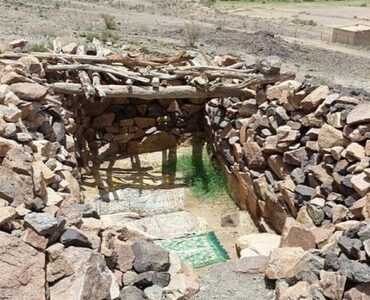
House of Haleemah (رضي الله عنها)
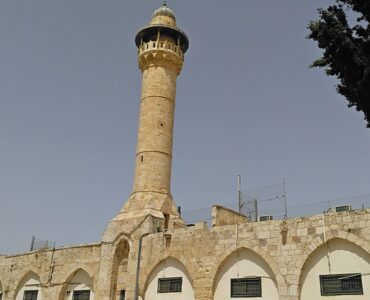
Salahya minaret
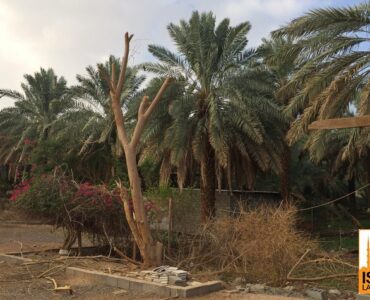
Garden of Salman Farsi (رضي الله عنه)
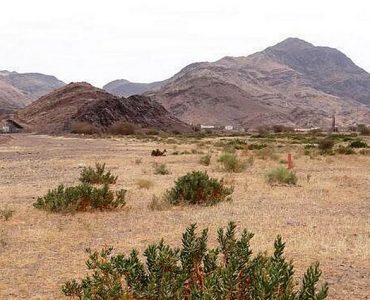
Wadi Dhafiran
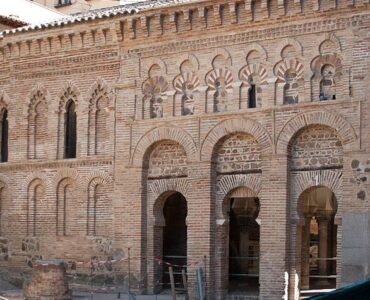
Mezquita del Cristo de la Luz (Bab al-Mardum), Toledo
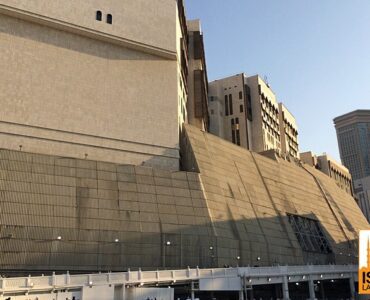
Jabal Abu Qubais (Mount Abu Qubais)
Find answers to over 300 Hajj and Umrah questions
About this site
Please note that some of the places featured on this site cannot be verified for certain. The knowledge of these places has been passed down through the ages and in some cases more than one location make claim to hosting the same historical place. In such instances IslamicLandmarks.com has shown the most commonly believed site. And Allah (ﷻ) knows best.
Our social media channels
If you've benefitted from this website please consider making a donation . It will help us to expand the site and create more functionality which will insha'Allah benefit many others.
Stay up to date and informed on:

0 Visitors since 2020

Featured on

- What is a visa?
- Electronic Visa (eVisa)
- Visa on Arrival
- Appointment Required Visa
- Invitation Letter
- Arrival Card
- Passport Renewal
- Project Kosmos: Meet the man with the world's most challenging travel schedule
- Australia Visa and ETA requirements for US citizens explained
- Brazil eVisa for US citizens
- India Tourist Visa for UK citizens
- Possible B1/B2 Visa questions during the interview
Select Your Language
- Nederlandse
- 中文 (Zhōngwén), 汉语, 漢語
Select Your Currency
- AED United Arab Emirates Dirham
- AFN Afghan Afghani
- ALL Albanian Lek
- AMD Armenian Dram
- ANG Netherlands Antillean Guilder
- AOA Angolan Kwanza
- ARS Argentine Peso
- AUD Australian Dollar
- AWG Aruban Florin
- AZN Azerbaijani Manat
- BAM Bosnia-Herzegovina Convertible Mark
- BBD Barbadian Dollar
- BDT Bangladeshi Taka
- BGN Bulgarian Lev
- BIF Burundian Franc
- BMD Bermudan Dollar
- BND Brunei Dollar
- BOB Bolivian Boliviano
- BRL Brazilian Real
- BSD Bahamian Dollar
- BWP Botswanan Pula
- BZD Belize Dollar
- CAD Canadian Dollar
- CDF Congolese Franc
- CHF Swiss Franc
- CLP Chilean Peso
- CNY Chinese Yuan
- COP Colombian Peso
- CRC Costa Rican Colón
- CVE Cape Verdean Escudo
- CZK Czech Republic Koruna
- DJF Djiboutian Franc
- DKK Danish Krone
- DOP Dominican Peso
- DZD Algerian Dinar
- EGP Egyptian Pound
- ETB Ethiopian Birr
- FJD Fijian Dollar
- FKP Falkland Islands Pound
- GBP British Pound Sterling
- GEL Georgian Lari
- GIP Gibraltar Pound
- GMD Gambian Dalasi
- GNF Guinean Franc
- GTQ Guatemalan Quetzal
- GYD Guyanaese Dollar
- HKD Hong Kong Dollar
- HNL Honduran Lempira
- HTG Haitian Gourde
- HUF Hungarian Forint
- IDR Indonesian Rupiah
- ILS Israeli New Sheqel
- INR Indian Rupee
- ISK Icelandic Króna
- JMD Jamaican Dollar
- JPY Japanese Yen
- KES Kenyan Shilling
- KGS Kyrgystani Som
- KHR Cambodian Riel
- KMF Comorian Franc
- KRW South Korean Won
- KYD Cayman Islands Dollar
- KZT Kazakhstani Tenge
- LAK Laotian Kip
- LBP Lebanese Pound
- LKR Sri Lankan Rupee
- LRD Liberian Dollar
- LSL Lesotho Loti
- MAD Moroccan Dirham
- MDL Moldovan Leu
- MGA Malagasy Ariary
- MKD Macedonian Denar
- MNT Mongolian Tugrik
- MOP Macanese Pataca
- MUR Mauritian Rupee
- MVR Maldivian Rufiyaa
- MWK Malawian Kwacha
- MXN Mexican Peso
- MYR Malaysian Ringgit
- MZN Mozambican Metical
- NAD Namibian Dollar
- NGN Nigerian Naira
- NIO Nicaraguan Córdoba
- NOK Norwegian Krone
- NPR Nepalese Rupee
- NZD New Zealand Dollar
- OMR Omani Rial
- PAB Panamanian Balboa
- PEN Peruvian Nuevo Sol
- PGK Papua New Guinean Kina
- PHP Philippine Peso
- PKR Pakistani Rupee
- PLN Polish Zloty
- PYG Paraguayan Guarani
- QAR Qatari Rial
- RON Romanian Leu
- RSD Serbian Dinar
- RUB Russian Ruble
- RWF Rwandan Franc
- SAR Saudi Riyal
- SBD Solomon Islands Dollar
- SCR Seychellois Rupee
- SEK Swedish Krona
- SGD Singapore Dollar
- SHP Saint Helena Pound
- SLL Sierra Leonean Leone
- SOS Somali Shilling
- SRD Surinamese Dollar
- SVC Salvadoran Colón
- SZL Swazi Lilangeni
- THB Thai Baht
- TJS Tajikistani Somoni
- TOP Tongan Pa anga
- TRY Turkish Lira
- TTD Trinidad and Tobago Dollar
- TWD New Taiwan Dollar
- TZS Tanzanian Shilling
- UAH Ukrainian Hryvnia
- UGX Ugandan Shilling
- USD United States Dollar
- UYU Uruguayan Peso
- UZS Uzbekistan Som
- VND Vietnamese Dong
- VUV Vanuatu Vatu
- WST Samoan Tala
- XAF CFA Franc BEAC
- XCD East Caribbean Dollar
- XOF CFA Franc BCEAO
- XPF CFP Franc
- YER Yemeni Rial
- ZAR South African Rand
- ZMW Zambian Kwacha
We've updated our app!
Download it now
Can you visit Mecca in Saudi Arabia as a tourist?
Mecca, also known as Makkah, located in western Saudi Arabia, is the holiest city in Islam.
More than three million Muslims visit this city during the month of Dhul-Hijjah every year for the Hajj pilgrimage, and many others also make smaller pilgrimages or perform Umrah during other times of the year.
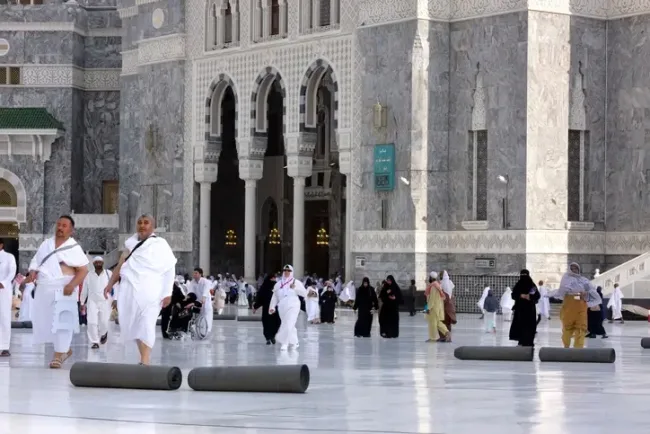
While Mecca is open to tourists, it's important to know that it's limited to Muslim travelers only , and there are other rules and restrictions you must know about before you go. Let's dive in.
Can I travel to Mecca as a tourist?
The simple answer is no, unless you're Muslim .
Non-Muslims are strictly prohibited from entering the holy city of Mecca and certain parts of Medina. Signs indicating these boundaries are clearly signposted, and it's crucial to respect these restrictions.
Rules and restrictions for visiting Mecca as a Muslim tourist
Embarking on a pilgrimage to Mecca, the heart of the Islamic world, is a profoundly spiritual journey that every Muslim aspires to undertake at least once in their lifetime.
Here are the essential rules and restrictions for visiting Mecca as a Muslim tourist , ensuring your spiritual journey is both fulfilling and in complete harmony with the sacred regulations of this holy city:
Pilgrimage eligibility: The pilgrimage to Mecca, known as Hajj, is obligatory for all adult Muslims who are physically and financially capable of undertaking the journey. Additionally, the Umrah, a smaller pilgrimage, can be performed at any time of the year but is not obligatory.
Visa requirements: Pilgrims must obtain a specific visa for Hajj or Umrah from Saudi Arabian embassies or consulates. These visas are issued by Islamic lunar months, with Hajj visas available only during particular periods. Our platform simplifies this process, offering updated information and assistance with your visa application.
Respect for local customs and dress code: Visitors to Mecca are expected to adhere to Islamic principles of conduct and dress modestly. For men, this includes wearing the Ihram during the Hajj, while women should wear clothes that cover the body appropriately and avoid perfume and makeup during the rituals.
Health requirements: Pilgrims must meet certain health criteria to protect themselves and others during their journey. This includes vaccinations, particularly for meningitis, and the Saudi government may require COVID-19 vaccinations. Check the latest info on the government website .
Environmental awareness: The Saudi authorities encourage pilgrims to maintain cleanliness and environmental awareness throughout their journey. Littering or damaging the natural and urban environment of the sacred sites is strictly prohibited.
Safety and security: Given the large crowds, especially during Hajj, it's essential to follow all safety guidelines provided by the authorities. This includes staying with your group, following the designated ritual routes, and securing personal belongings.
Women: Women can register for Hajj without a male guardian if they go in a group with other women.
Photographs: You are not allowed to take photos (still or video, even with your phone) at the Holy Mosque in Mecca or the Prophet's Mosque in Medina. If you break this rule, your device may be taken away.
There may be other rules that you must adhere to, so make sure to stay updated and informed throughout the process of traveling to Mecca.
How does the Saudi government check if you're Muslim to visit Mecca?
Saudi Arabia's government restricts entry to Mecca to Muslims only . Proof of your religious beliefs will be checked upon entry, and anyone not showing proof of being Muslim will be denied access.
This check can include:
- You may be asked to present documentation from an imam (Muslim religious leader)
- You may be asked to submit your documentation from your imam upon booking your trip (especially important if you're a converted Muslim traveler)
- You may be asked to say the Shahada and be asked about your knowledge of Islam
- Some countries offer ID cards that include the holder's religion, which is accepted as proof
What happens when non-Muslims try to enter Mecca?
While it's not only incredibly disrespectful, it's also not a good idea as you're trespassing and breaking Saudi Arabian laws.
The penalty for non-Muslims attempting to enter is deportation from the country and a possible fine. This rule applies whether you're trying to enter the city by plane, car, bus, or train.
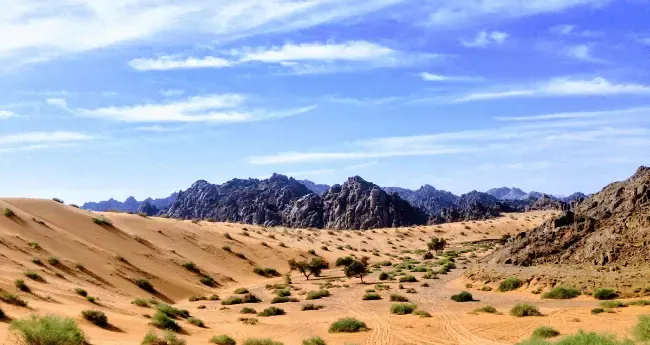
Do you need a visa to visit Mecca in Saudi Arabia?
The visa requirements depend on your nationality , even if you can proof you're Muslim. The various visas include:
Saudi Arabia Tourist eVisa : This electronic visa allows Muslim travelers from certain nationalities to visit the country for their Umrah pilgrimage. However, some restrictions apply, such as being unable to take holy water home.
Saudi Arabia Tourist Visa (paper visa): If you're not eligible for the eVisa, you must apply for a traditional Tourist Visa from the nearest Saudi Embassy or Consulate .
Saudi Arabia Umrah Visa : This is a special visa for Umrah pilgrims. While it involves more required documents, you have more freedom within the Umrah privileges.
Saudi Arabia Hajj Visa: This is a special visa for Hajj pilgrims. A trip and accompanying visa must be booked through a government-approved travel agency .
Hajj visas are assigned to countries on a quota basis according to the number of Muslims that live there. In recent years, additional restrictions have been placed on those who have previously been to Mecca to avoid overcrowding.
- [Saudi Arabia Electronic Visa Waiver]: At the time of writing, this visa waiver was only available to travelers from the United Kingdom, and allows Muslims to perform Umrah.
More questions about traveling to Mecca in Saudi Arabia?
If you want to learn more about the Saudi Arabia visas or have questions about the application process, we’re here to help. Our dedicated online team of customer service agents is available via online chat to assist with any questions, or you can contact us on WhatsApp .
Related Articles
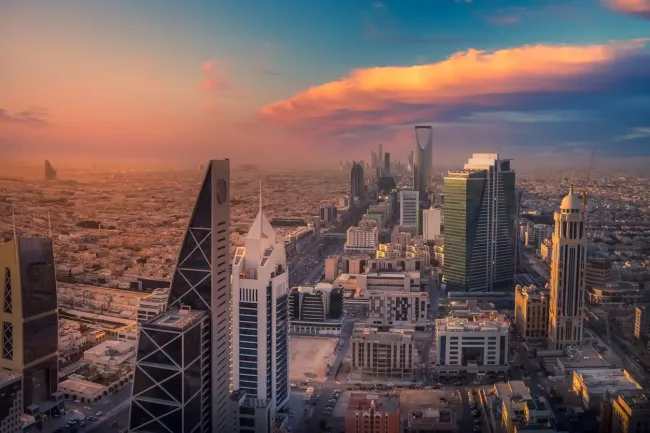
Saudi Arabia Visa status: Track your application
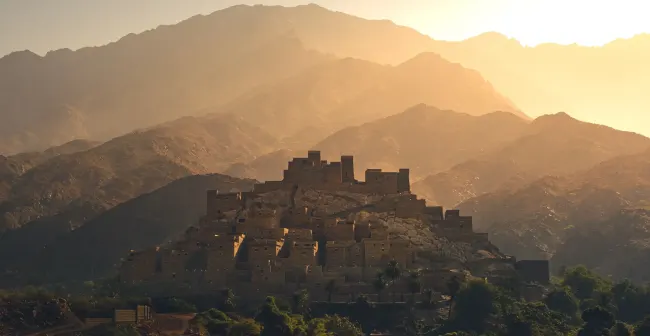
How to get the Saudi Arabia eVisa or visa waiver as a UK citizen
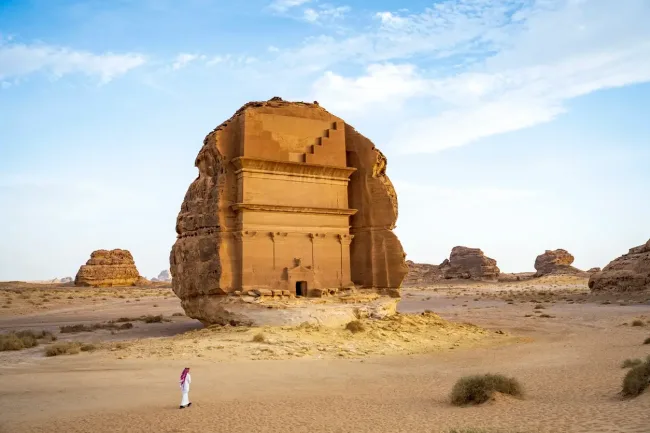
Saudi Arabia Tourist Visa for Pakistani Citizens: Apply for your visa now
- iVisa is NOT affiliated with any government agency. This site does not provide legal advice and we are not a law firm. None of our customer service representatives are lawyers and they also do not provide legal advice. We are a private, internet-based travel and immigration consultancy provider dedicated to helping individuals travel around the world. You may apply by yourself directly on the various government websites. The source of information: https://www.saudiembassy.net/visa-types

IMAGES
VIDEO
COMMENTS
The purest place in the world, and the city that embraces the qiblah of Muslims. Learn about its ancient history, its great Islamic status, ways to reach it, and the best seasons to visit it to see its many historical and Islamic landmarks.
Mecca, officially known as Makkah al-Mukarramah (Arabic: مكة المكرمة, Makkah al-Mukarramah), is a city in Saudi Arabia and the holiest city in Islam.. Mecca is the birthplace of Prophet Muhammed, the founder of Islam, and Muslims believe the Qur'an was first revealed to Muhammad here.The Great Mosque of Mecca, known as Masjid al-Haram is considered to be Islam's most sacred mosque ...
2023. 1. Great Mosque of Mecca. 1,347. Points of Interest & Landmarks. The Sacred Mosque, stands majestically in the heart of Mecca, Saudi Arabia, serving as the focal point for millions of Muslims who embark on the sacred pilgrimages of Umrah and Hajj. This bio explores the significance of Masjid al-Haram and the services provided for pilgrims ...
Mecca: Kaaba. The Kaaba (Kaʿbah) surrounded by pilgrims during the hajj, Mecca, Saudi Arabia. The cube-shaped structure (the word kaʿbah means "cube" in Arabic) is roughly 50 feet (15 meters) high, and it is about 35 by 40 feet (10 by 12 meters) at its base. Constructed of gray stone and marble, it is oriented so that its corners roughly ...
Mecca (/ ˈ m ɛ k ə /; officially Makkah al-Mukarramah, commonly shortened to Makkah) is the capital of Mecca Province in the Hejaz region of western Saudi Arabia and the holiest city in Islam. It is 70 km (43 mi) inland from Jeddah on the Red Sea, in a narrow valley 277 m (909 ft) above sea level.Its last recorded population was 2,385,509 in 2022. Its metropolitan population in 2022 is 2.4 ...
Mecca, Saudi Arabia. The Ka'aba (literally "the cube" in Arabic) is an ancient stone structure that was built and re-built by prophets as a house of monotheistic worship. It is located in the interior courtyard of the Grand Mosque. The Ka'aba is considered the center of the Muslim world, and is a unifying focal point for Islamic worship.
Tourist Places to Visit in Mecca. Great Mosque of Mecca - Masjid al-Haram, Kaaba, Jabal Al Nour, Abraj Al-Bait Tower, City of Mina, Makkah Museum, Mount Arafat, Jamaraat Bridge, Clock Tower Museum Mecca, Masjid Ayesha Miqat, Elephant Rock Mecca, and many more. If you are planning to go on a Hajj or Umrah pilgrimage or just wish to vacation in ...
The Great Mosque, Mecca. Mecca (Makkah in Arabic) is the center of the Islamic world and the birthplace of both the Prophet Muhammad and the religion he founded.Located in the Sarat Mountains of central Saudi Arabia and 45 miles inland from the Red Sea port of Jidda (Jeddah), ancient Mecca was an oasis on the old caravan trade route that linked the Mediterranean world with South Arabia, East ...
Mecca is situated at an elevation of 909 feet (277 metres) above sea level in the dry beds of the Wadi Ibrāhīm and several of its short tributaries. It is surrounded by the Ṣirāt Mountains, the peaks of which include Mount (Jabal) Ajyad, which rises to 1,332 feet, and Mount Abū Qubays, which attains 1,220 feet, to the east and Mount Quʿayqʿān, which reaches 1,401 feet, to the west.
Mecca. Saudi Arabia, Middle East. Mecca is only accessible by Muslims, who often describe the moment they first lay eyes on the city's sacred Kaaba as an overwhelmingly emotional experience. For those living outside the Kingdom, a visit to Mecca - generally spelt 'Makkah' by Muslims and in Saudi Arabia - is a lifelong dream.
The central spot in the world for all Muslims, Mecca is a city that's always closed for non-believers. In fact, traveling there as a Christian is punishable by law, and transgressors are promptly fined and deported. However, there are certain details even Muslim visitors should know before coming to the holiest site of Islam. 1.
Discover the Makkah Province, the heart of Islam and the birthplace of Prophet Muhammad. Explore the sacred city of Makkah, the historical sites of Jeddah, and the natural wonders of Taif. Learn how to plan your trip, get your eVisa, and experience the culture and heritage of Saudi Arabia.
Mecca is a city of terrific importance in Islamic tradition. It is a center of pilgrimage and prayer -- a sacred place where Muslims are free from the distractions of daily life. Only Muslims are allowed to visit the holy city of Mecca and enter its inner sanctum, the birthplace of the Prophet Muhammad and Islam.
According to travel writers, such as the Ibn Jubayr, who saw the Kaaba in 1183, it retained the eighth century Abbasid form for several centuries. From 1269-1517, the Mamluks of Egypt controlled the Hijaz, the highlands in western Arabia where Mecca is located. ... Only Muslims may visit the holy cities of Mecca and Medina today. Khan Academy ...
Great Mosque of Mecca, mosque in Mecca, Saudi Arabia, built to enclose the Kaʿbah, the holiest shrine in Islam.As one of the destinations of the hajj and ʿumrah pilgrimages, it receives millions of worshippers each year. The oldest parts of the modern structure date to the 16th century. The mosque, which comprises a rectangular central courtyard surrounded by covered prayer areas, is the ...
How the holy city has changed over the past 100 years. As the sun rises over Mecca on Sunday July 18, up to 60,000 pilgrims dressed in customary white robes called Ihram will begin their five-day long spiritual journey to seek forgiveness for past sins and start anew before God. The Hajj is is one of the five pillars of Islam and a once-in-a ...
A pilgrimage to Mecca, known as the Hajj, is one of the Five Pillars of Islam, and it is obligatory for all Muslims with the physical and financial ability to make it.Over three million Muslims visit the city during the month of Dhu'l-Hijjah yearly. Visits outside this month are known as minor pilgrimages or Umrah, and while not compulsory, they are strongly encouraged.
At this moment in mid-August, 1.5 million people from dozens of countries around the world are in Mecca, Saudi Arabia, to perform the hajj, the Islamic religious pilgrimage. It's a huge event ...
The Road to Mecca According to the Islamic faith, the Hajj is made in response to God's call and in compliance with his commands to Ibrahim, who, as soon as he finished building the Kaaba, God commanded him to call the people to perform Hajj and urged them to visit his sacred house, in accordance with the Almighty's saying in the Qur'an:
The following requirements to travel to the Mecca are quite , such as being healthy and being an adult, means mature, in order to understand the meaning of the pilgrimage to Mecca. In addition, the believer must be free and be able to make the pilgrimage without any problem at all. Another group of the requirements to travel to Mecca is of a ...
When the question arises, ' Can non-Muslims go to Mecca ' the answer is No. Non-Muslims are not allowed to enter the holy cities of Mecca in Saudi Arabia. The reasons for this restriction are deeply rooted in the Islamic faith and history. Mecca and Medina are considered the holiest cities in Islam and are revered by Muslims worldwide.
hajj, in Islam, the pilgrimage to the holy city of Mecca in Saudi Arabia, which every adult Muslim must make at least once in his or her lifetime.The hajj is the fifth of the fundamental Muslim practices and institutions known as the Five Pillars of Islam.The pilgrimage rite begins on the 7th day of Dhū al-Ḥijjah (the last month of the Islamic year) and ends on the 12th day.
Mecca, also known as Makkah, located in western Saudi Arabia, is the holiest city in Islam . More than three million Muslims visit this city during the month of Dhul-Hijjah every year for the Hajj pilgrimage, and many others also make smaller pilgrimages or perform Umrah during other times of the year.